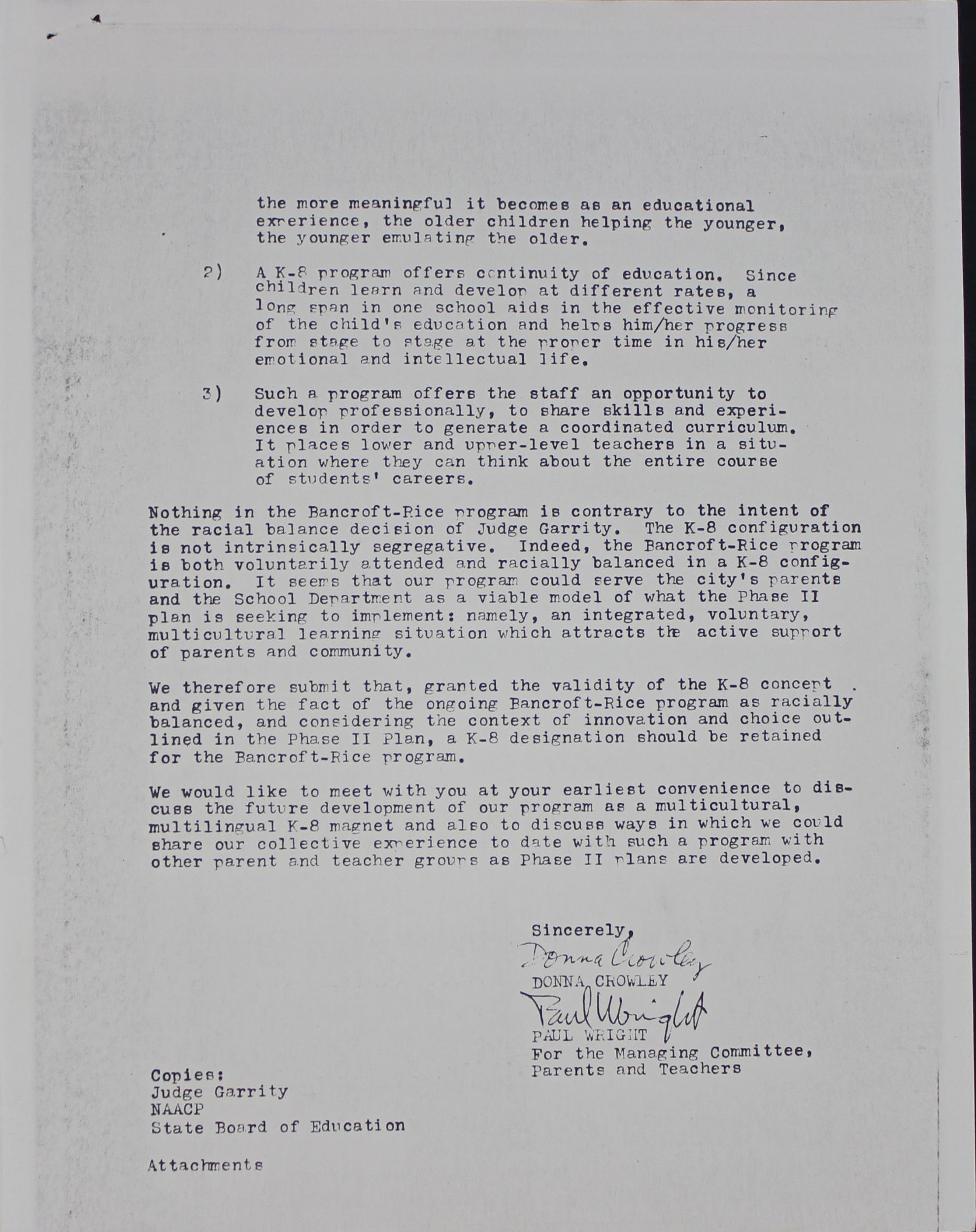An Introduction to Morgan v. Hennigan
Making Connections
All documents and text associated with this activity are printed below, followed by a worksheet for student responses.Introduction
In 1973, parents of several black students in Boston sued the Boston School Committee for discriminating against their children through segregation policies. Judge Arthur Garrity decided with the parents, agreeing that the committee violated the 14th amendment which gave equal protection under the law to all students in public schools. Due to resistance to change, the Judge ordered busing and desegregation policies to begin in the city of Boston. Anger from the decision created an atmosphere of racial tension, where students and teachers became threatened by oppression and violence where the police were unable or unwilling to provide security. The case challenged ideas of equality and education in the United States. Read each document carefully in the exercise.Name:
Class:
Class:
Worksheet
An Introduction to Morgan v. Hennigan
Making Connections
Examine the documents and text included in this activity. Fill in any blanks in the sequence with your thoughts and write your conclusion response in the space provided.The following documents show the beginnings of the case. Look through each document carefully and try to find the most important parts. What do the plaintiffs (or the parents) want? What do you think the attitude of the Boston School Committee is? Does this seem to be the first act of discrimination or is there a pattern of inequality here?
Tallulah Morgan et al. v. James W. Hennigan et al. Complaint
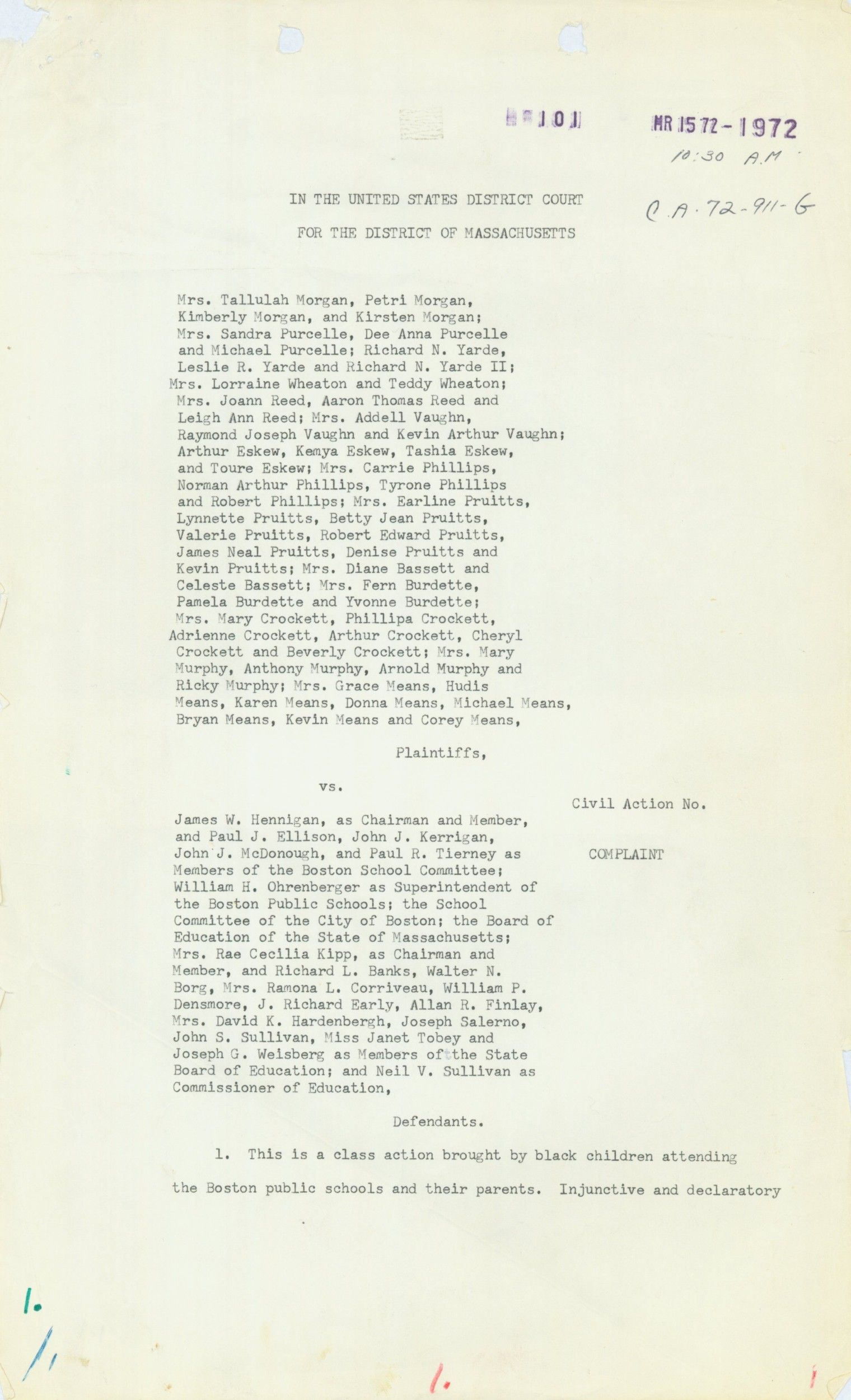
Chronology Stipulation
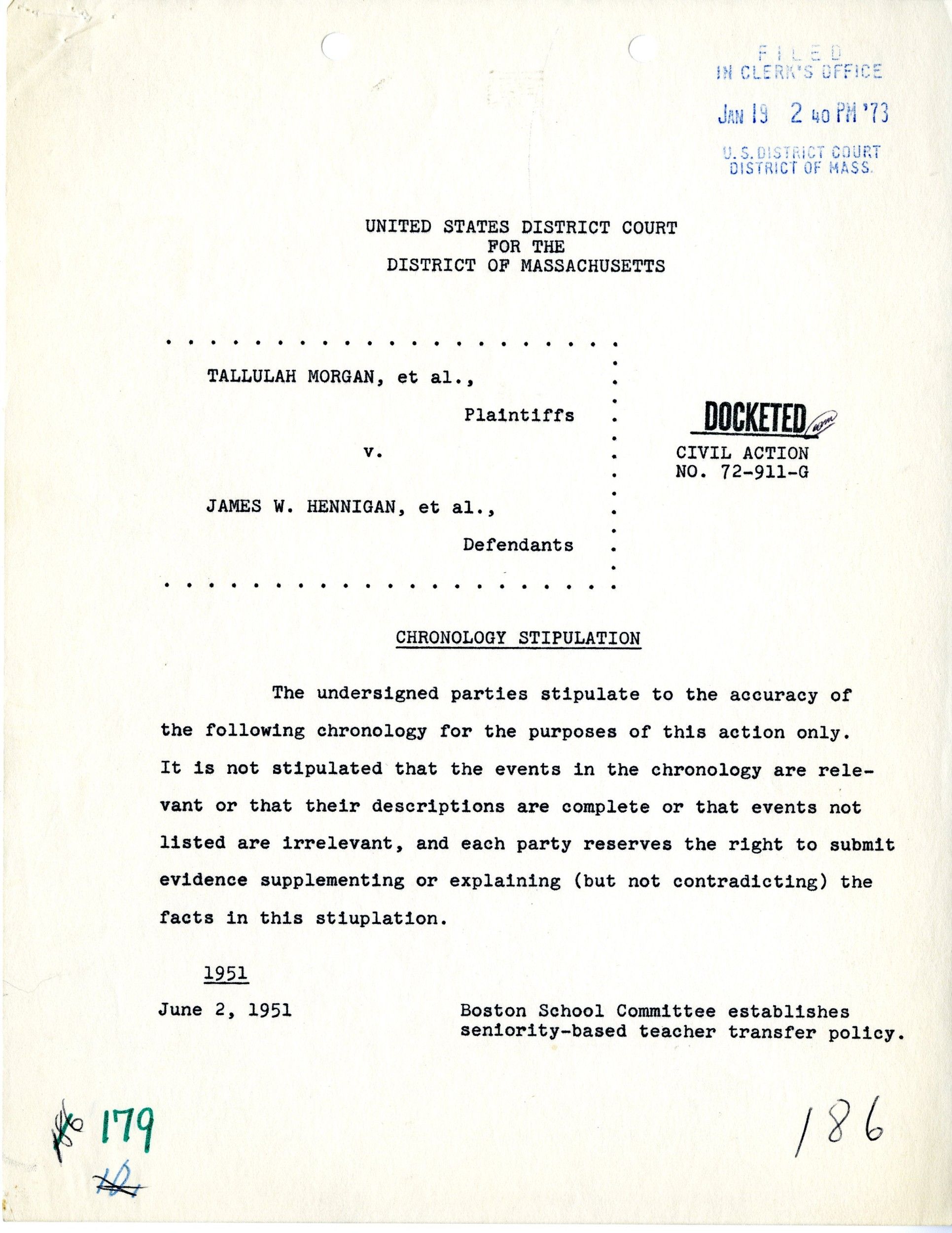
Plaintiff's Brief on Neighborhood Schools

The desegregation of the Boston public schools was met with violence and discrimination. Look at the following documents and read the stories of different people: How was discrimination and violence perpetrated and who perpetrated it? What was the reaction and how did individuals stand up against this discrimination?
Letter and Summary Report of Incidents of Intimidation of Teachers during the Desegregation of South Boston High School and the Abrahams School

Western Union Mailgram Sent to Governor Francis Sargent from Residents of the Columbia Point Housing Project
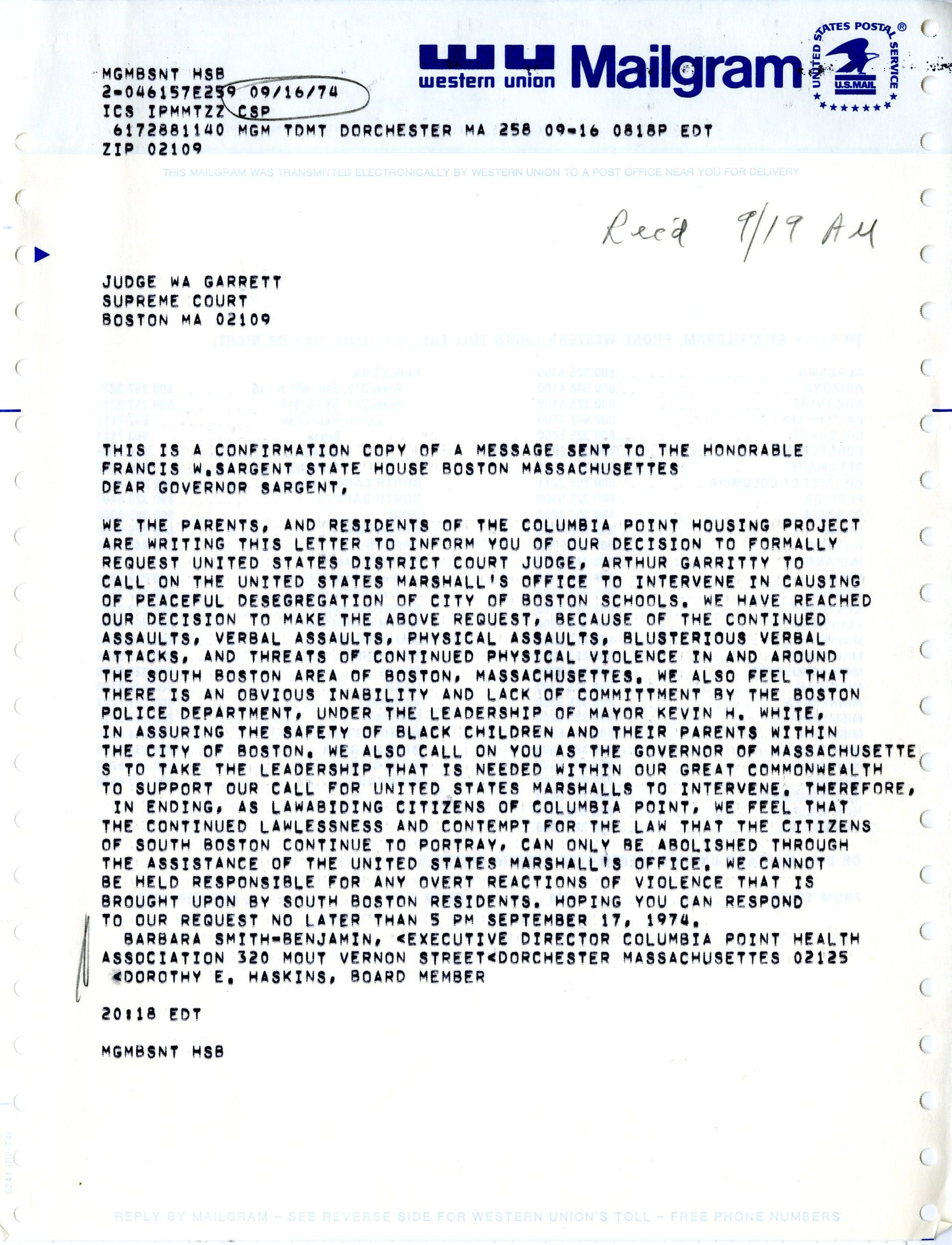
Plaintiff's Second Motion to Impound

In a lawful society, there is always a discussion to be had about the use of the police and their role in daily life. Yet in the context of this case and Boston of the 1970's, many individuals believed that the police did not provide adequate protection or even were encouraging the violence and tension in Boston. Looking at the documents, do you think the police provided adequate safety? Why was the federal or state government not willing to help? How did the protection of the police affect the policy of desegregation?
Memorandum of the United States Regarding Deployment of United States Marshals in Boston Public Schools
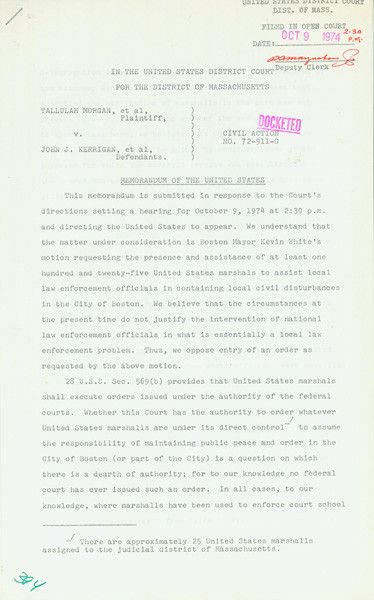
Memorandum to the Court of the Inadvisability of the Use of National Guard Forces in the Event of Urban Civil Disorders and Unrest

Memorandum Regarding Deployment of Police for South Boston
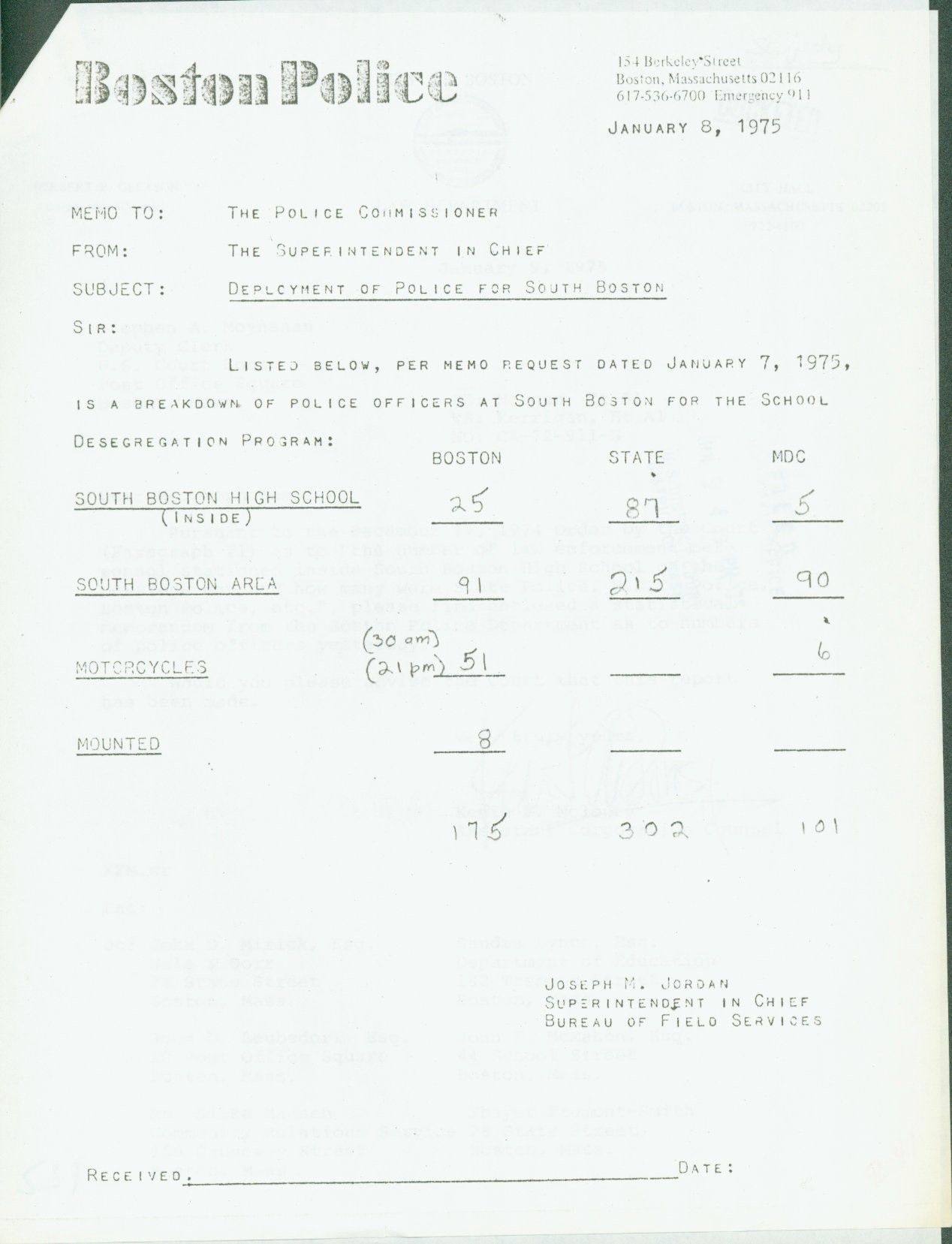
Letter from Kevin Moloney, Assistant Corporation Counsel for the City of Boston, to Judge W. Arthur Garrity
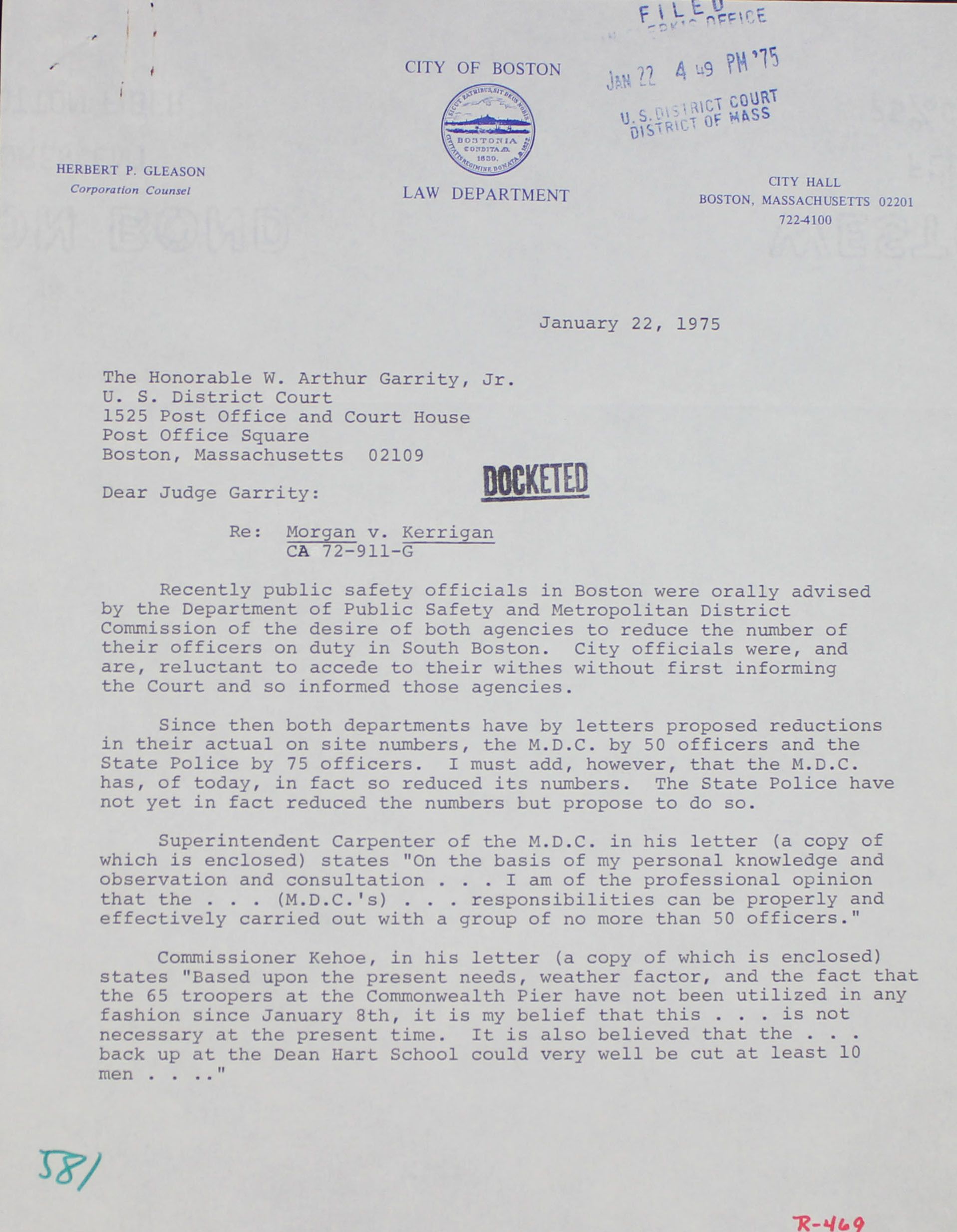
This case also reflects the theme of education in America. The following documents talk about reaction to desegregation and the violence that exsisted at time in schools. How does busing and desegregation become part of a discussion about education goals? What do these reactions tell you about effects of desegregation and the ability of all people in Boston to acheive equality?
Letter from Mrs. Sumner Bernstein to Boston Public Schools Superintendent Leary Regarding her Daughter's Experience at Boston English
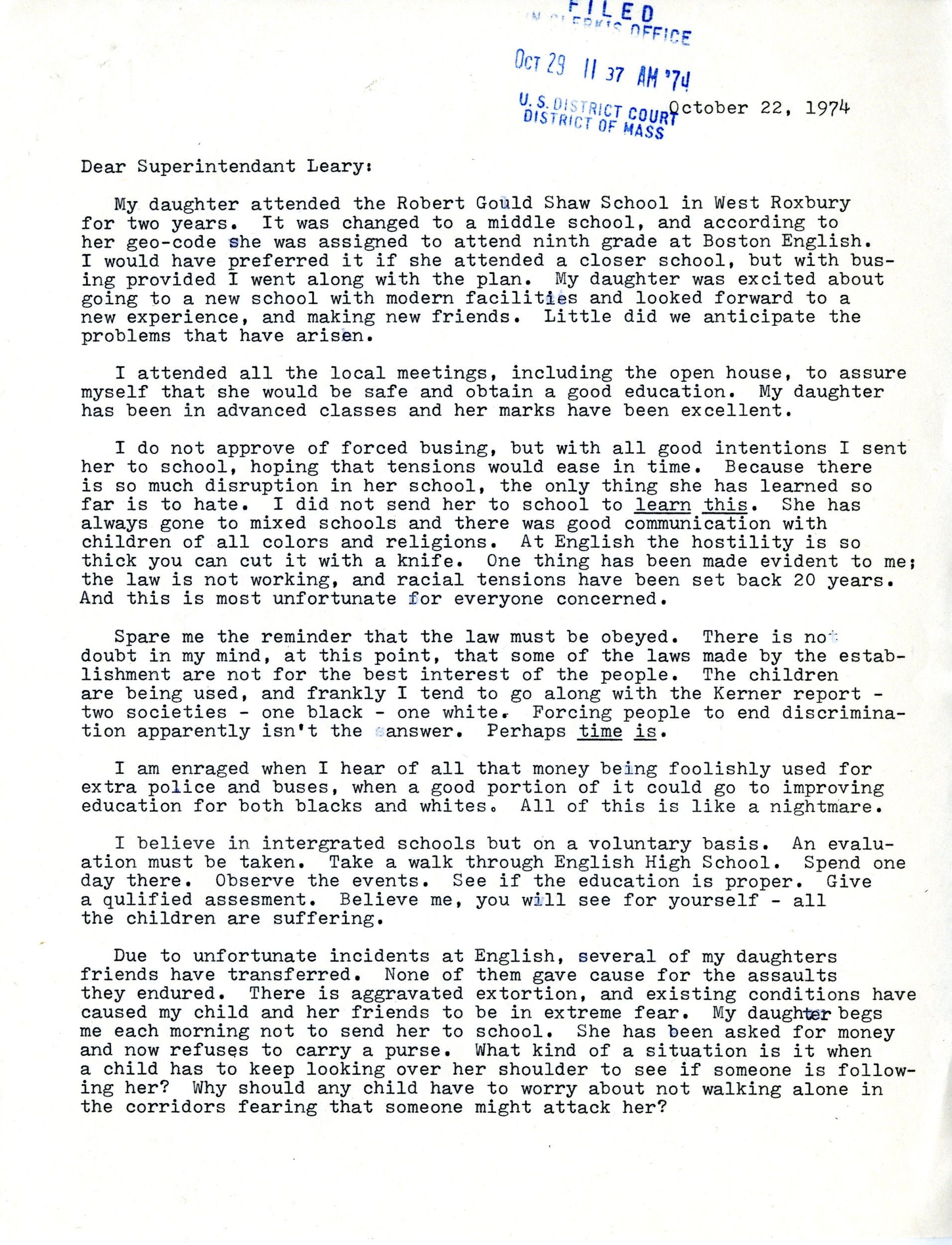
Letter from State Representative Raymond Flynn to Judge W. Arthur Garrity
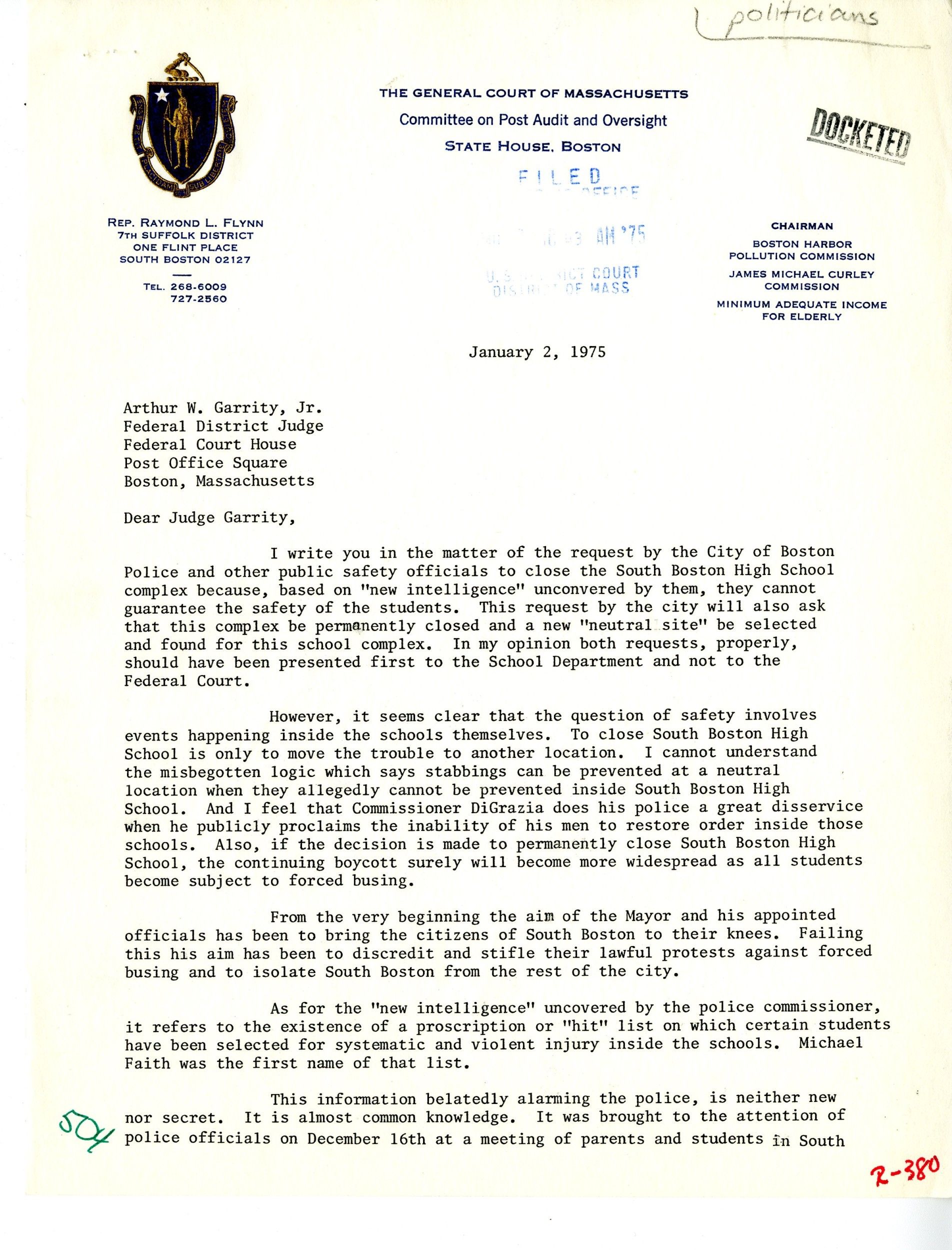
The case of Mrogan v. Hennigan had many effects across the city of Boston. The next documents provide examples of attempted school integration, the changing of positions in the Boston School Committee, and a demand for further help from teachers. All these show different avenues of fighting the violence and oppression that exsisted in Boston at the time. How do you think people at the time felt about these changes? How were they necessary to create a more unified and equal city? Looking at the last document, do you see a possible way for integration to exsist?
Order of Substitution
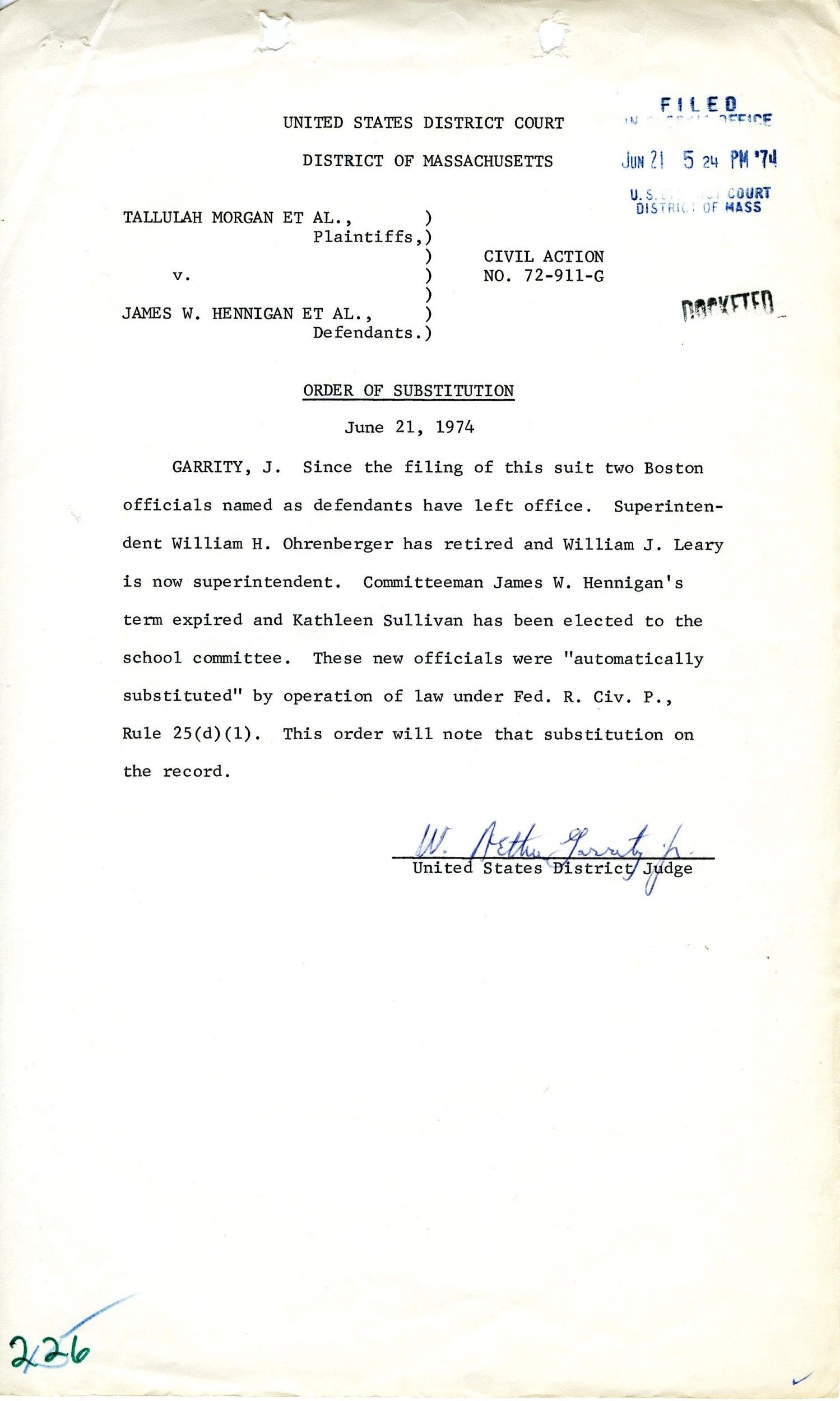
Teachers Union's Request for Discussion of and Reports on Intramural Security, Race And Community Relations

Letter of Parents of the Bancroft Rice School to Judge Arthur Garrity Responding to Phase II of the School Desegregation Plan
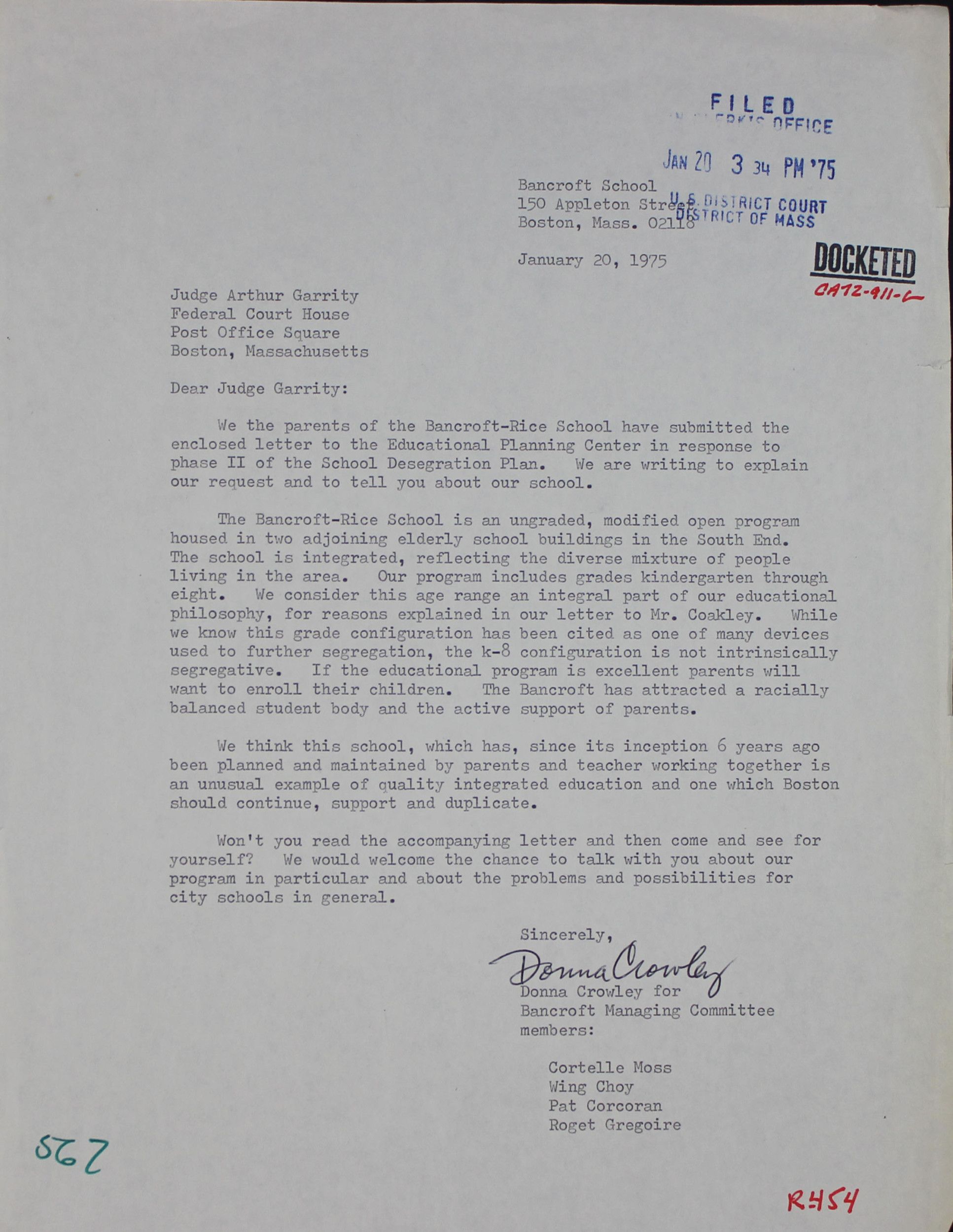
1
Activity Element
Tallulah Morgan et al. v. James W. Hennigan et al. Complaint
Page 1

2
Activity Element
Chronology Stipulation
Page 1

3
Activity Element
Plaintiff's Brief on Neighborhood Schools
Page 1

4
Activity Element
Letter and Summary Report of Incidents of Intimidation of Teachers during the Desegregation of South Boston High School and the Abrahams School
Page 1

5
Activity Element
Western Union Mailgram Sent to Governor Francis Sargent from Residents of the Columbia Point Housing Project
Page 1

6
Activity Element
Plaintiff's Second Motion to Impound
Page 1

7
Activity Element
Memorandum of the United States Regarding Deployment of United States Marshals in Boston Public Schools
Page 1

8
Activity Element
Memorandum to the Court of the Inadvisability of the Use of National Guard Forces in the Event of Urban Civil Disorders and Unrest
Page 1

9
Activity Element
Memorandum Regarding Deployment of Police for South Boston
Page 1

10
Activity Element
Letter from Kevin Moloney, Assistant Corporation Counsel for the City of Boston, to Judge W. Arthur Garrity
Page 1

11
Activity Element
Letter from Mrs. Sumner Bernstein to Boston Public Schools Superintendent Leary Regarding her Daughter's Experience at Boston English
Page 1

12
Activity Element
Letter from State Representative Raymond Flynn to Judge W. Arthur Garrity
Page 1

13
Activity Element
Order of Substitution
Page 1

14
Activity Element
Teachers Union's Request for Discussion of and Reports on Intramural Security, Race And Community Relations
Page 1

15
Activity Element
Letter of Parents of the Bancroft Rice School to Judge Arthur Garrity Responding to Phase II of the School Desegregation Plan
Page 1

Conclusion
An Introduction to Morgan v. Hennigan
Making Connections
Using your knowledge and examples from the documents, answer the following questions:- What was the effect of violence upon desegregation in Boston? What role did different branches of the government play to help or hinder the cause of those fighting for desegregated schools?
- What events and parts of the case do you see as a success for Civil Rights? How about a failure?
- How does this case fit into the broader context of Civil Rights? Specifically, how does it contrast Civil Rights cases you have heard about? How does it challenge your views of legal and social equality?
Your Response
Document
Tallulah Morgan et al. v. James W. Hennigan et al. Complaint
3/15/1972
This complaint initiated the civil action case of Tallulah Morgan et al. v. James W. Hennigan et al., also known as the Boston Schools Desegregation Case.
In 1972, parents of African American children brought a class action lawsuit alleging that the Boston School Committee violated the 14th Amendment of the U.S. Constitution by a deliberate policy of racial segregation. Judge W. Arthur Garrity, Jr. found that the Boston School Committee had intentionally carried out a program of segregation in the Boston Public Schools.
The ruling, upheld unanimously by the U.S. Court of Appeals for the First Circuit, ordered the Boston School Committee to formulate a permanent school desegregation plan that addressed student assignment, teacher employment, and facility improvement procedures, as well as the use of busing on a citywide basis. The Boston School Committee failed to present an adequate plan, so the court assumed an active role in the formulation of the desegregation plan and oversaw implementation of court-ordered desegregation in the Boston public schools.
In 1972, parents of African American children brought a class action lawsuit alleging that the Boston School Committee violated the 14th Amendment of the U.S. Constitution by a deliberate policy of racial segregation. Judge W. Arthur Garrity, Jr. found that the Boston School Committee had intentionally carried out a program of segregation in the Boston Public Schools.
The ruling, upheld unanimously by the U.S. Court of Appeals for the First Circuit, ordered the Boston School Committee to formulate a permanent school desegregation plan that addressed student assignment, teacher employment, and facility improvement procedures, as well as the use of busing on a citywide basis. The Boston School Committee failed to present an adequate plan, so the court assumed an active role in the formulation of the desegregation plan and oversaw implementation of court-ordered desegregation in the Boston public schools.
This primary source comes from the Records of District Courts of the United States.
National Archives Identifier: 4713867
Full Citation: Tallulah Morgan et al. v. James W. Hennigan et al. Complaint; 3/15/1972; Tallulah Morgan et al v. James W. Hennigan et al Case File; Civil Action Case Files, 1938 - 1998; Records of District Courts of the United States, ; National Archives at Boston, Waltham, MA. [Online Version, https://www.docsteach.org/documents/document/morgan-complaint, April 18, 2024]Tallulah Morgan et al. v. James W. Hennigan et al. Complaint
Page 1
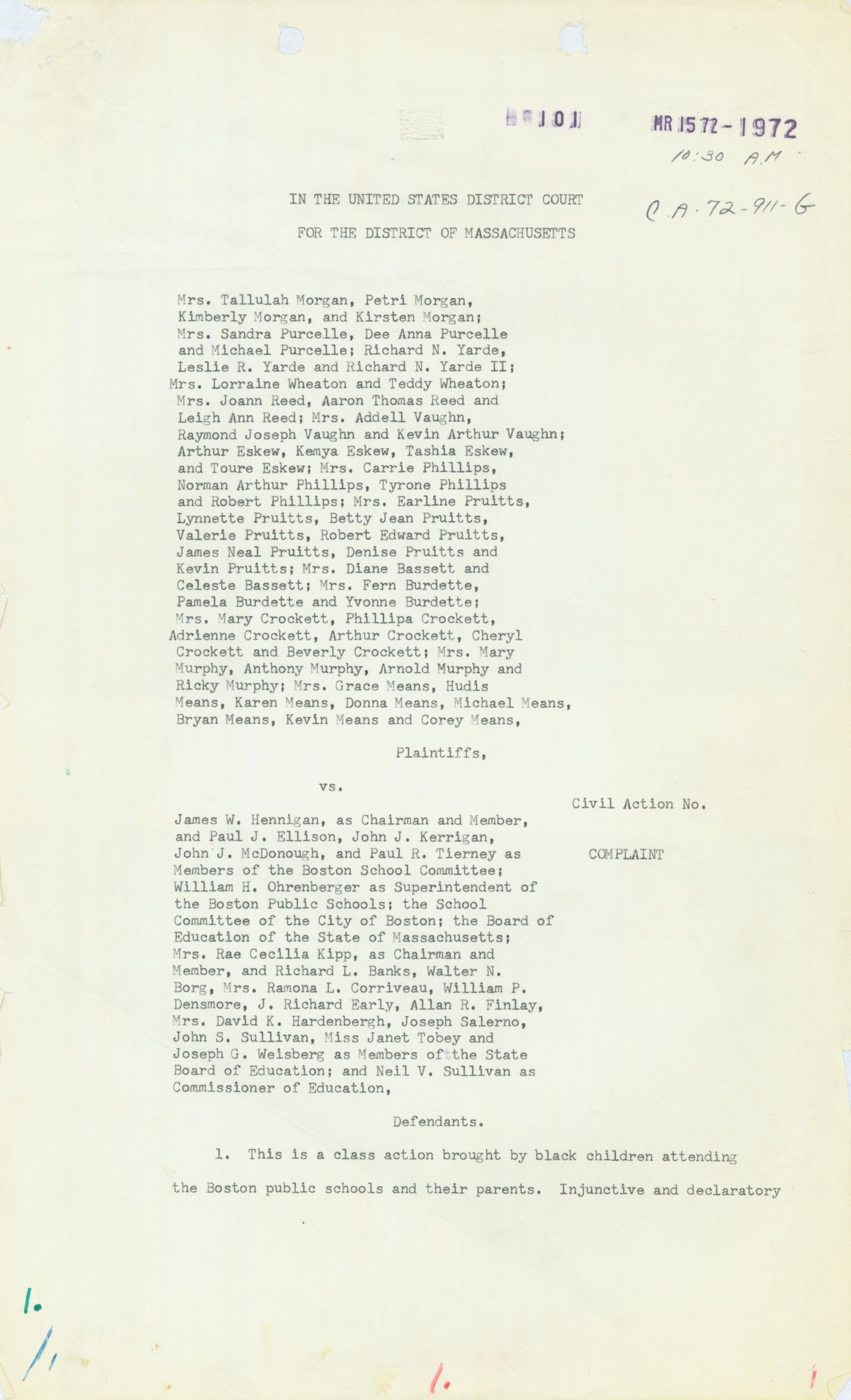
Tallulah Morgan et al. v. James W. Hennigan et al. Complaint
Page 2
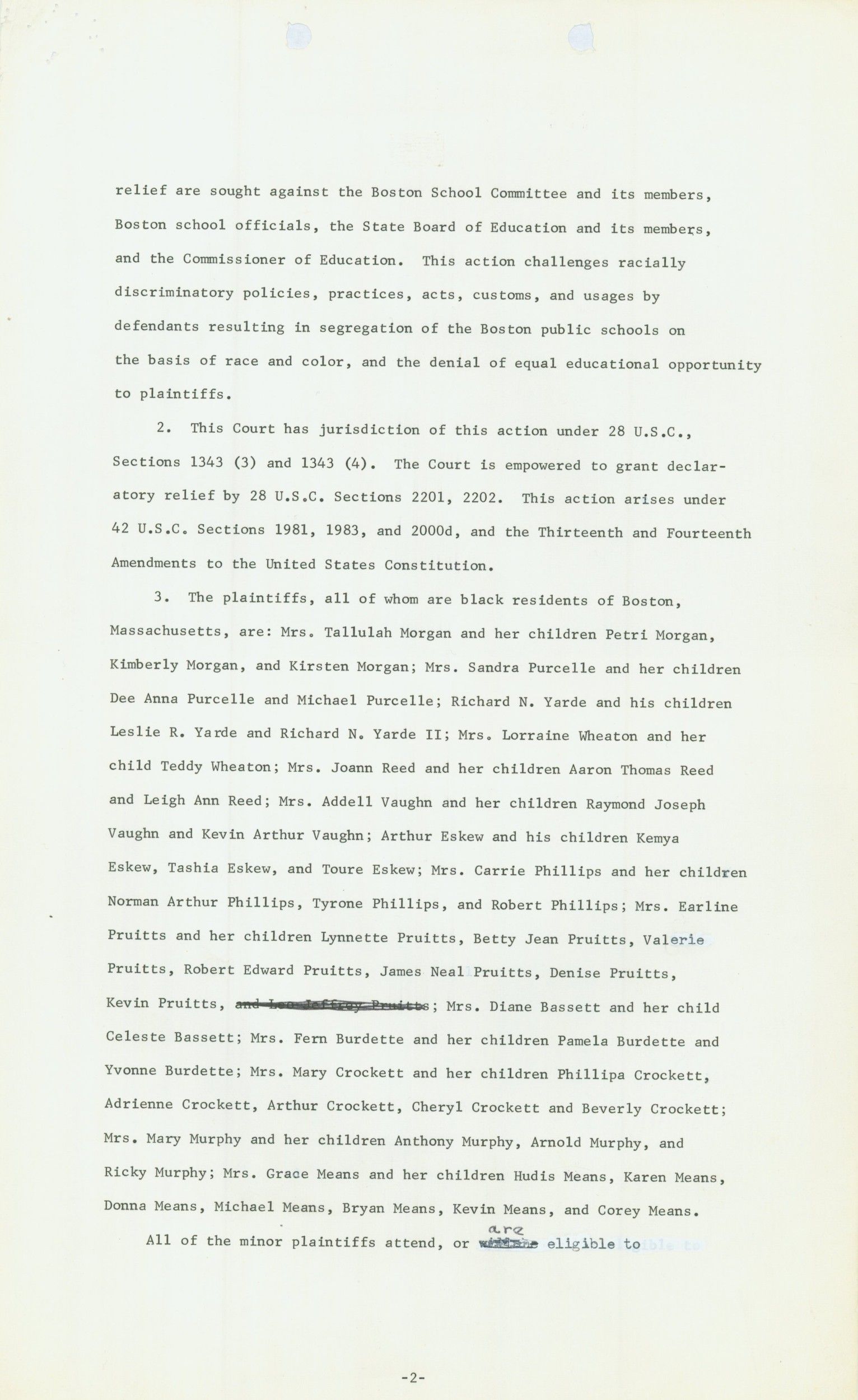
Tallulah Morgan et al. v. James W. Hennigan et al. Complaint
Page 3
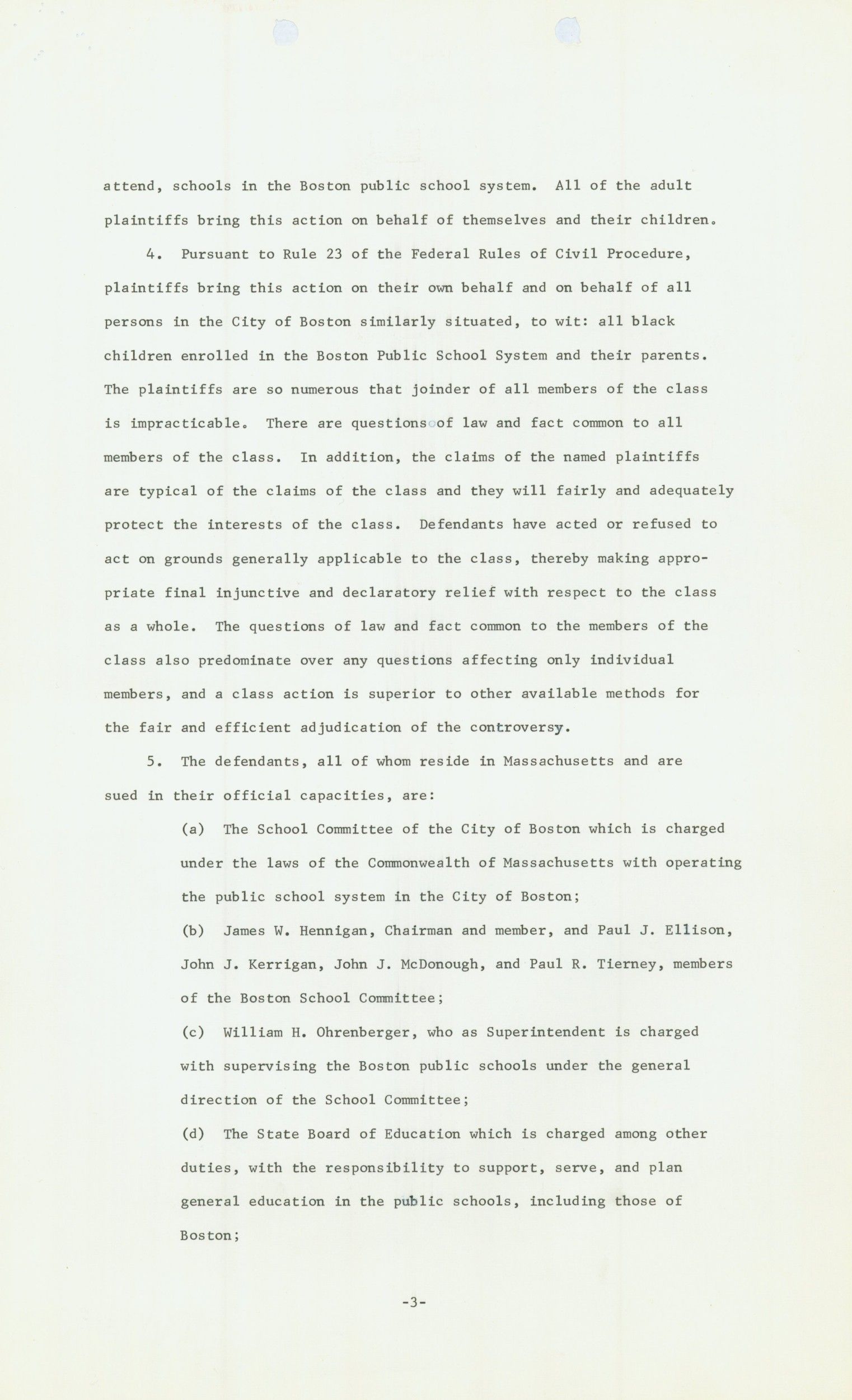
Tallulah Morgan et al. v. James W. Hennigan et al. Complaint
Page 4
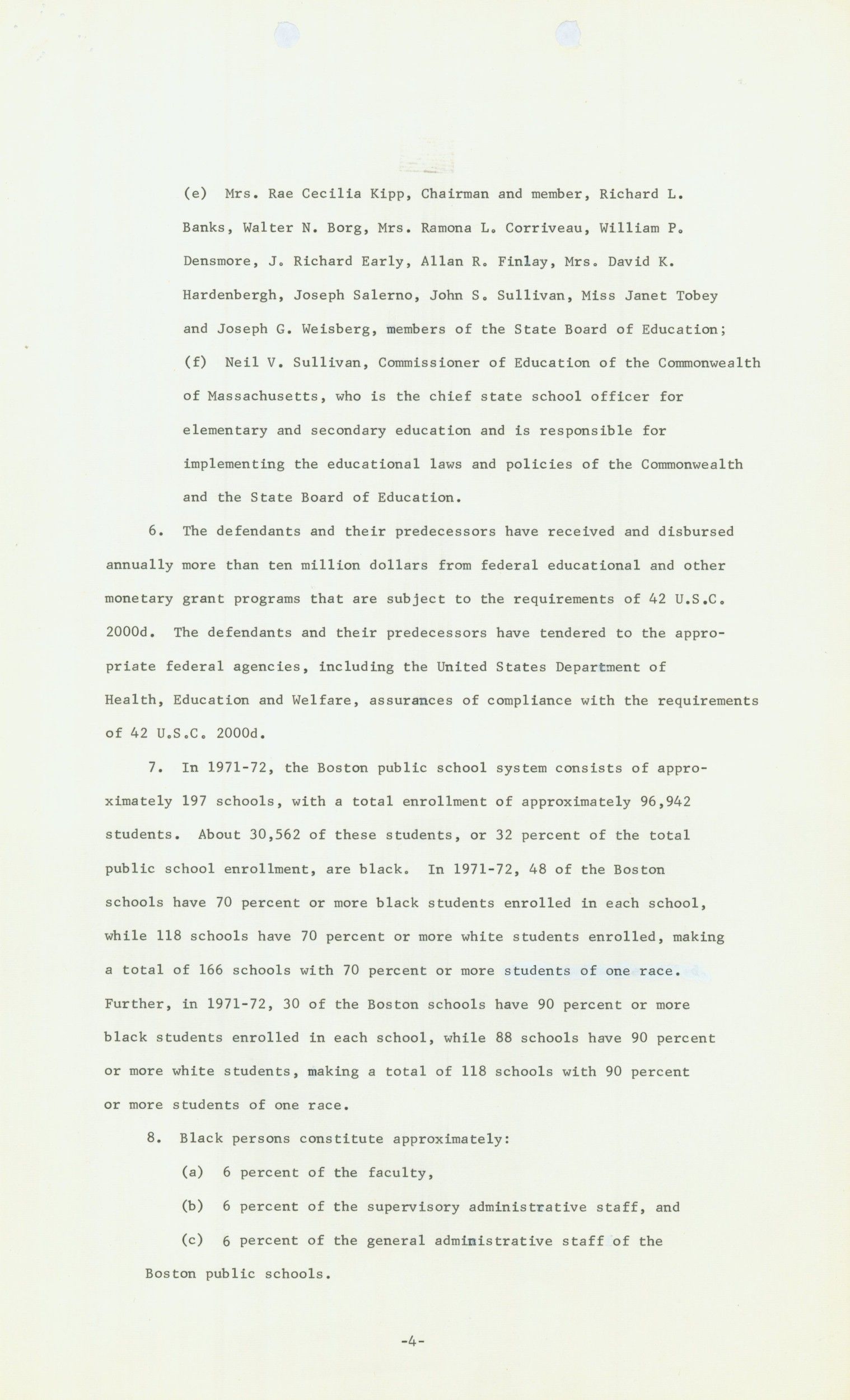
Tallulah Morgan et al. v. James W. Hennigan et al. Complaint
Page 5

Tallulah Morgan et al. v. James W. Hennigan et al. Complaint
Page 6

Tallulah Morgan et al. v. James W. Hennigan et al. Complaint
Page 7
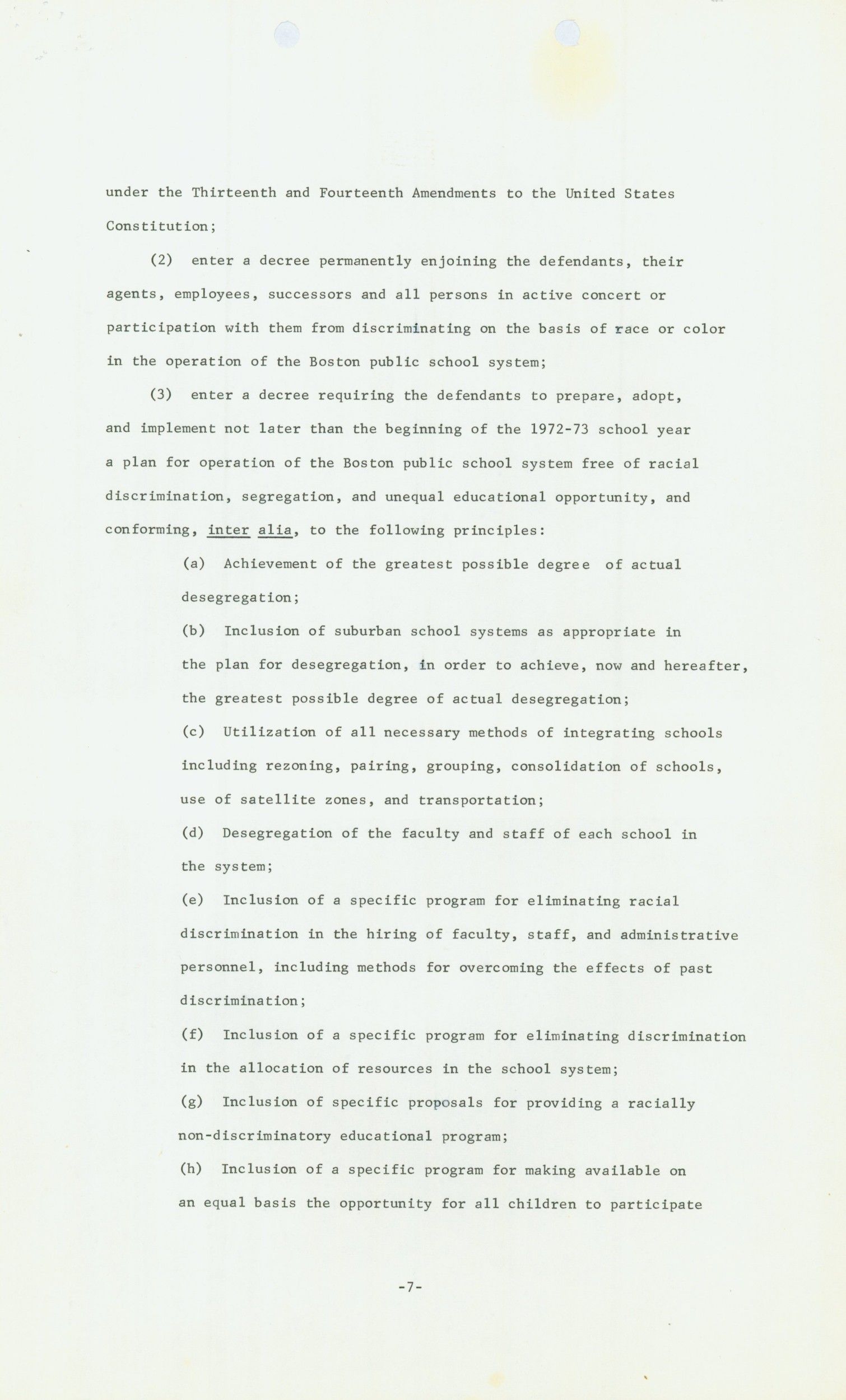
Tallulah Morgan et al. v. James W. Hennigan et al. Complaint
Page 8
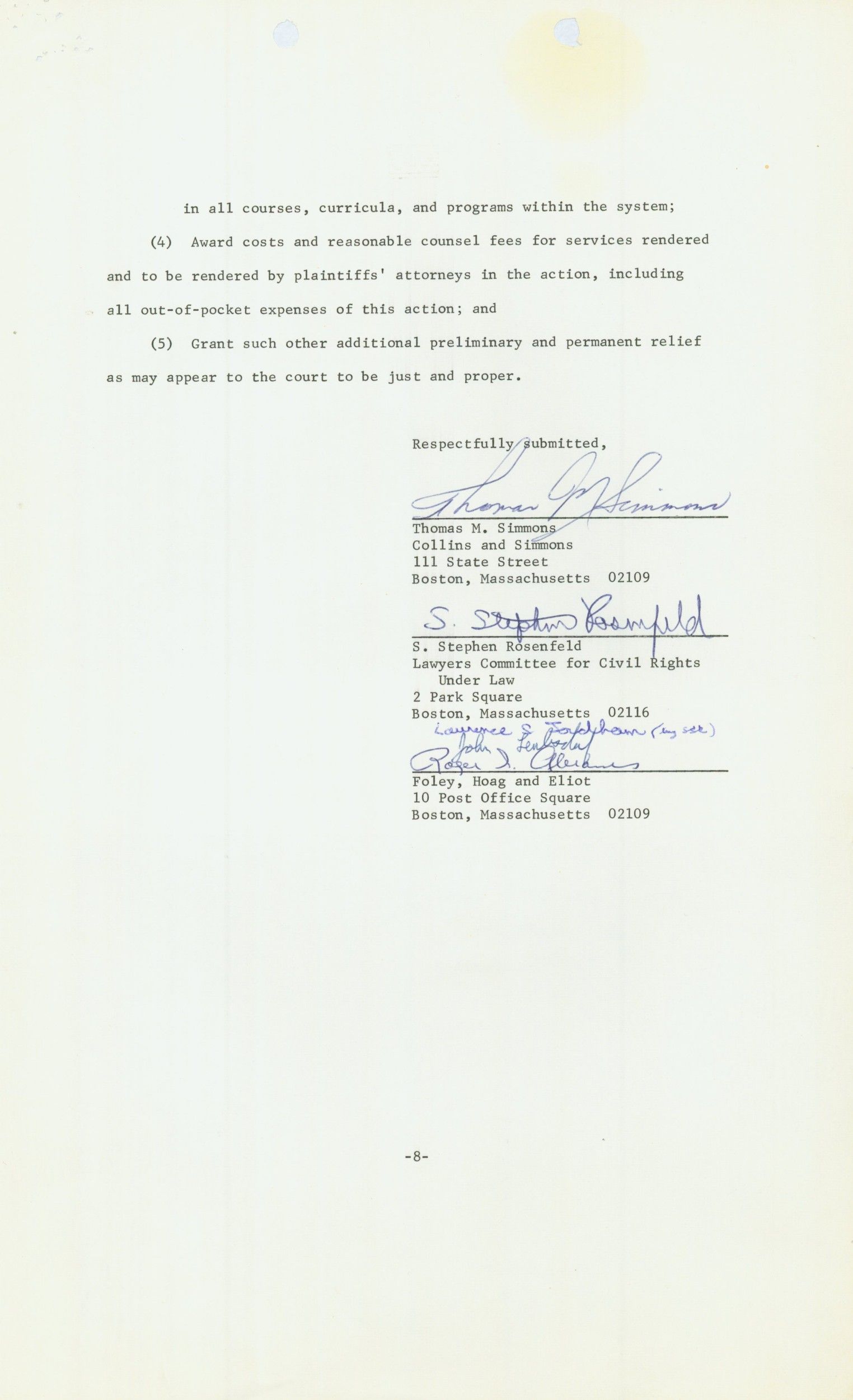
Document
Chronology Stipulation
1/19/1973
This document provides a brief history of the Boston Public Schools desegregation crisis. It comes from the court case Tallulah Morgan et al. v. James W. Hennigan et al., known as the Boston Schools Desegregation Case. In 1972, parents of African American children brought a class action lawsuit alleging that the Boston School Committee violated the 14th Amendment of the U.S. Constitution by a deliberate policy of racial segregation. Judge W. Arthur Garrity, Jr. found that the Boston School Committee had intentionally carried out a program of segregation in the Boston Public Schools. The ruling, upheld unanimously by the U.S. Court of Appeals for the First Circuit, ordered the Boston School Committee to formulate a permanent school desegregation plan that addressed student assignment, teacher employment, and facility improvement procedures, as well as the use of busing on a citywide basis. The Boston School Committee failed to present an adequate plan, so the court assumed an active role in the formulation of the desegregation plan and oversaw implementation of court-ordered desegregation in the Boston public schools. This document was digitized by teachers in our Primarily Teaching 2014 Summer Workshop in Boston.
This primary source comes from the Records of District Courts of the United States.
National Archives Identifier: 12161247
Full Citation: Chronology Stipulation; 1/19/1973; Tallulah Morgan et al v. James W. Hennigan et al Case File, 1972 - 1991; Civil Action Case Files, 1938 - 1998; Records of District Courts of the United States, ; National Archives at Boston (RE-BO), Waltham, MA. [Online Version, https://www.docsteach.org/documents/document/chronology-stipulation, April 18, 2024]Chronology Stipulation
Page 1

Chronology Stipulation
Page 2

Chronology Stipulation
Page 3
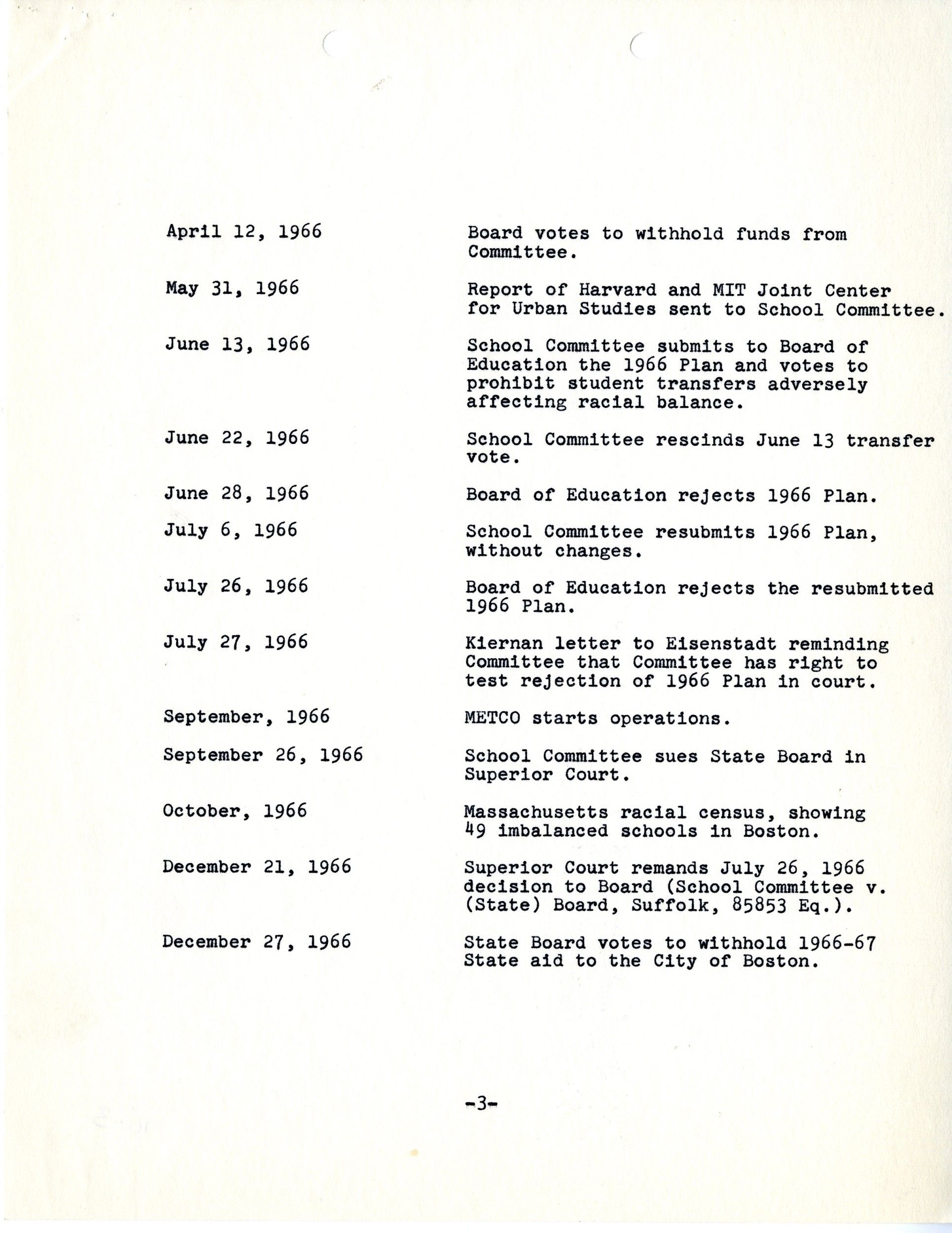
Chronology Stipulation
Page 4
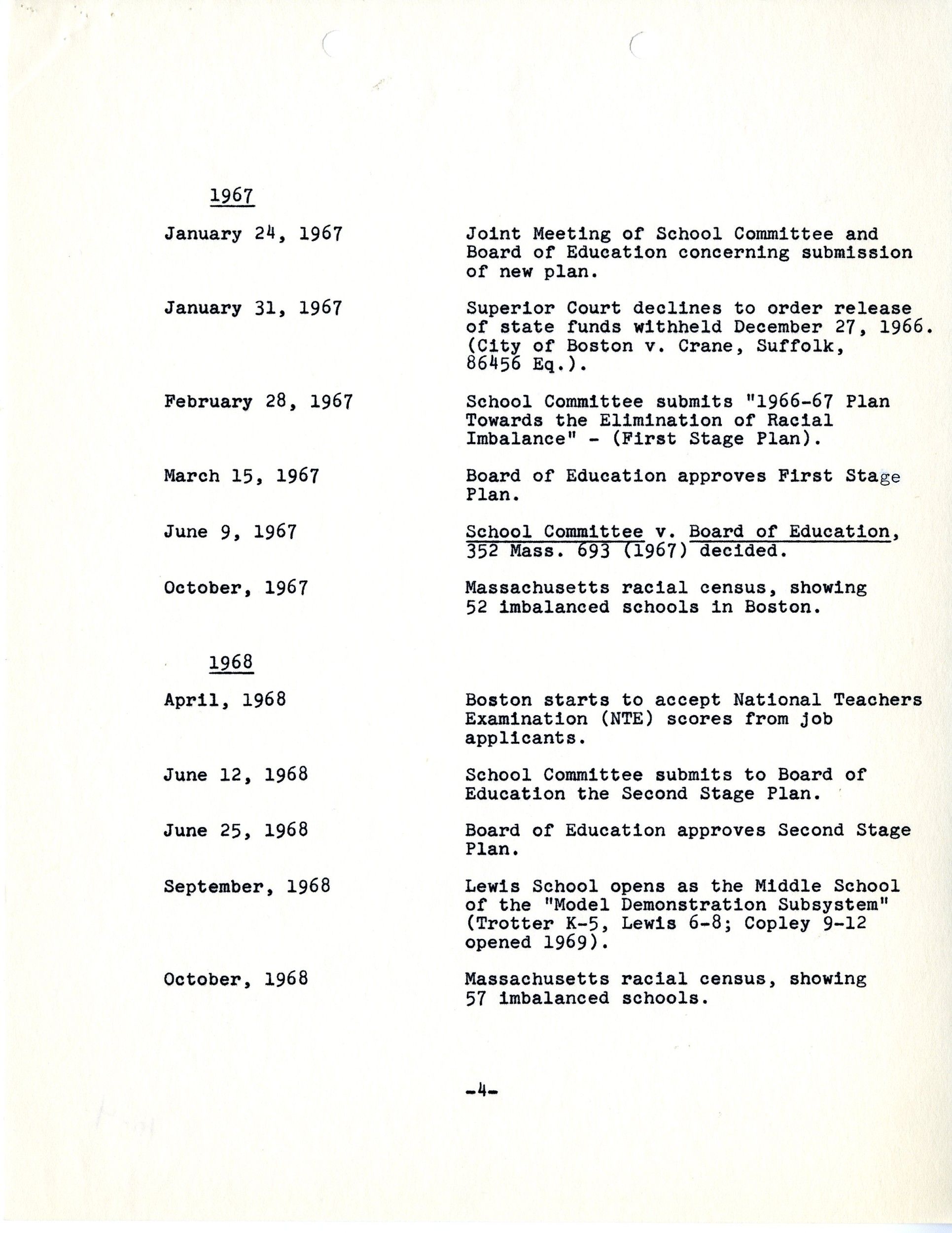
Chronology Stipulation
Page 5

Chronology Stipulation
Page 6
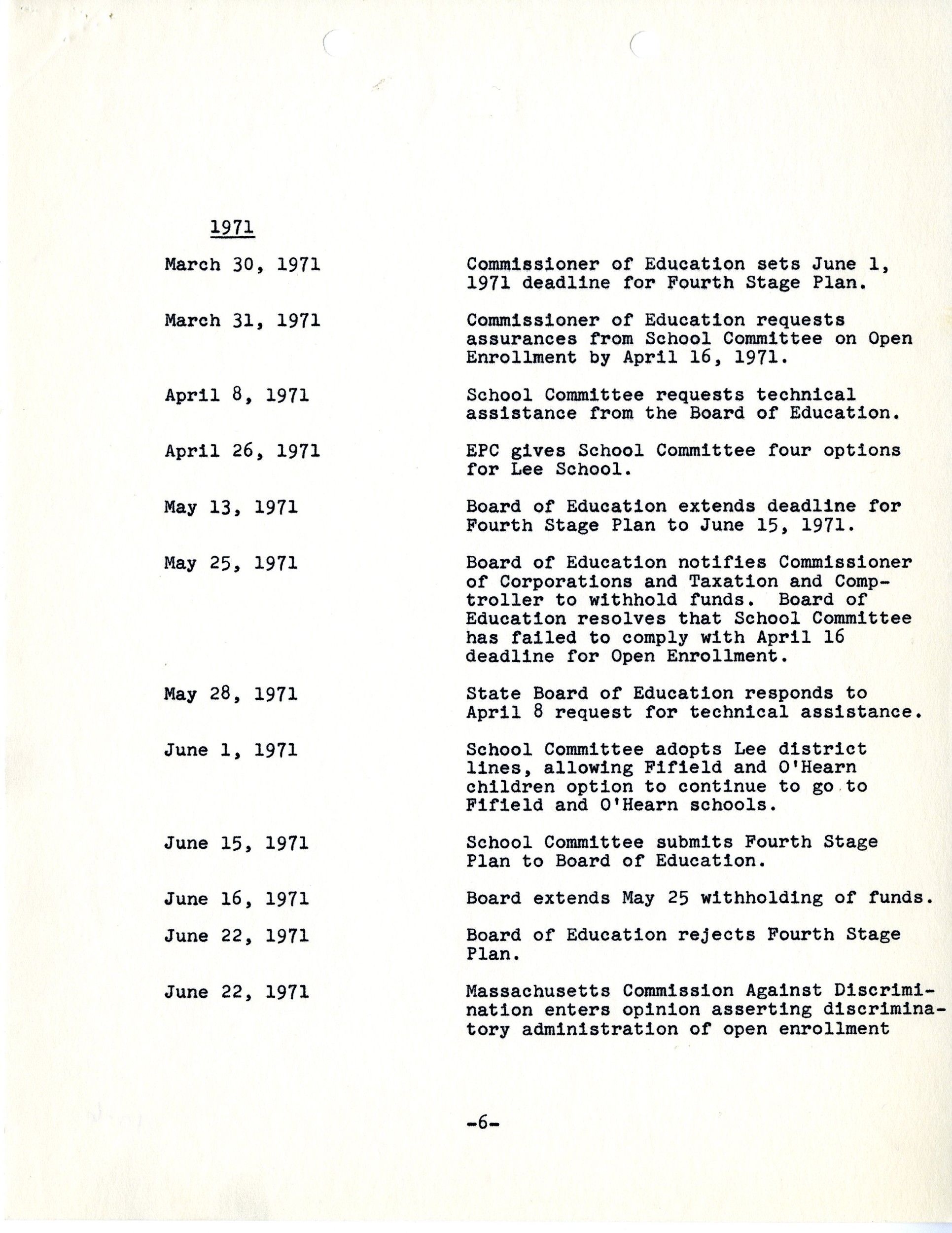
Chronology Stipulation
Page 7
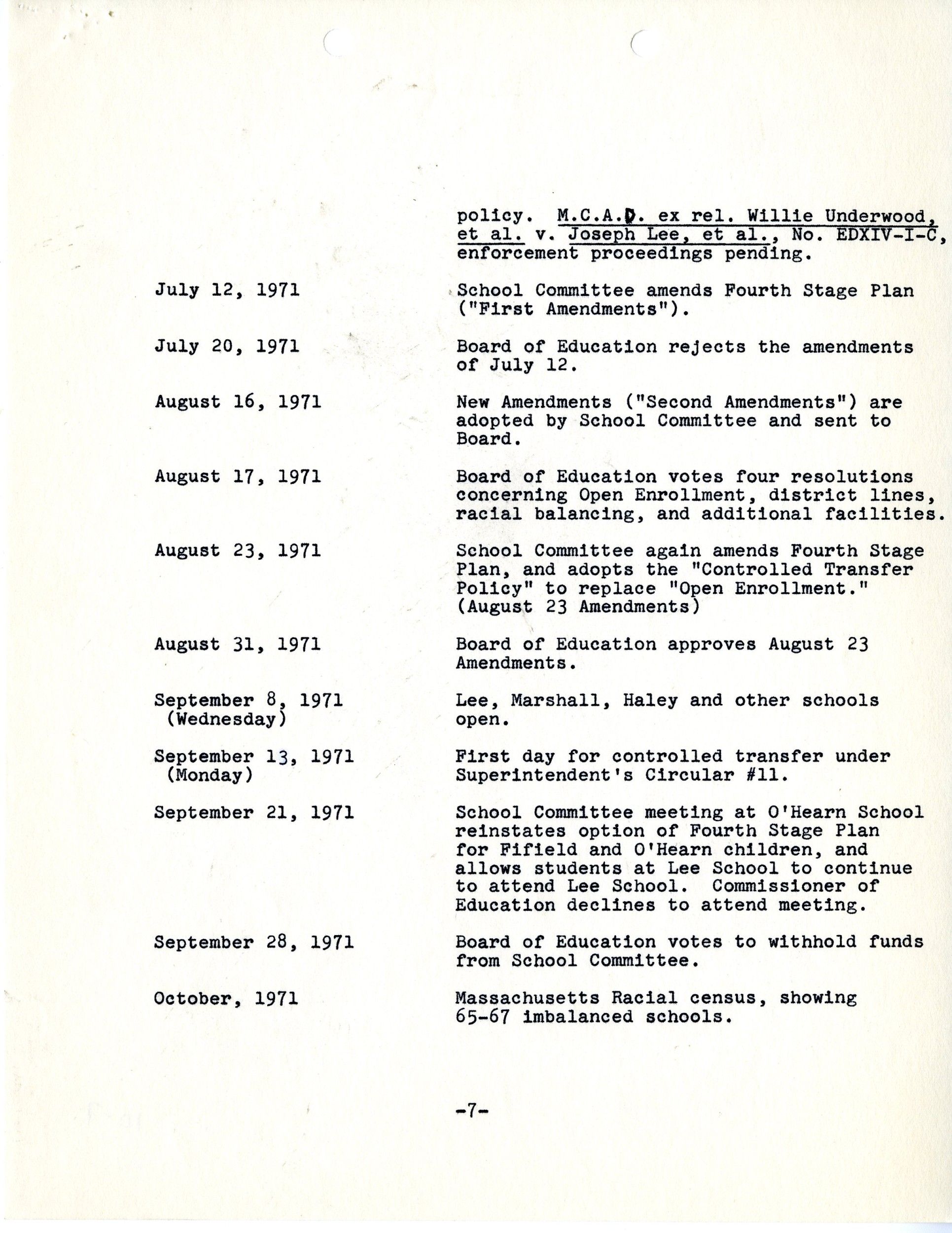
Chronology Stipulation
Page 8
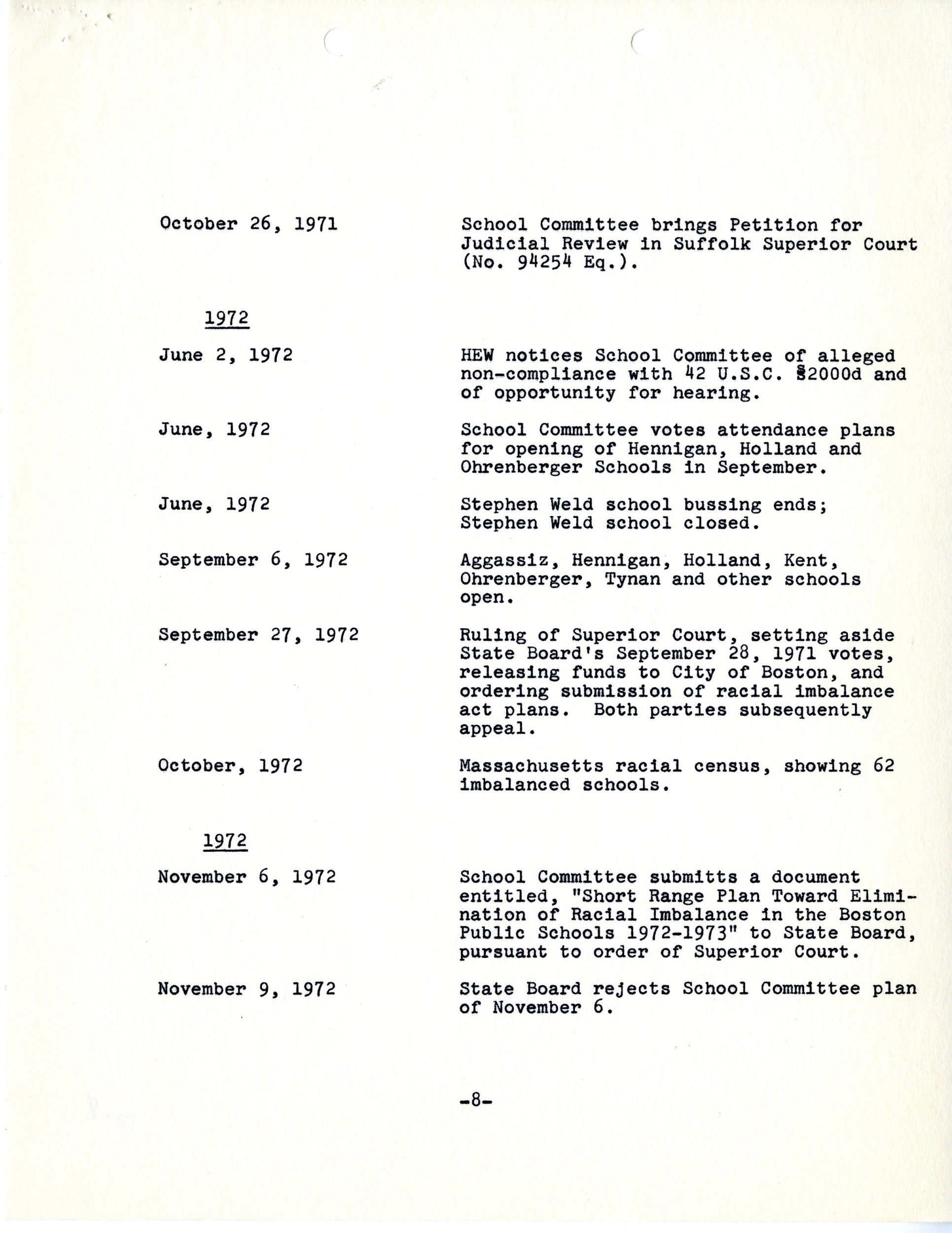
Chronology Stipulation
Page 9
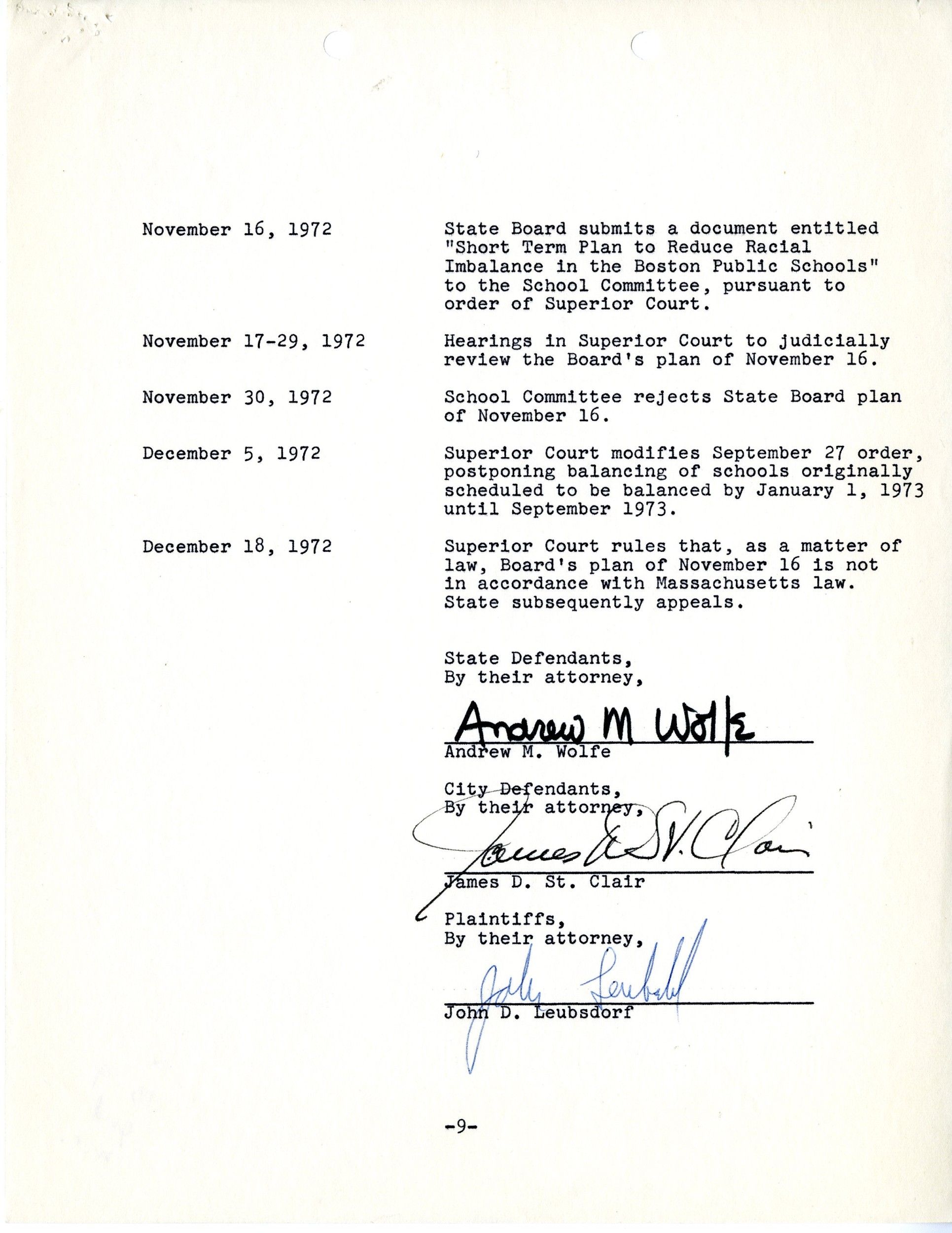
Document
Plaintiff's Brief on Neighborhood Schools
3/23/1973
This brief discusses the validity of a "neighborhood school system" defense. It comes from the court case Tallulah Morgan et al. v. James W. Hennigan et al., known as the Boston Schools Desegregation Case. In 1972, parents of African American children brought a class action lawsuit alleging that the Boston School Committee violated the 14th Amendment of the U.S. Constitution by a deliberate policy of racial segregation. Judge W. Arthur Garrity, Jr. found that the Boston School Committee had intentionally carried out a program of segregation in the Boston Public Schools. The ruling, upheld unanimously by the U.S. Court of Appeals for the First Circuit, ordered the Boston School Committee to formulate a permanent school desegregation plan that addressed student assignment, teacher employment, and facility improvement procedures, as well as the use of busing on a citywide basis. The Boston School Committee failed to present an adequate plan, so the court assumed an active role in the formulation of the desegregation plan and oversaw implementation of court-ordered desegregation in the Boston public schools. This document was digitized by teachers in our Primarily Teaching 2014 Summer Workshop in Boston.
This primary source comes from the Records of the District Courts of the United States.
National Archives Identifier: 12161241
Full Citation: Plaintiff's Brief on Neighborhood Schools; 3/23/1973; Tallulah Morgan et al v. James W. Hennigan et al Case File, 1972 - 1991; Civil Action Case Files, 1938 - 1998; Records of the District Courts of the United States, ; National Archives at Boston, Waltham, MA. [Online Version, https://www.docsteach.org/documents/document/plaintiffs-brief-neighborhood-schools, April 18, 2024]Plaintiff's Brief on Neighborhood Schools
Page 1
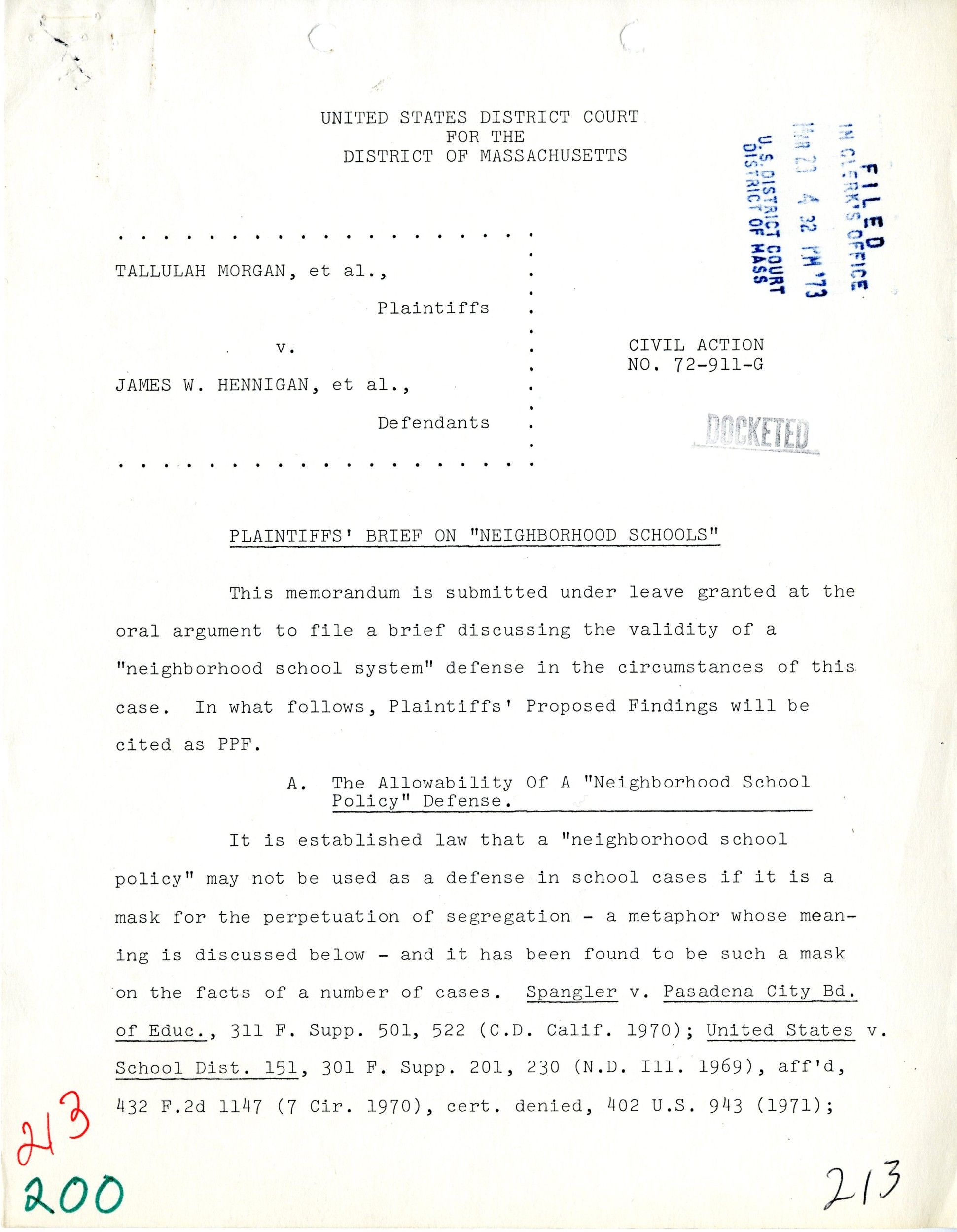
Plaintiff's Brief on Neighborhood Schools
Page 2
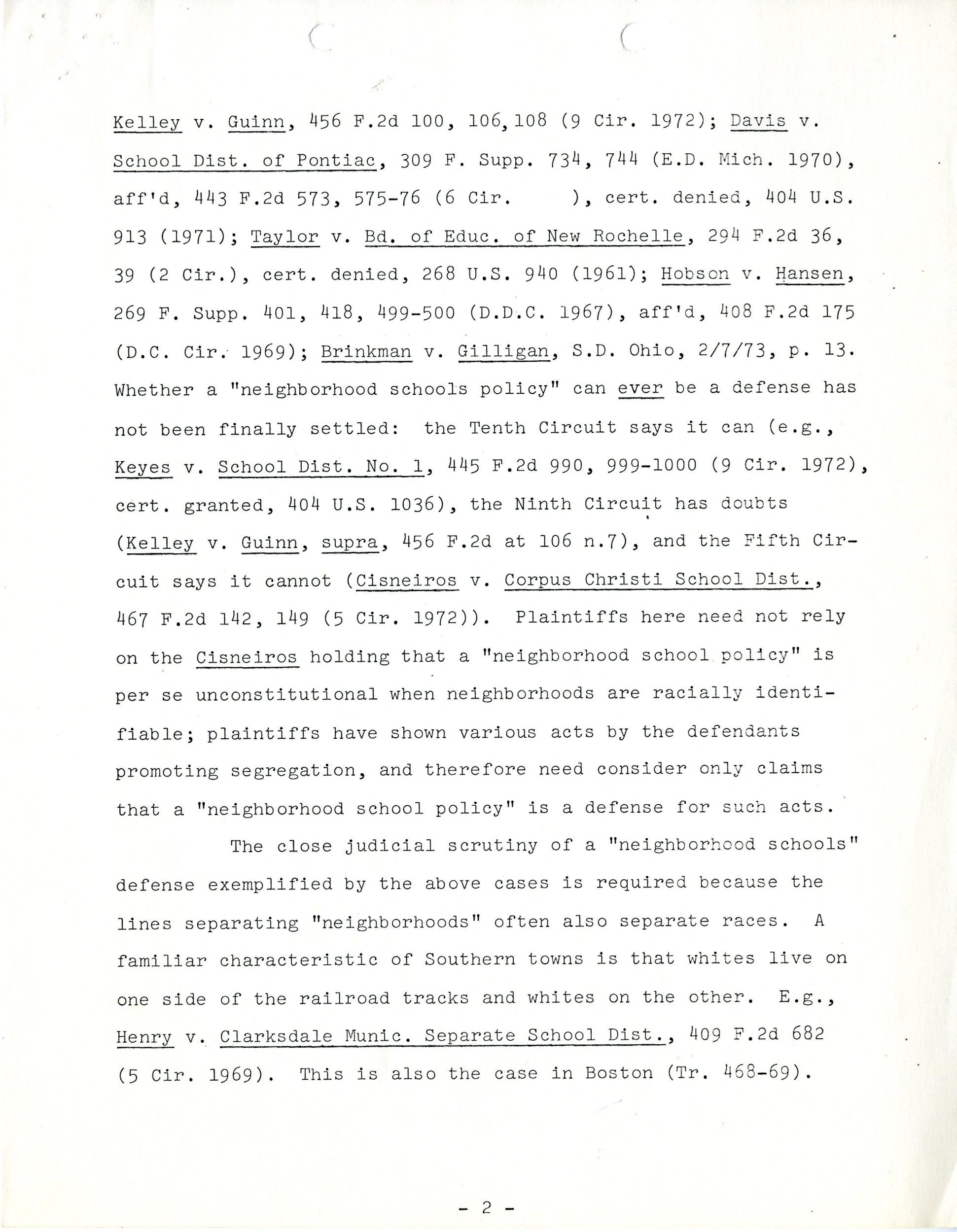
Plaintiff's Brief on Neighborhood Schools
Page 3
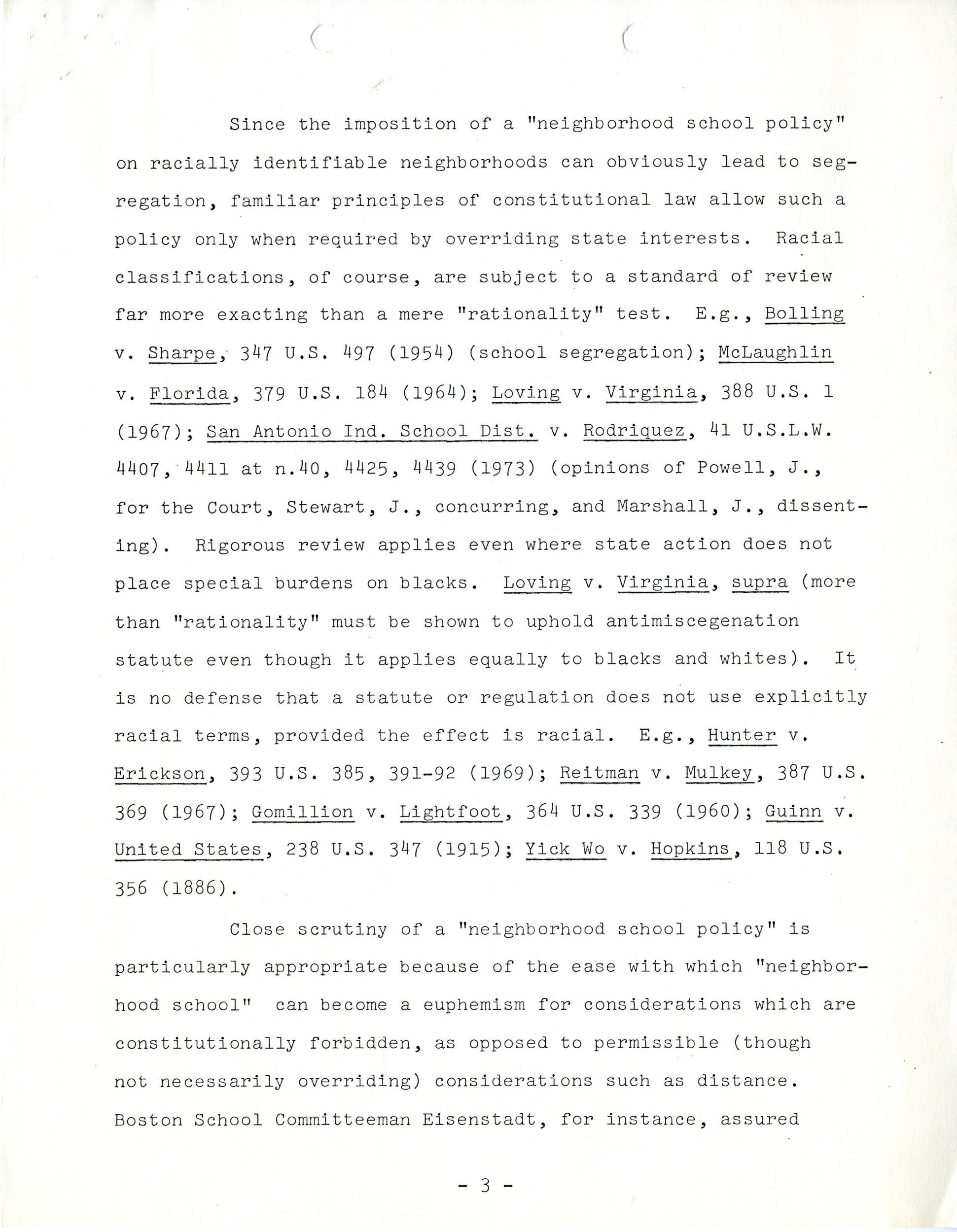
Plaintiff's Brief on Neighborhood Schools
Page 4
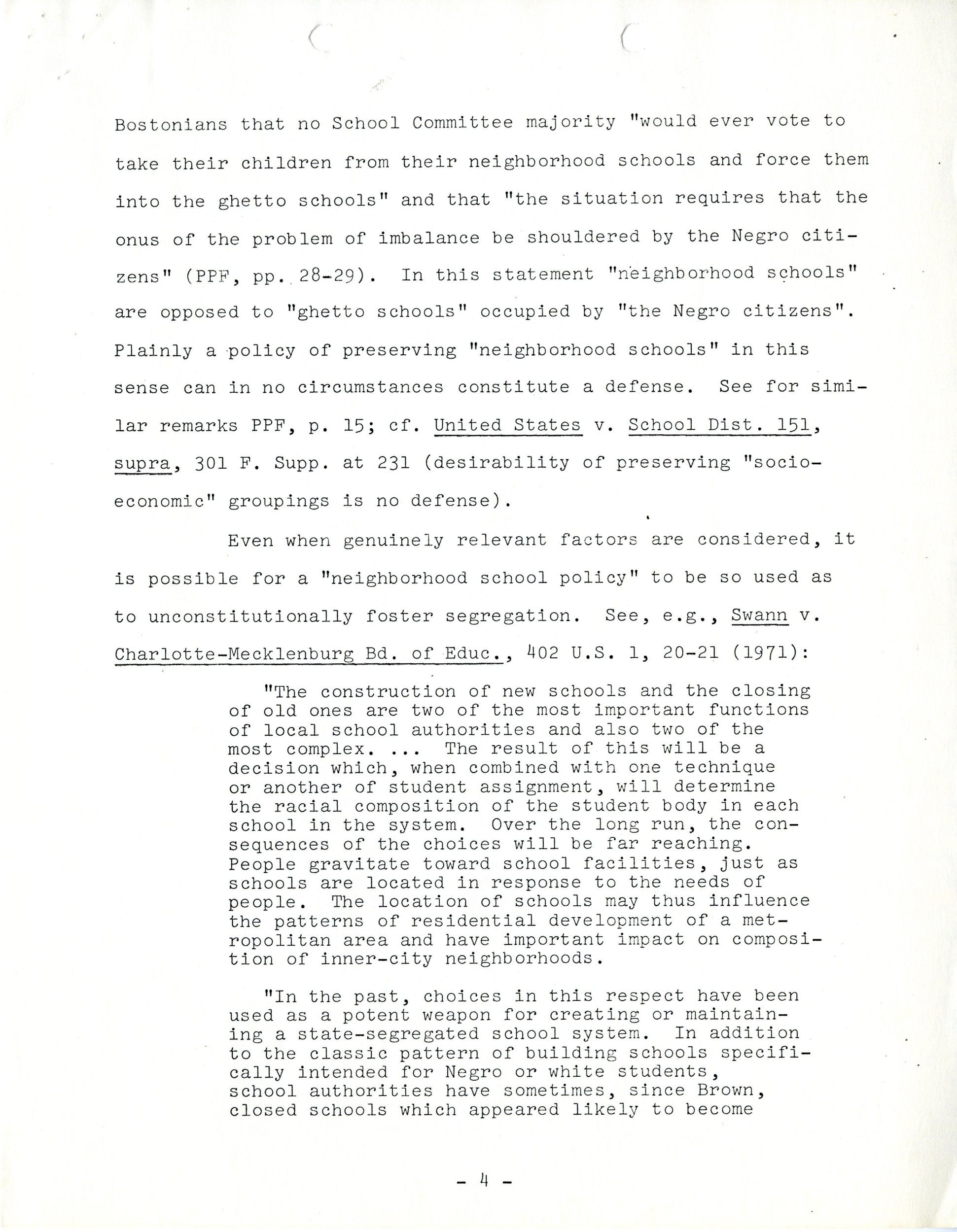
Plaintiff's Brief on Neighborhood Schools
Page 5

Plaintiff's Brief on Neighborhood Schools
Page 6
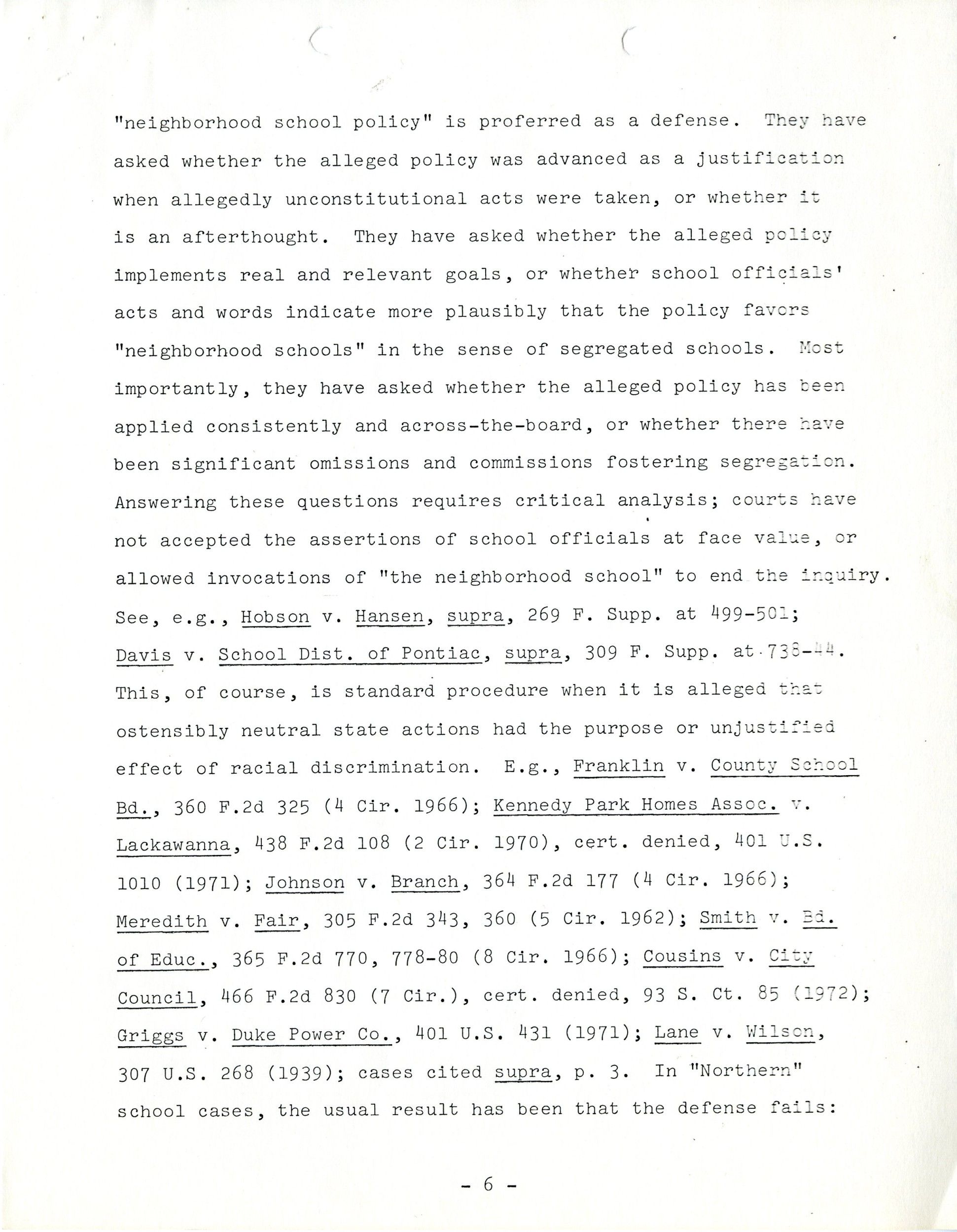
Plaintiff's Brief on Neighborhood Schools
Page 7
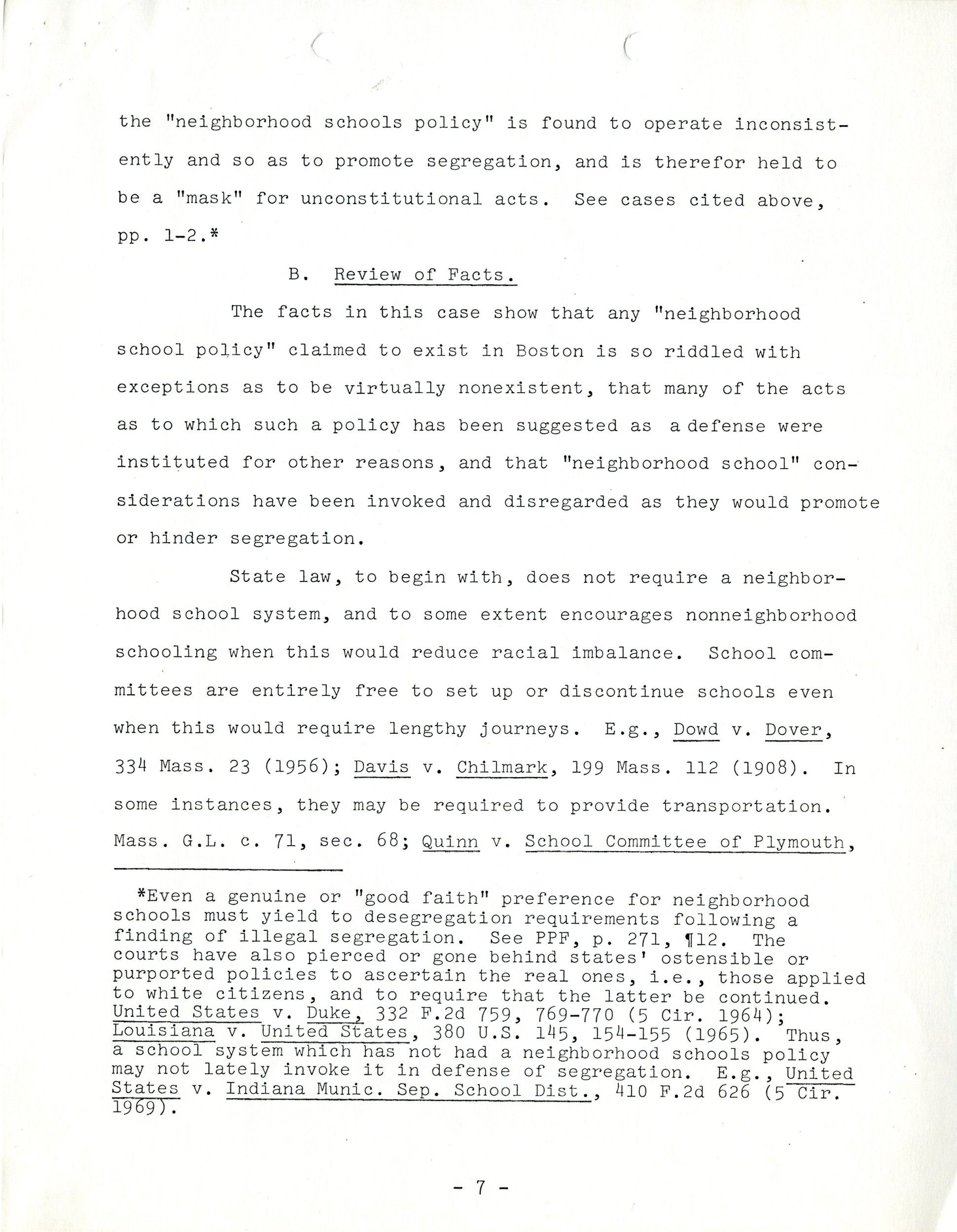
Plaintiff's Brief on Neighborhood Schools
Page 8
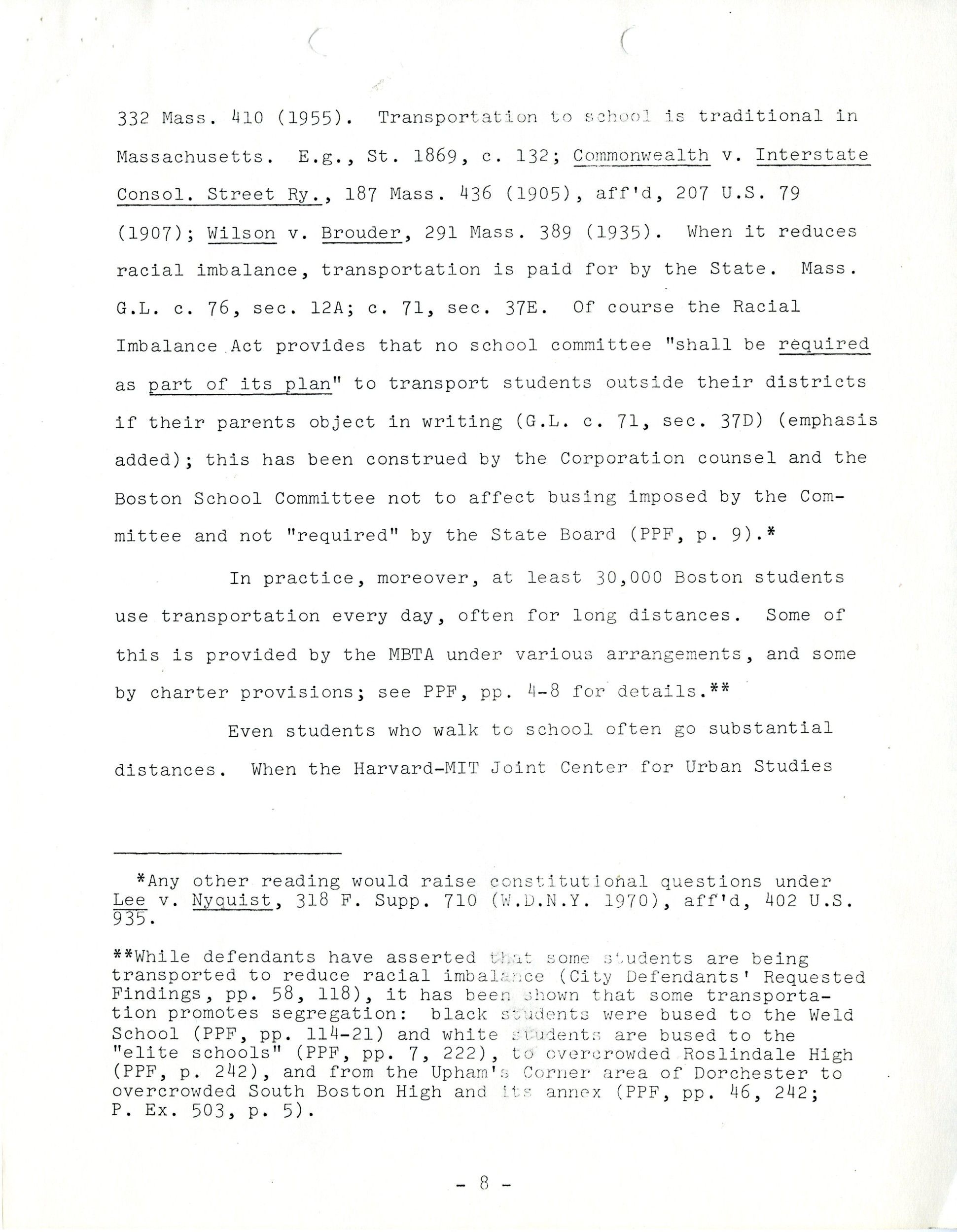
Plaintiff's Brief on Neighborhood Schools
Page 9
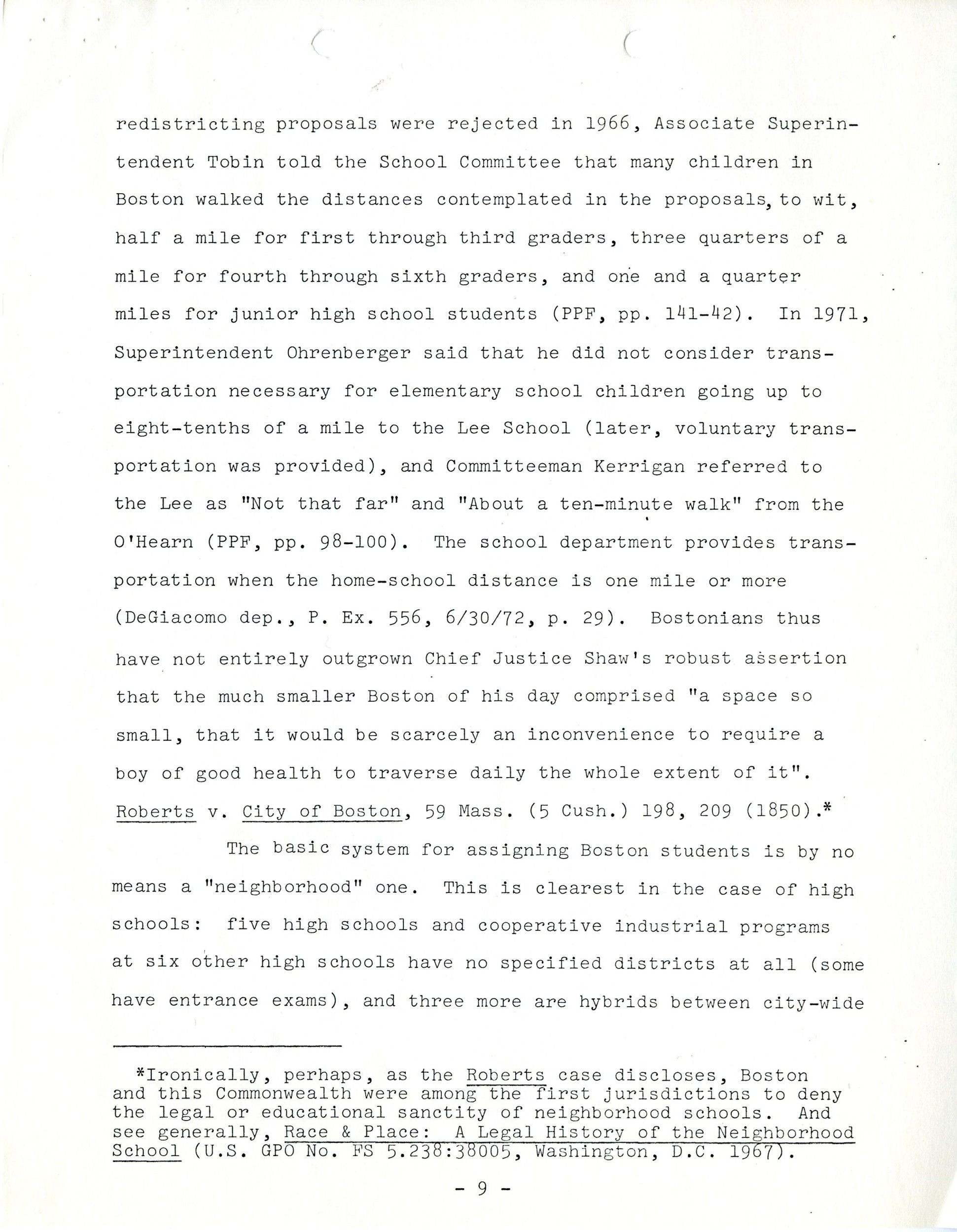
Plaintiff's Brief on Neighborhood Schools
Page 10
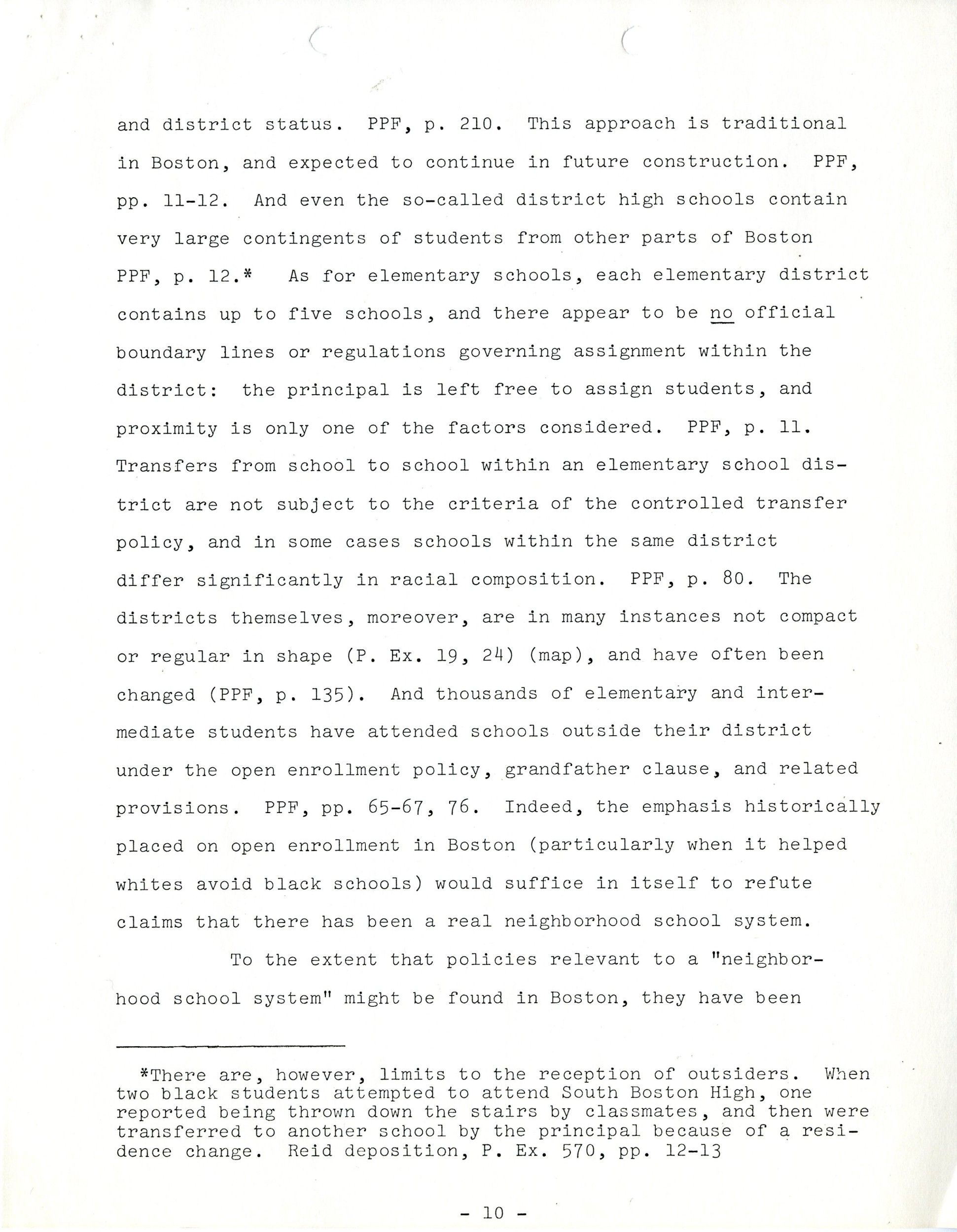
Plaintiff's Brief on Neighborhood Schools
Page 11
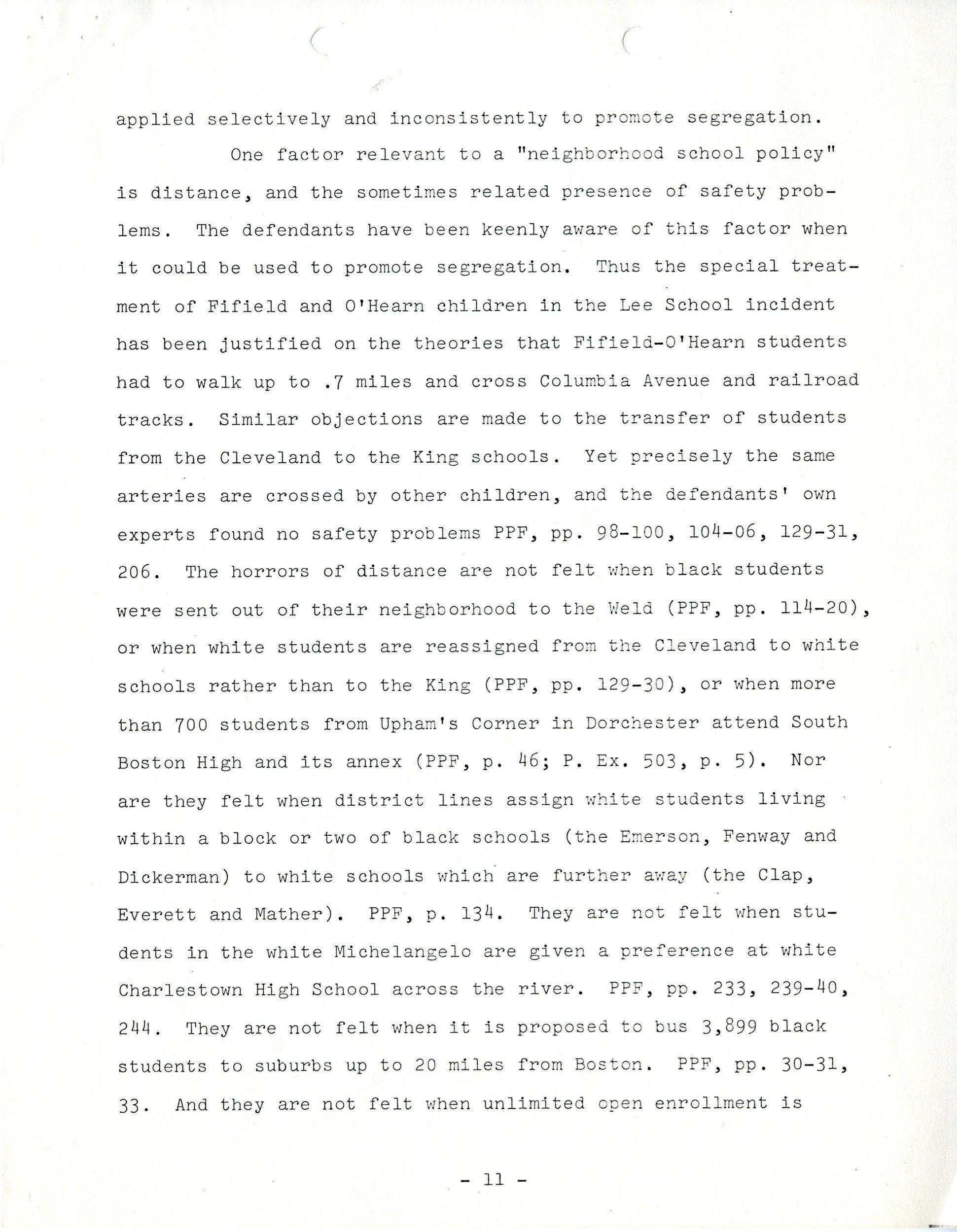
Plaintiff's Brief on Neighborhood Schools
Page 12
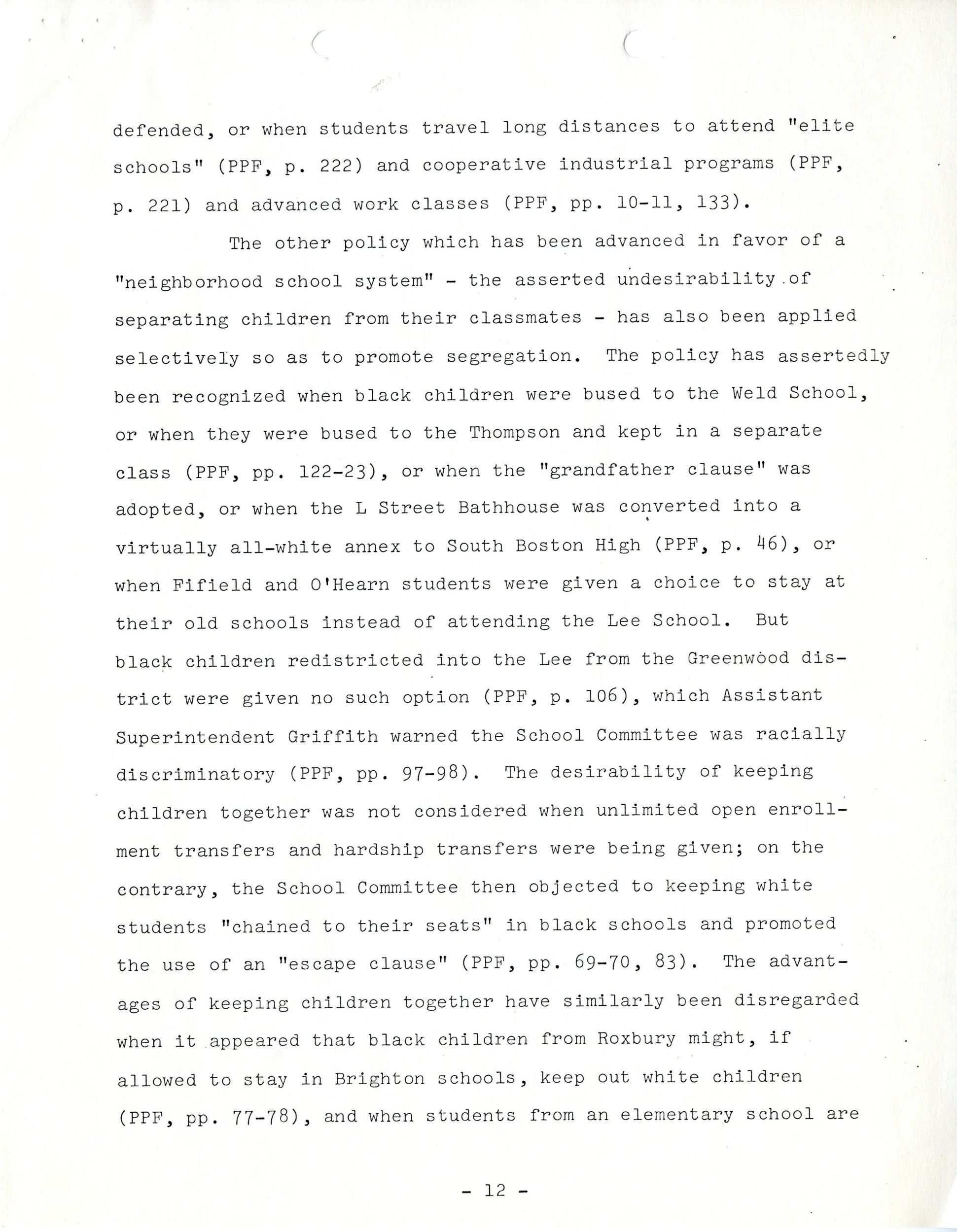
Plaintiff's Brief on Neighborhood Schools
Page 13
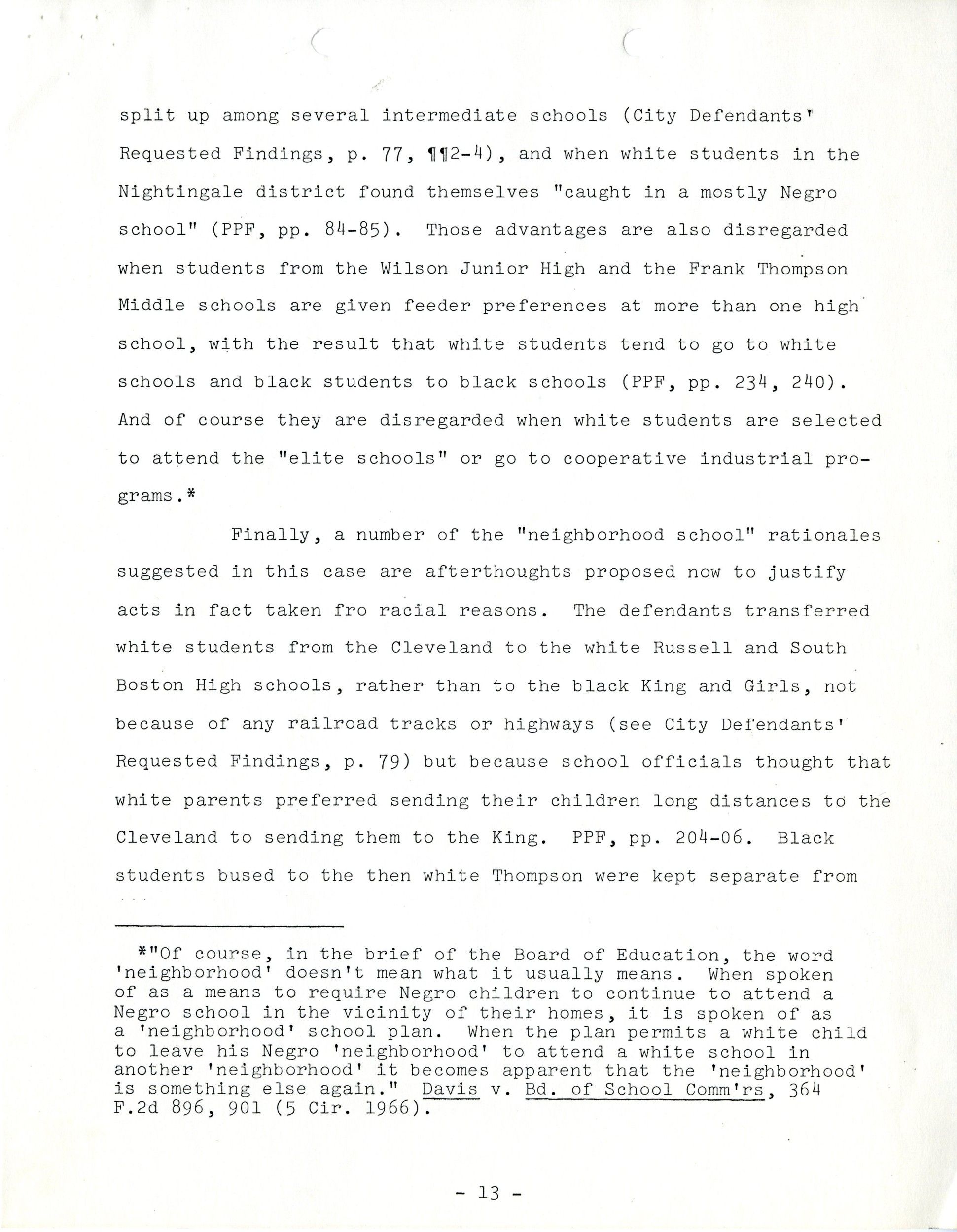
Plaintiff's Brief on Neighborhood Schools
Page 14

Plaintiff's Brief on Neighborhood Schools
Page 15
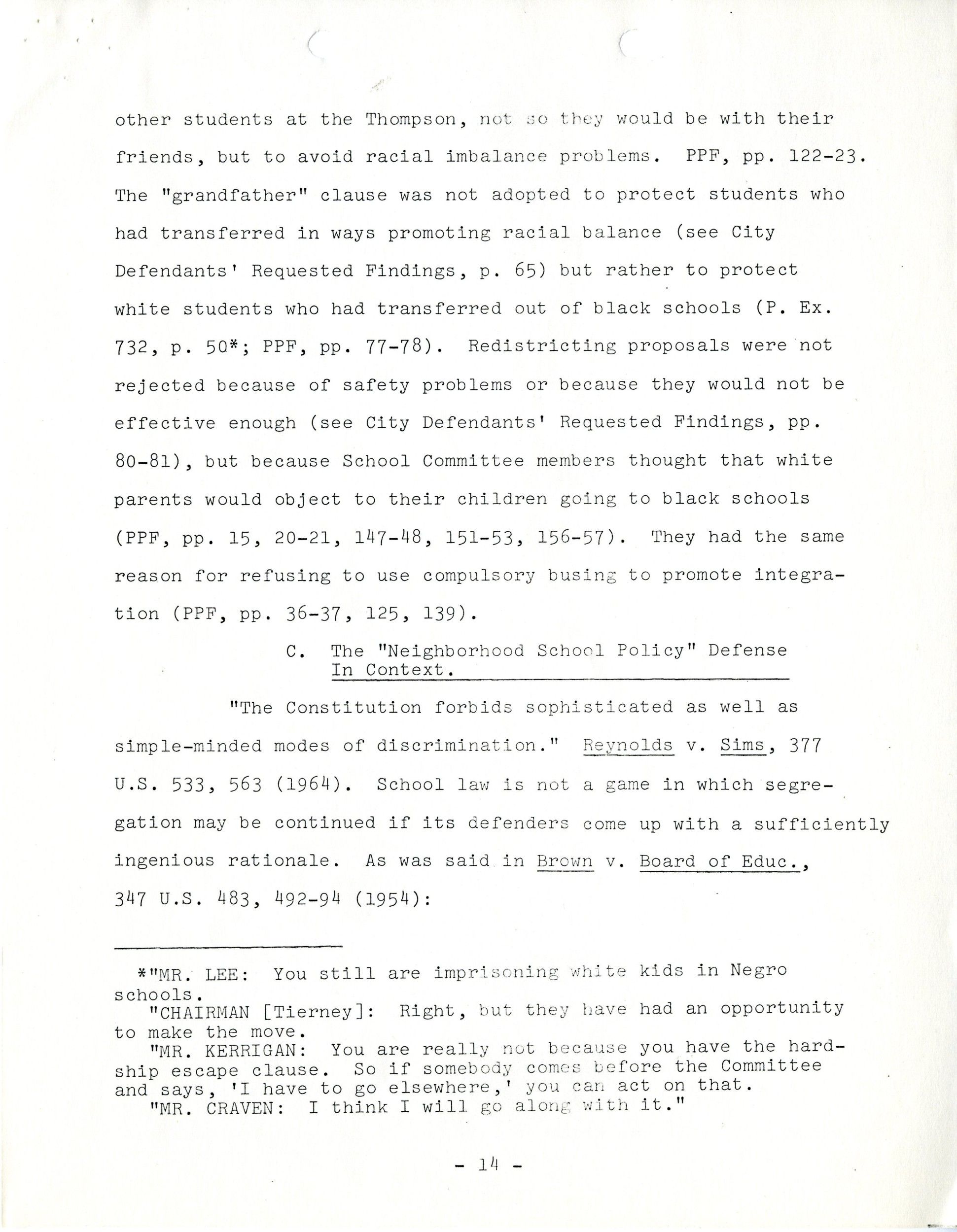
Plaintiff's Brief on Neighborhood Schools
Page 16

Plaintiff's Brief on Neighborhood Schools
Page 17

Plaintiff's Brief on Neighborhood Schools
Page 18
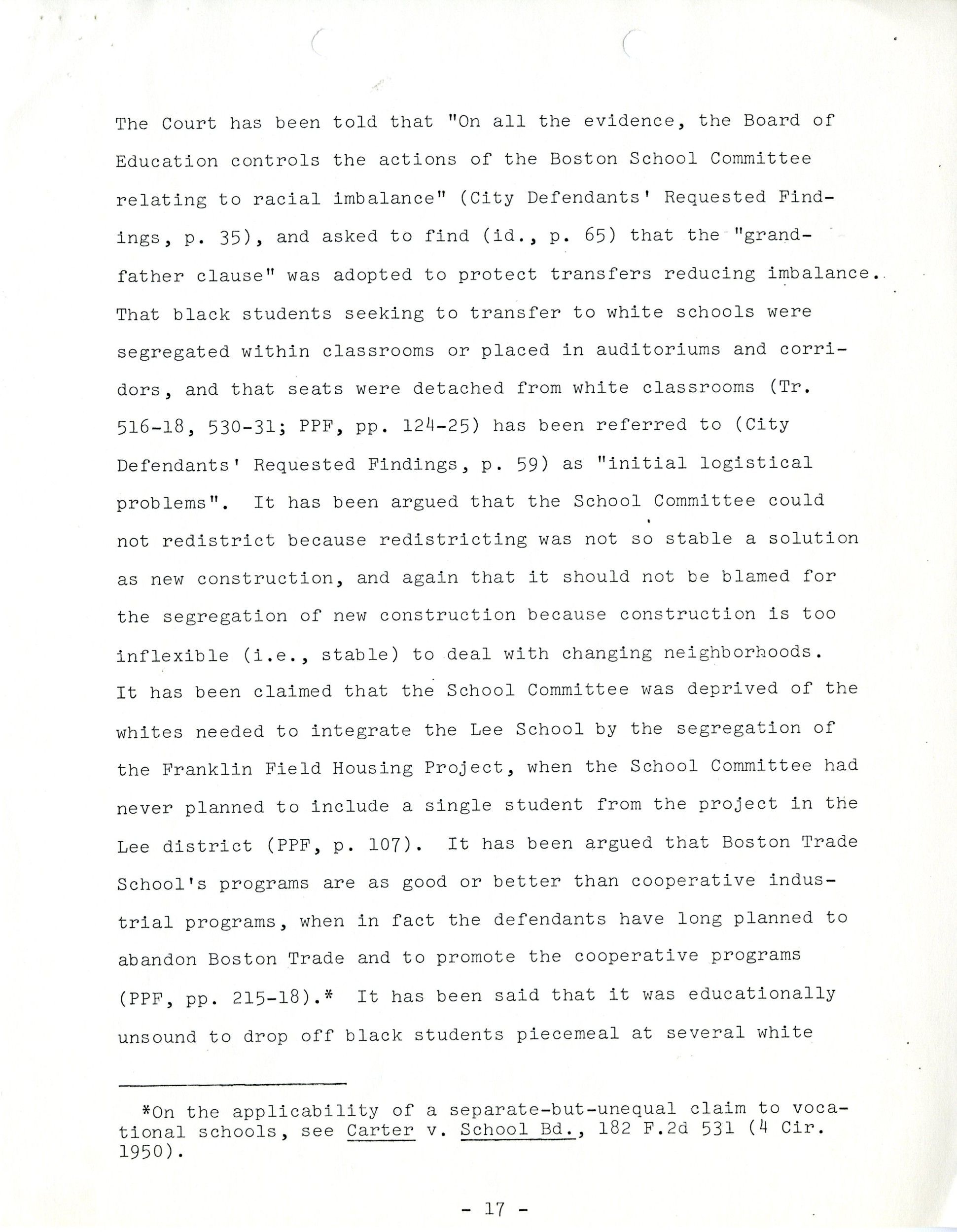
Plaintiff's Brief on Neighborhood Schools
Page 19

Plaintiff's Brief on Neighborhood Schools
Page 20
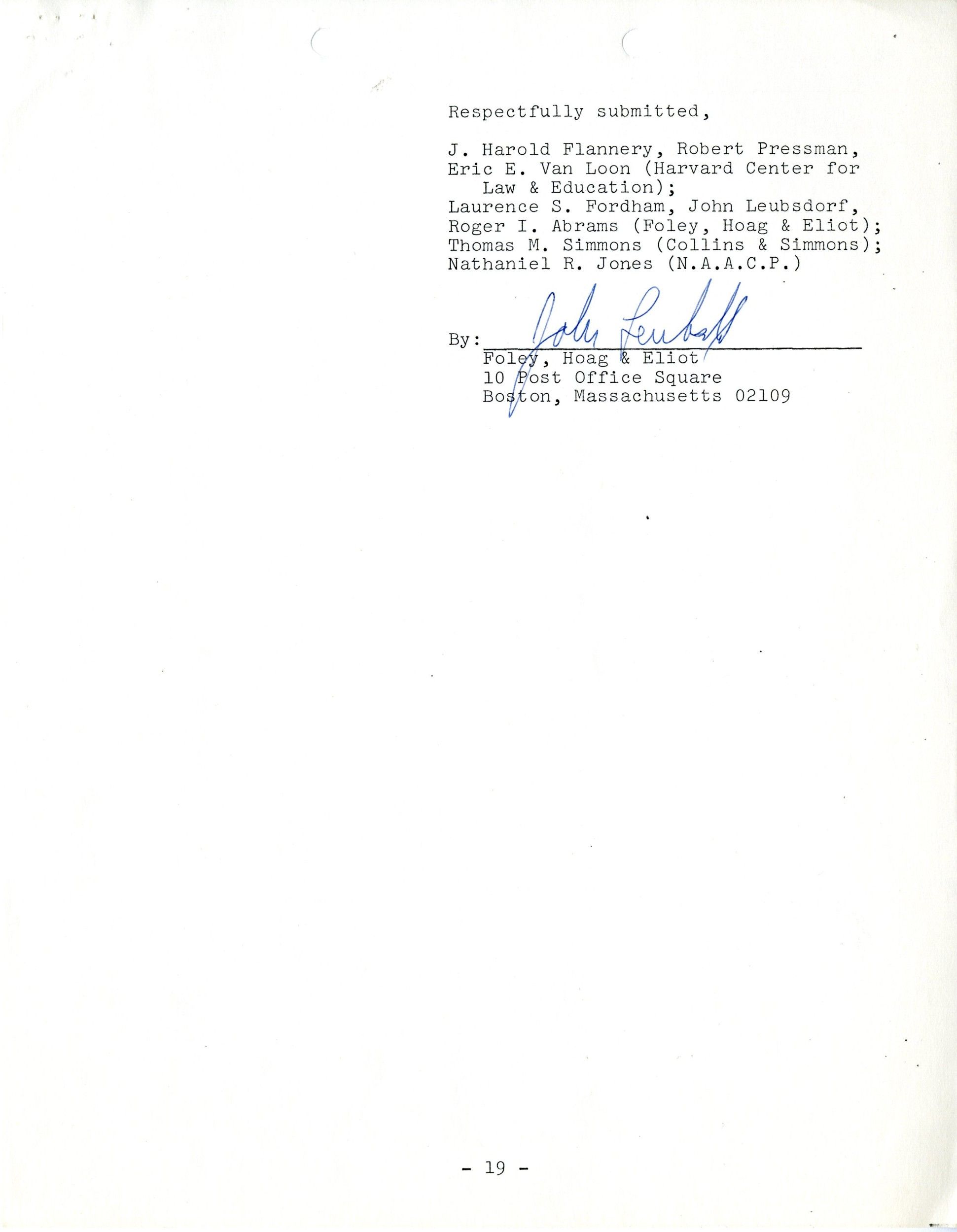
Plaintiff's Brief on Neighborhood Schools
Page 21
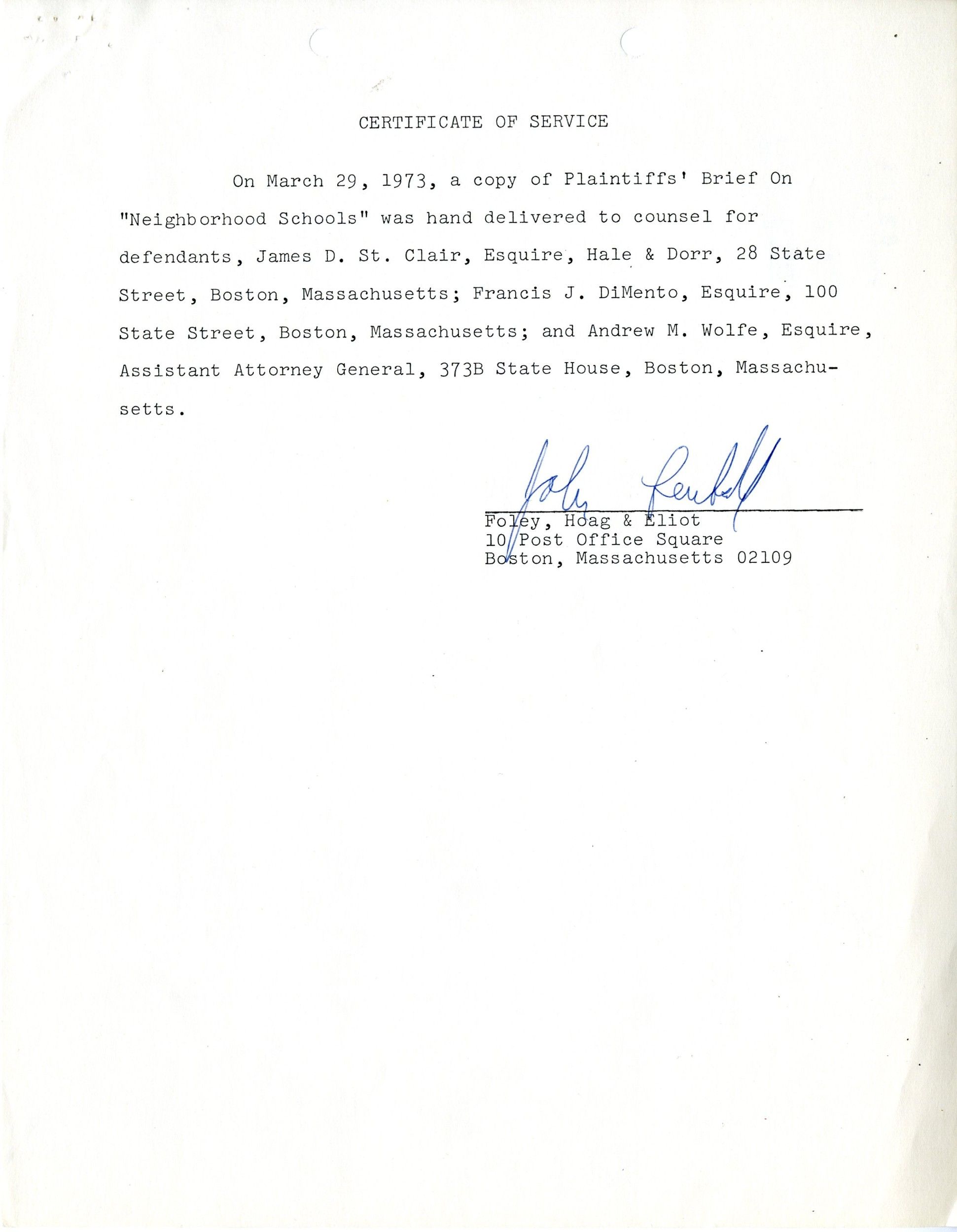
Document
Letter and Summary Report of Incidents of Intimidation of Teachers during the Desegregation of South Boston High School and the Abrahams School
9/6/1974
This letter and summary report from Attorney John F. McMahon requests an in-chambers conference with Judge W. Arthur Garrity. It comes from the court case Tallulah Morgan et al. v. James W. Hennigan et al., known as the Boston Schools Desegregation Case. In 1972, parents of African American children brought a class action lawsuit alleging that the Boston School Committee violated the 14th Amendment of the U.S. Constitution by a deliberate policy of racial segregation. Judge W. Arthur Garrity, Jr. found that the Boston School Committee had intentionally carried out a program of segregation in the Boston Public Schools. The ruling, upheld unanimously by the U.S. Court of Appeals for the First Circuit, ordered the Boston School Committee to formulate a permanent school desegregation plan that addressed student assignment, teacher employment, and facility improvement procedures, as well as the use of busing on a citywide basis. The Boston School Committee failed to present an adequate plan, so the court assumed an active role in the formulation of the desegregation plan and oversaw implementation of court-ordered desegregation in the Boston public schools. This document was digitized by teachers in our Primarily Teaching 2014 Summer Workshop in Boston.
This primary source comes from the Records of the District Courts of the United States.
National Archives Identifier: 12161243
Full Citation: Letter and Summary Report of Incidents of Intimidation of Teachers during the Desegregation of South Boston High School and the Abrahams School; 9/6/1974; Tallulah Morgan et al v. James W. Hennigan et al Case File, 1972 - 1991; Civil Action Case Files, 1938 - 1998; Records of the District Courts of the United States, ; National Archives at Boston (RE-BO), Waltham, MA. [Online Version, https://www.docsteach.org/documents/document/letter-summary-report-intimidation-teachers-desegregation, April 18, 2024]Letter and Summary Report of Incidents of Intimidation of Teachers during the Desegregation of South Boston High School and the Abrahams School
Page 1

Letter and Summary Report of Incidents of Intimidation of Teachers during the Desegregation of South Boston High School and the Abrahams School
Page 2
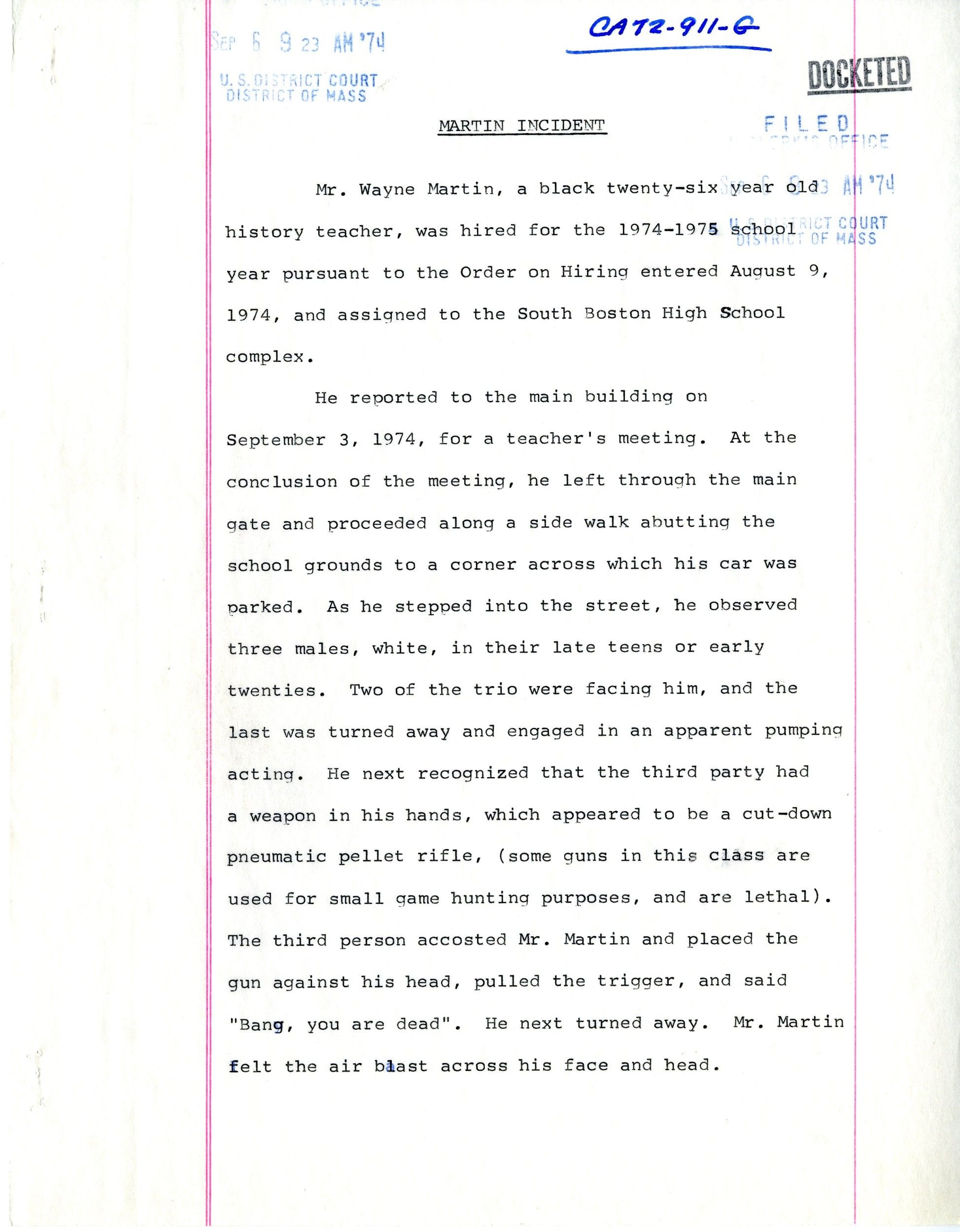
Letter and Summary Report of Incidents of Intimidation of Teachers during the Desegregation of South Boston High School and the Abrahams School
Page 3
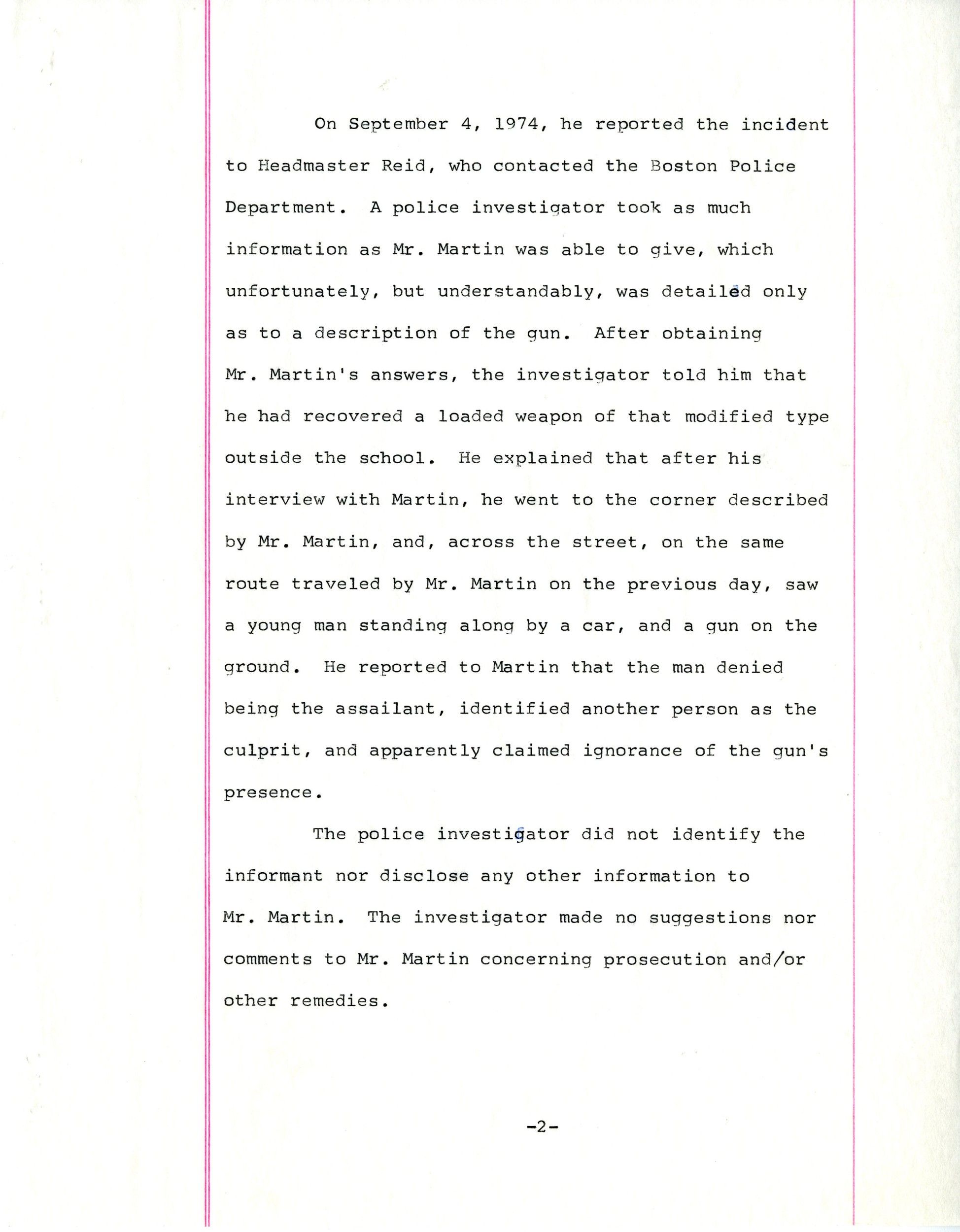
Letter and Summary Report of Incidents of Intimidation of Teachers during the Desegregation of South Boston High School and the Abrahams School
Page 4
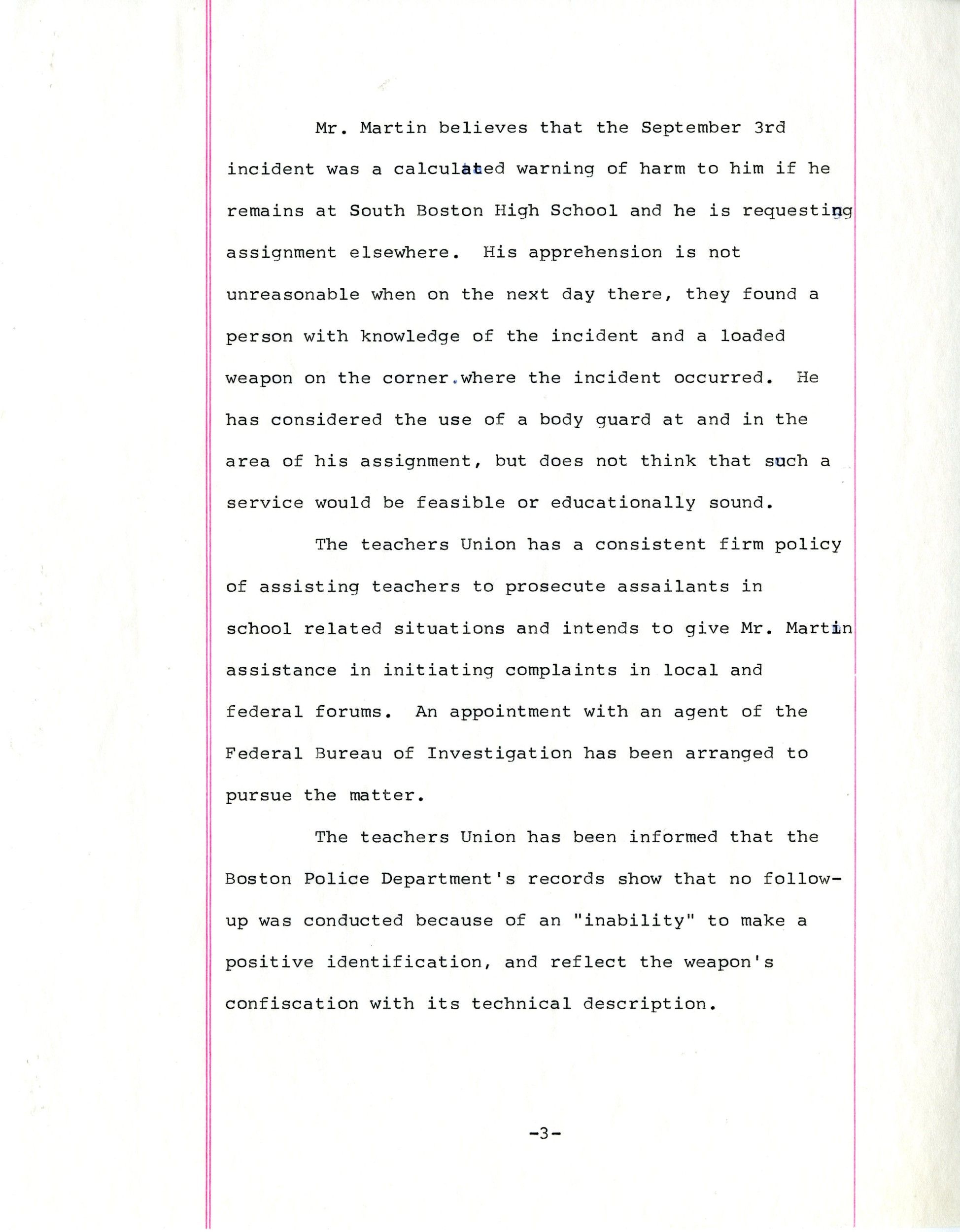
Letter and Summary Report of Incidents of Intimidation of Teachers during the Desegregation of South Boston High School and the Abrahams School
Page 5
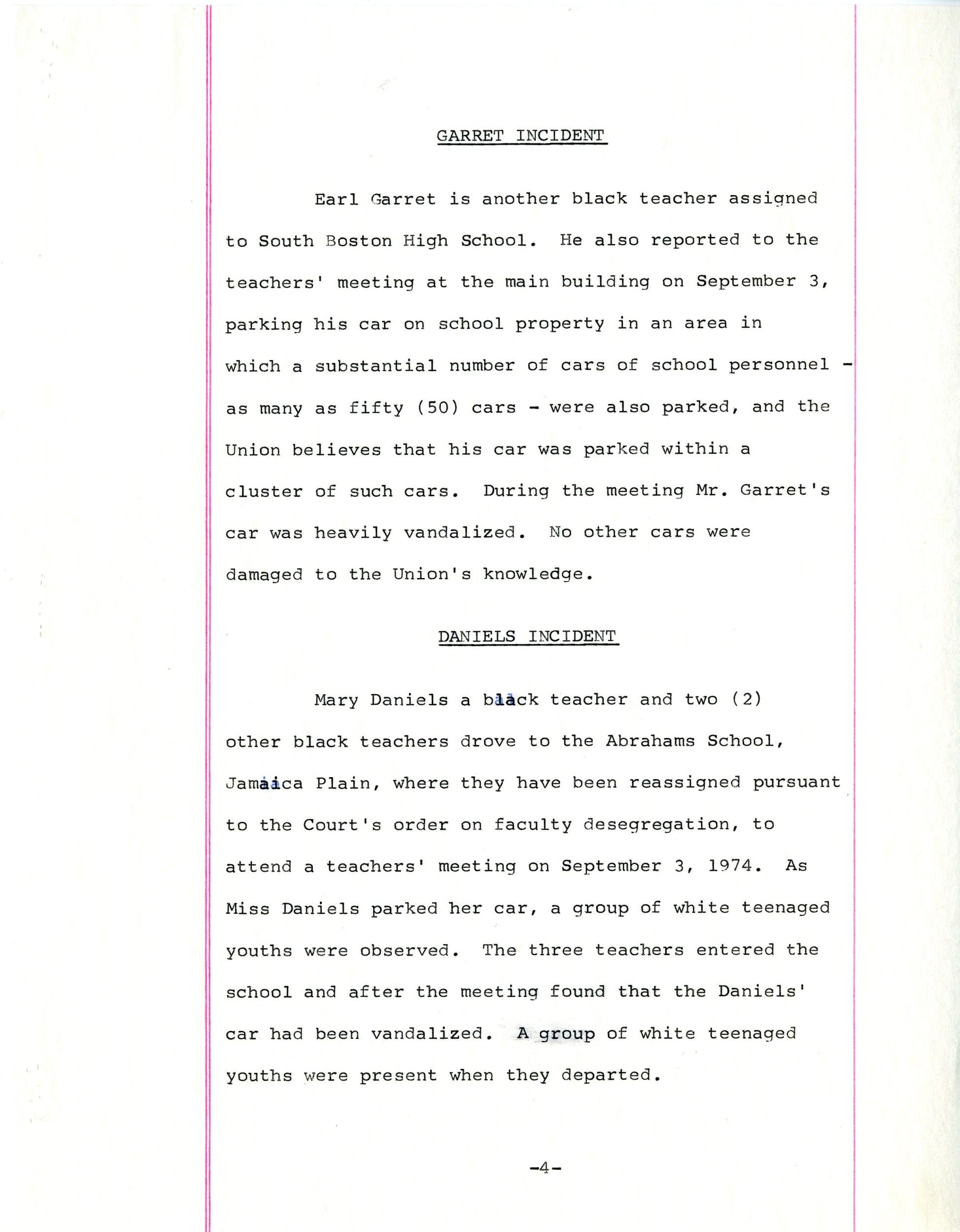
Letter and Summary Report of Incidents of Intimidation of Teachers during the Desegregation of South Boston High School and the Abrahams School
Page 6

Document
Western Union Mailgram Sent to Governor Francis Sargent from Residents of the Columbia Point Housing Project
9/16/1974
This mailgram requests U. S. Marshall intervention in the Boston Public Schools desegregation crisis. It comes from the court case Tallulah Morgan et al. v. James W. Hennigan et al. , known as the Boston Schools Desegregation Case. In 1972, parents of African American children brought a class action lawsuit alleging that the Boston School Committee violated the 14th Amendment of the U.S. Constitution by a deliberate policy of racial segregation. Judge W. Arthur Garrity, Jr. found that the Boston School Committee had intentionally carried out a program of segregation in the Boston Public Schools. The ruling, upheld unanimously by the U.S. Court of Appeals for the First Circuit, ordered the Boston School Committee to formulate a permanent school desegregation plan that addressed student assignment, teacher employment, and facility improvement procedures, as well as the use of busing on a citywide basis. The Boston School Committee failed to present an adequate plan, so the court assumed an active role in the formulation of the desegregation plan and oversaw implementation of court-ordered desegregation in the Boston public schools. This document was digitized by teachers in our Primarily Teaching 2014 Summer Workshop in Boston.
This primary source comes from the Records of District Courts of the United States.
National Archives Identifier: 12161234
Full Citation: Western Union Mailgram Sent to Governor Francis Sargent from Residents of the Columbia Point Housing Project; 9/16/1974; Tallulah Morgan et al v. James W. Hennigan et al Case File, 1972 - 1991; Civil Action Case Files, 1938 - 1998; Records of District Courts of the United States, ; National Archives at Boston, Waltham, MA. [Online Version, https://www.docsteach.org/documents/document/western-union-mailgram-governor-francis-sargent, April 18, 2024]Western Union Mailgram Sent to Governor Francis Sargent from Residents of the Columbia Point Housing Project
Page 1
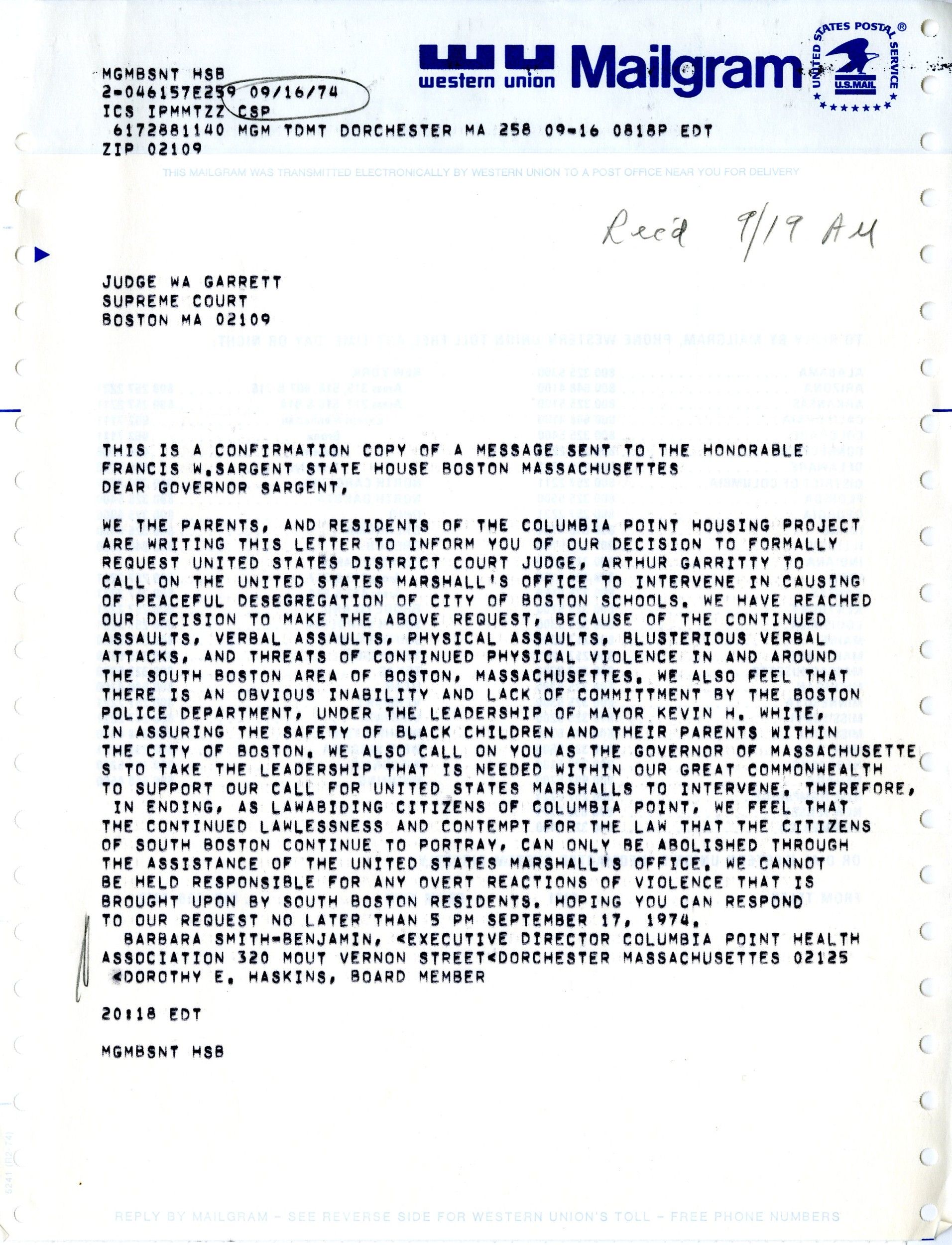
Document
Plaintiff's Second Motion to Impound
9/16/1974
This motion by the plaintiffs seeks to impound the attached affidavits of teachers, African-American students, and bus monitors. It comes from the court case Tallulah Morgan et al. v. James W. Hennigan et al., known as the Boston Schools Desegregation Case. In 1972, parents of African American children brought a class action lawsuit alleging that the Boston School Committee violated the 14th Amendment of the U.S. Constitution by a deliberate policy of racial segregation. Judge W. Arthur Garrity, Jr. found that the Boston School Committee had intentionally carried out a program of segregation in the Boston Public Schools. The ruling, upheld unanimously by the U.S. Court of Appeals for the First Circuit, ordered the Boston School Committee to formulate a permanent school desegregation plan that addressed student assignment, teacher employment, and facility improvement procedures, as well as the use of busing on a citywide basis. The Boston School Committee failed to present an adequate plan, so the court assumed an active role in the formulation of the desegregation plan and oversaw implementation of court-ordered desegregation in the Boston public schools. This document was digitized by teachers in our Primarily Teaching 2014 Summer Workshop in Boston.
This primary source comes from the Records of District Courts of the United States.
National Archives Identifier: 12161242
Full Citation: Plaintiff's Second Motion to Impound; 9/16/1974; Tallulah Morgan et al v. James W. Hennigan et al Case File, 1972 - 1991; Civil Action Case Files, 1938 - 1998; Records of District Courts of the United States, ; National Archives at Boston, Waltham, MA. [Online Version, https://www.docsteach.org/documents/document/plaintiffs-second-motion-impound, April 18, 2024]Plaintiff's Second Motion to Impound
Page 1
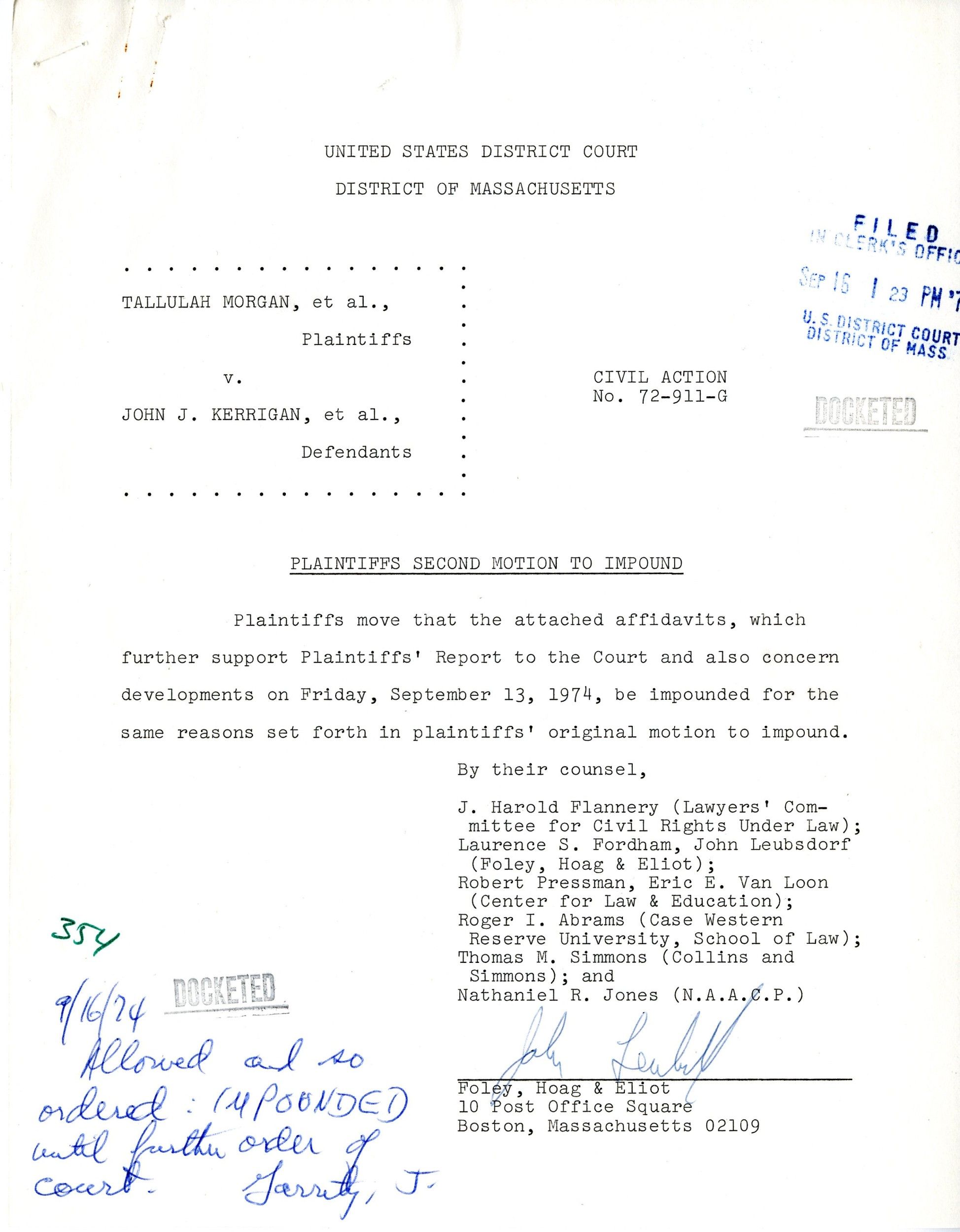
Plaintiff's Second Motion to Impound
Page 2
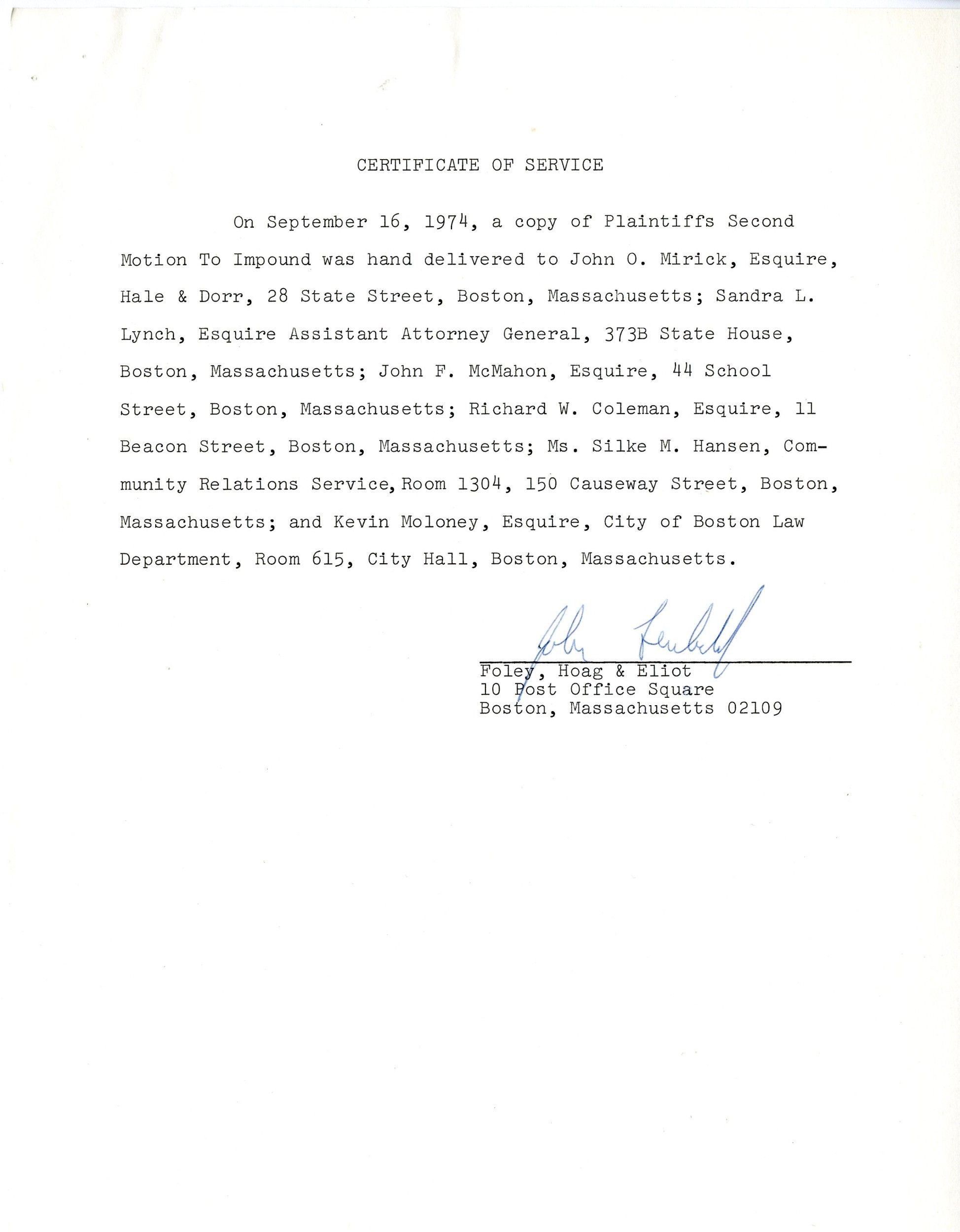
Plaintiff's Second Motion to Impound
Page 3
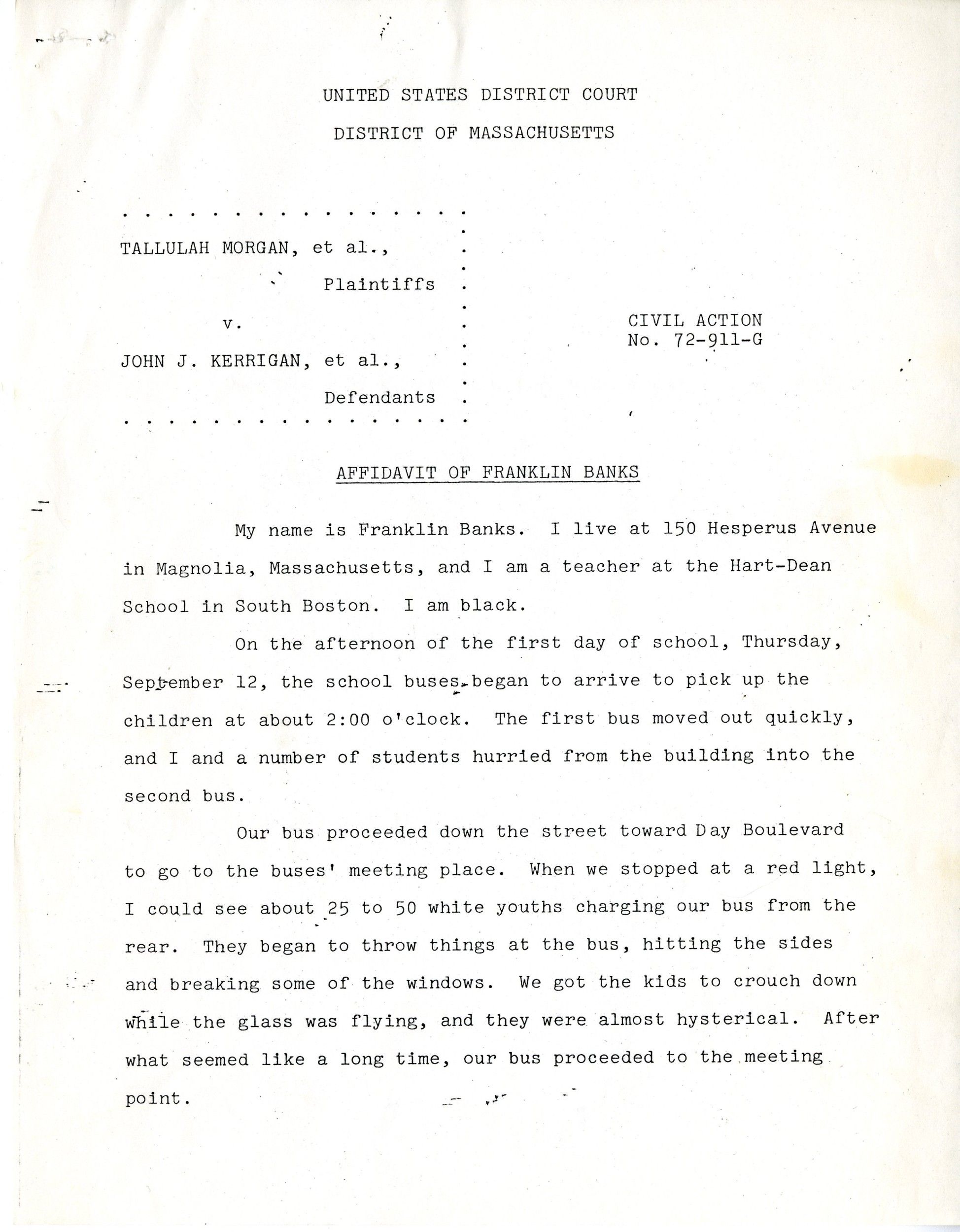
Plaintiff's Second Motion to Impound
Page 4
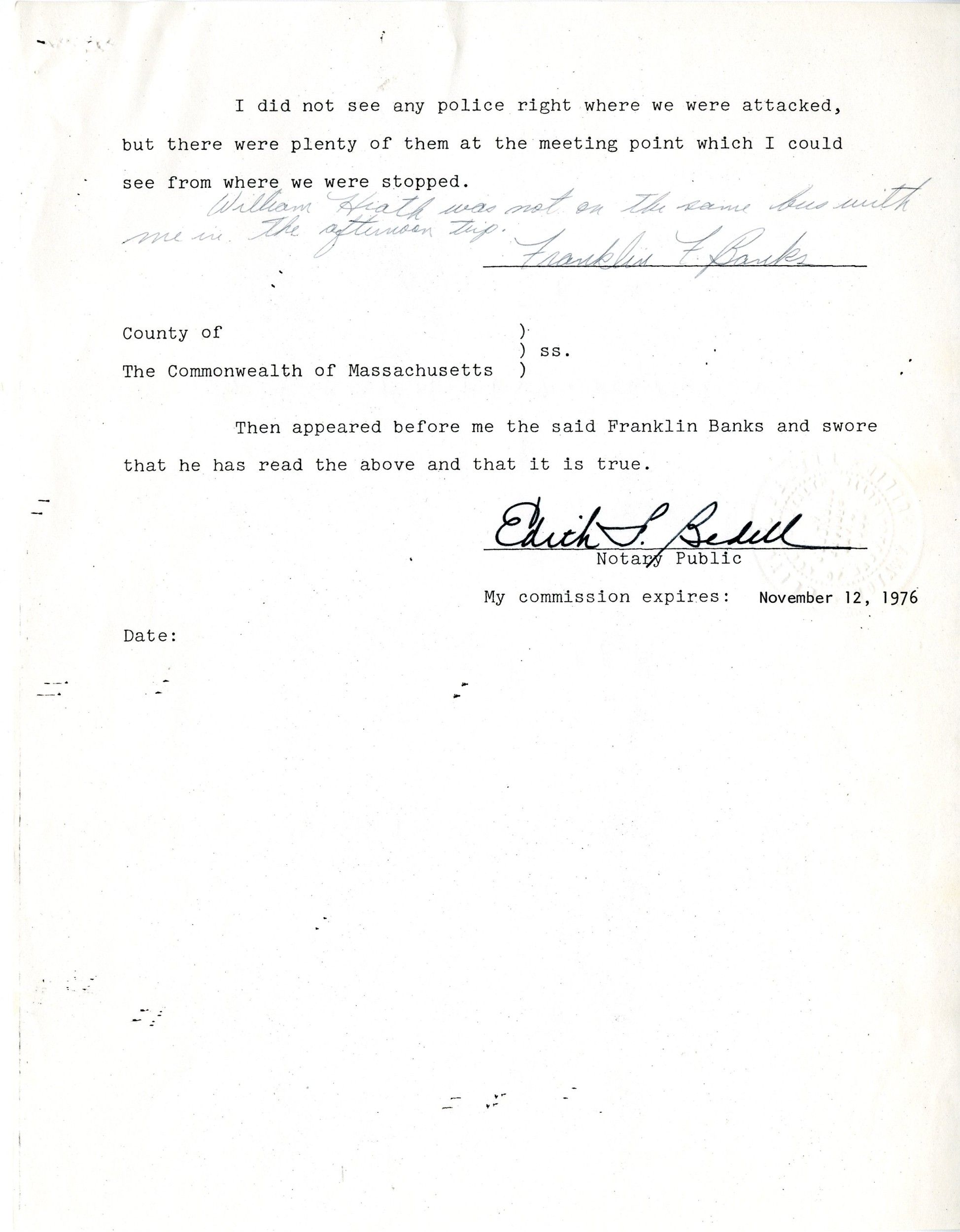
Plaintiff's Second Motion to Impound
Page 5
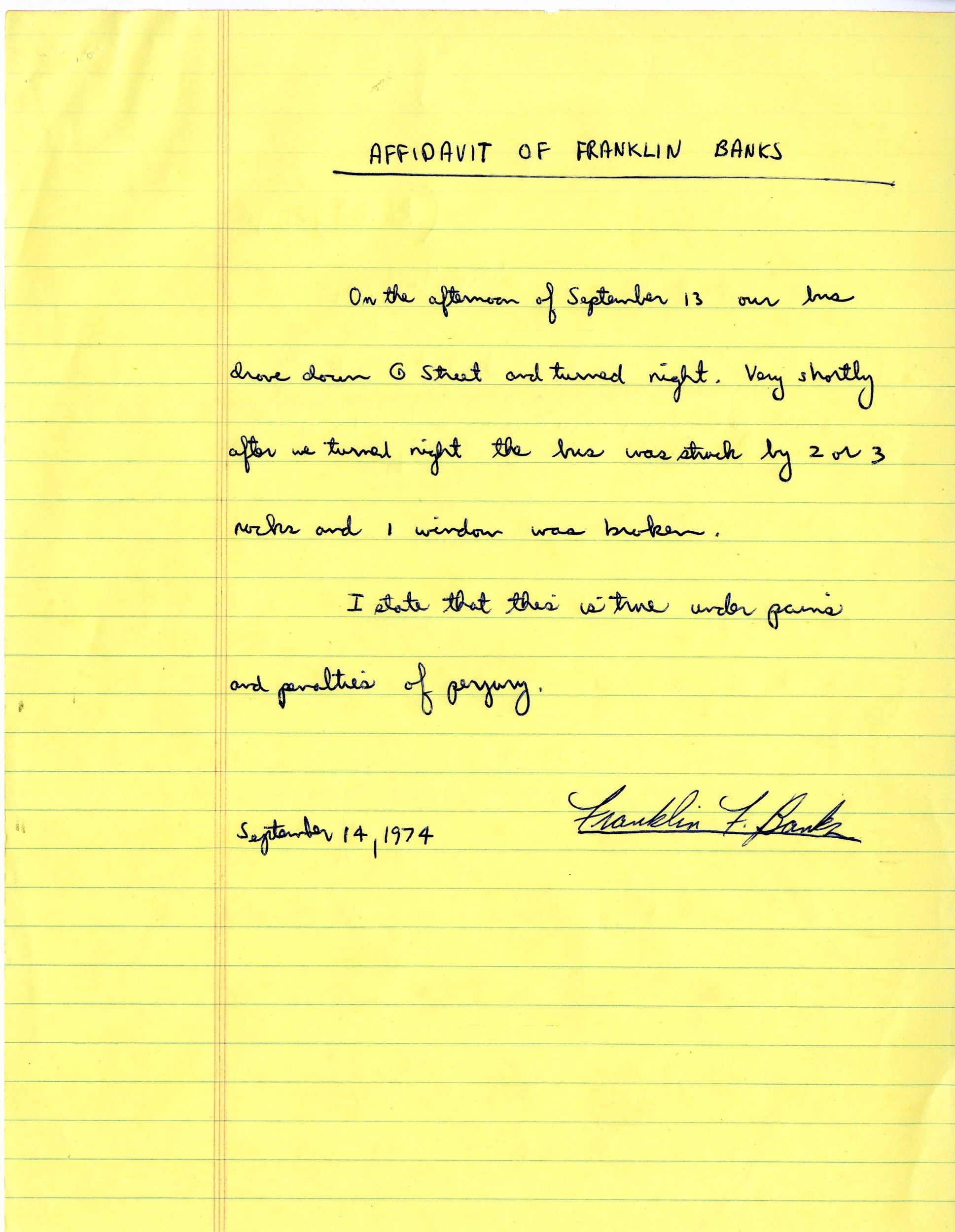
Plaintiff's Second Motion to Impound
Page 6

Plaintiff's Second Motion to Impound
Page 7
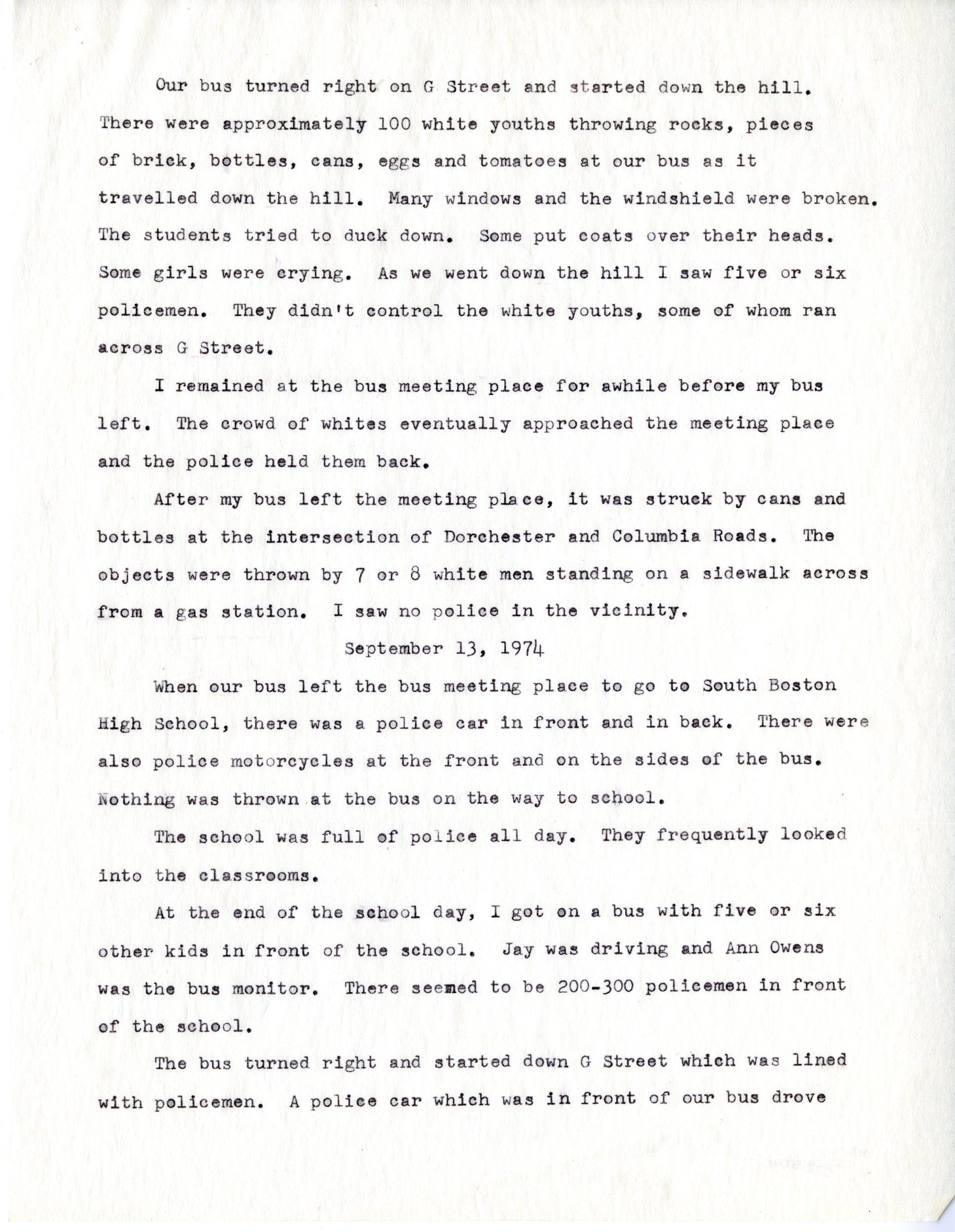
Plaintiff's Second Motion to Impound
Page 8
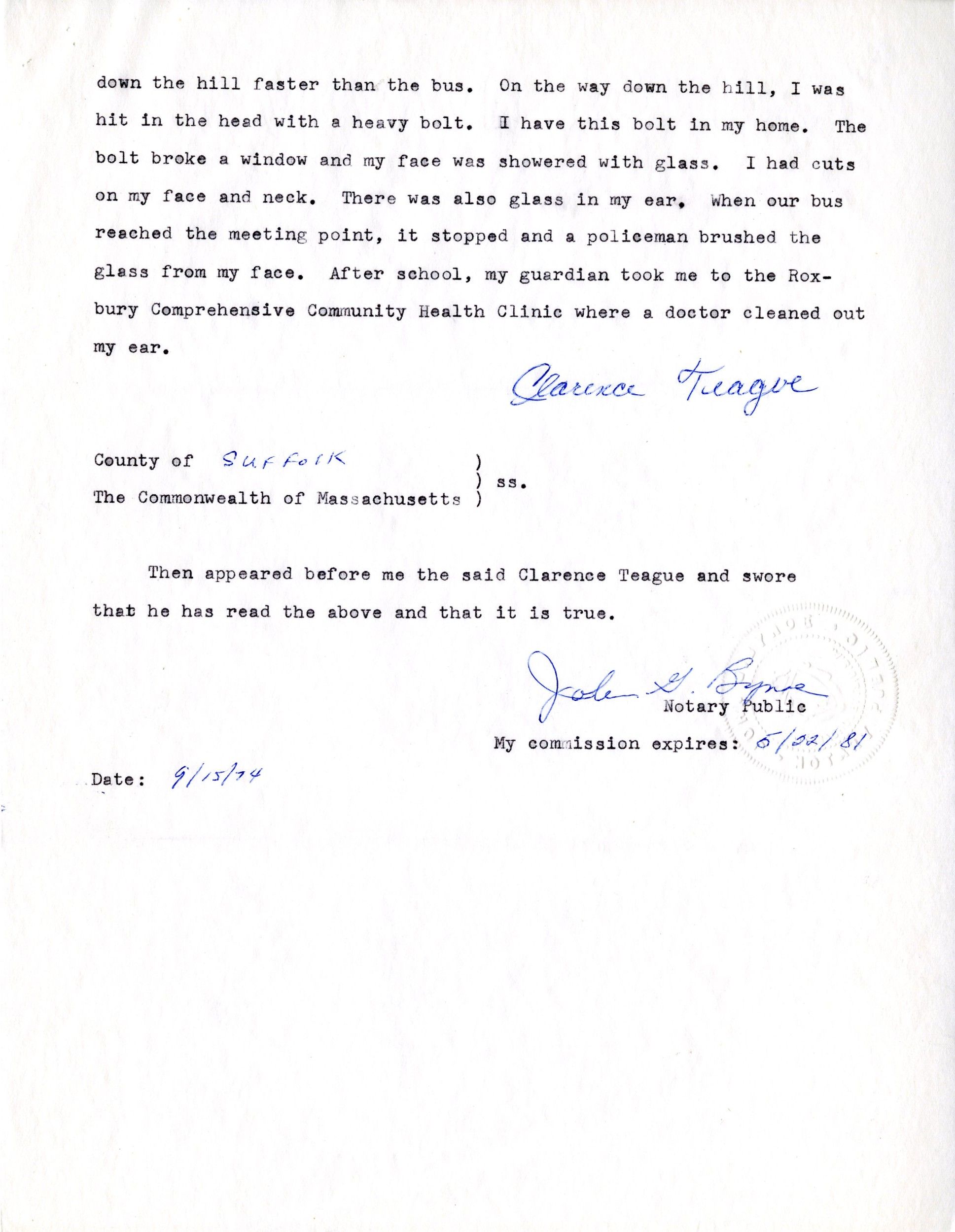
Plaintiff's Second Motion to Impound
Page 9
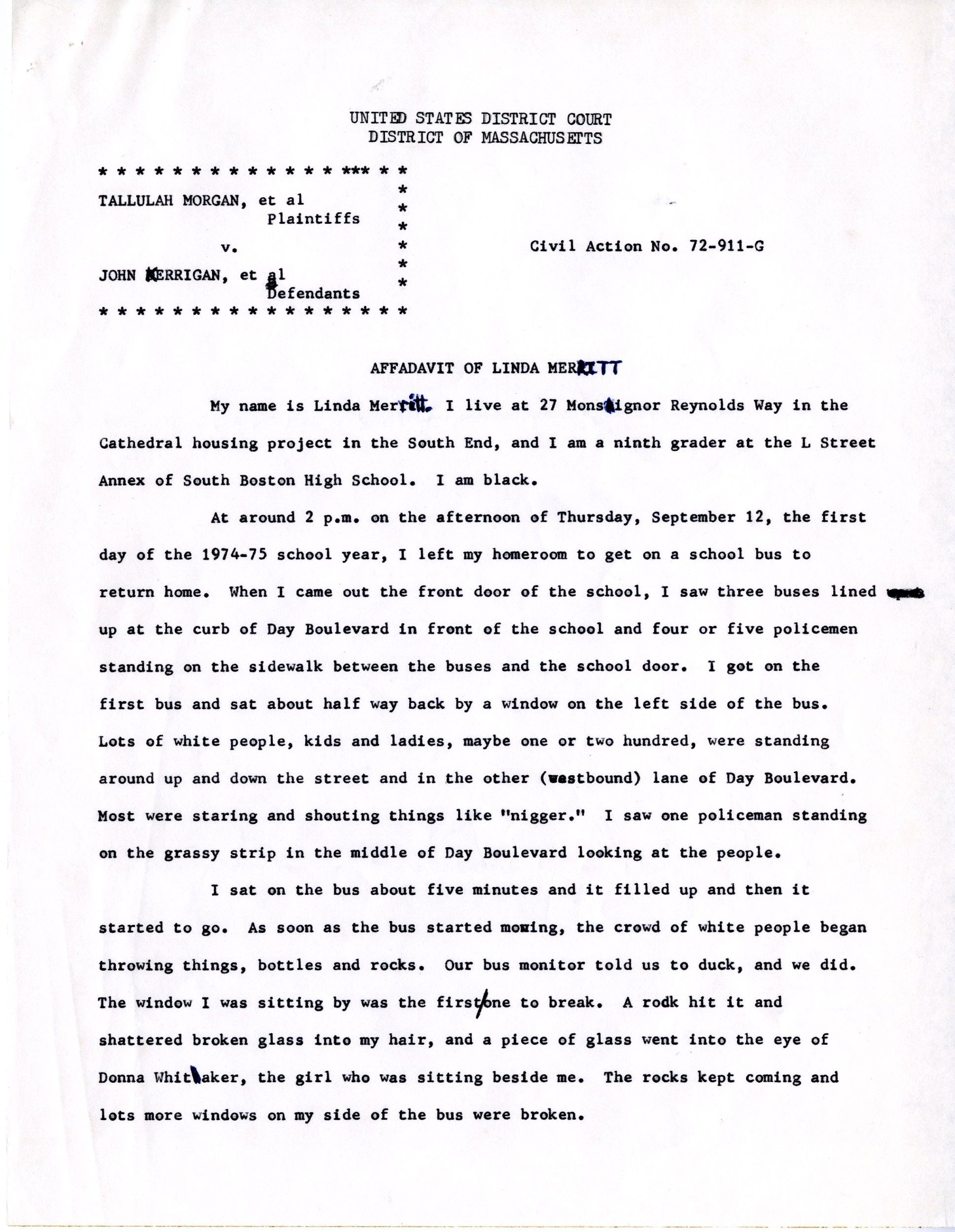
Plaintiff's Second Motion to Impound
Page 10
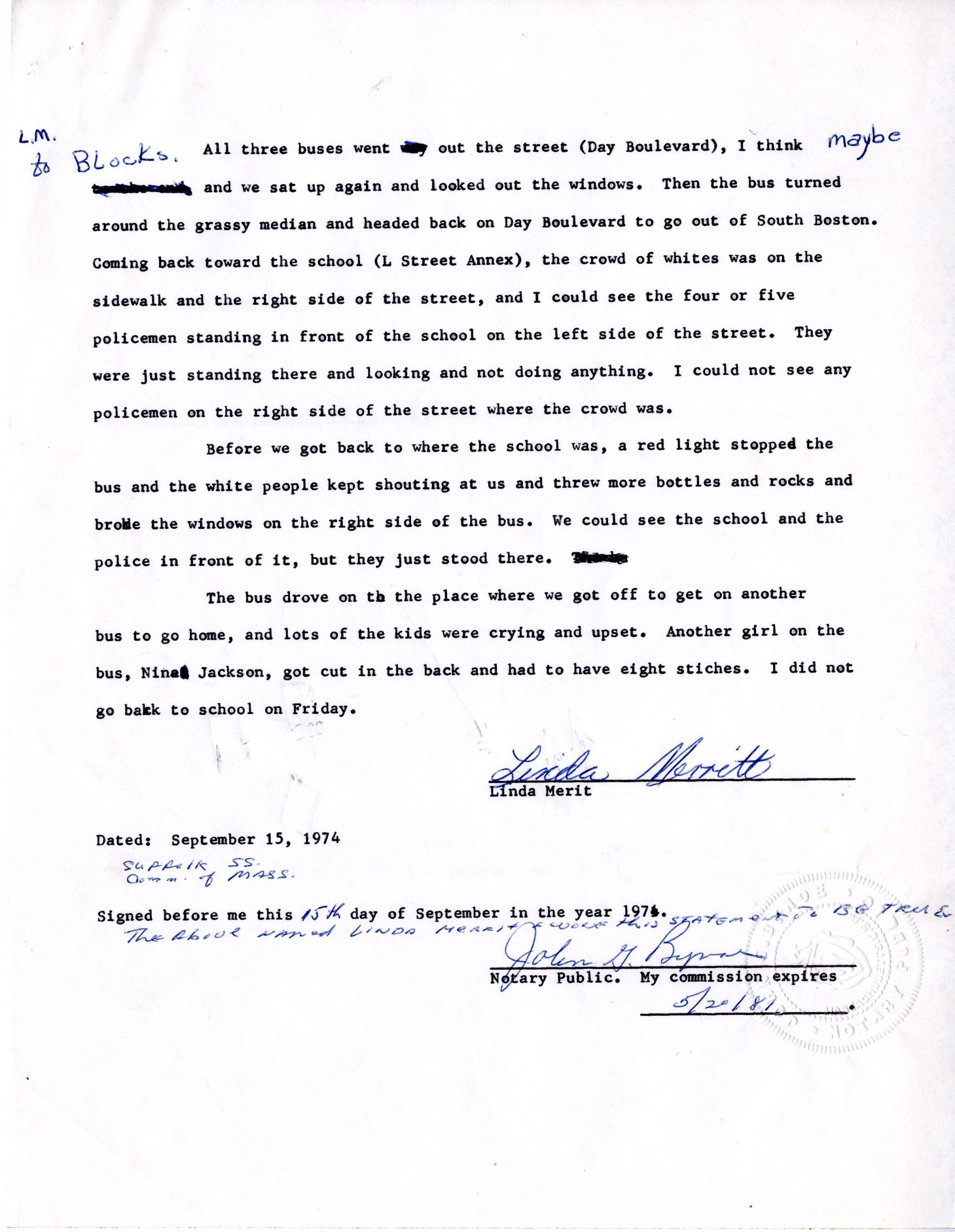
Plaintiff's Second Motion to Impound
Page 11
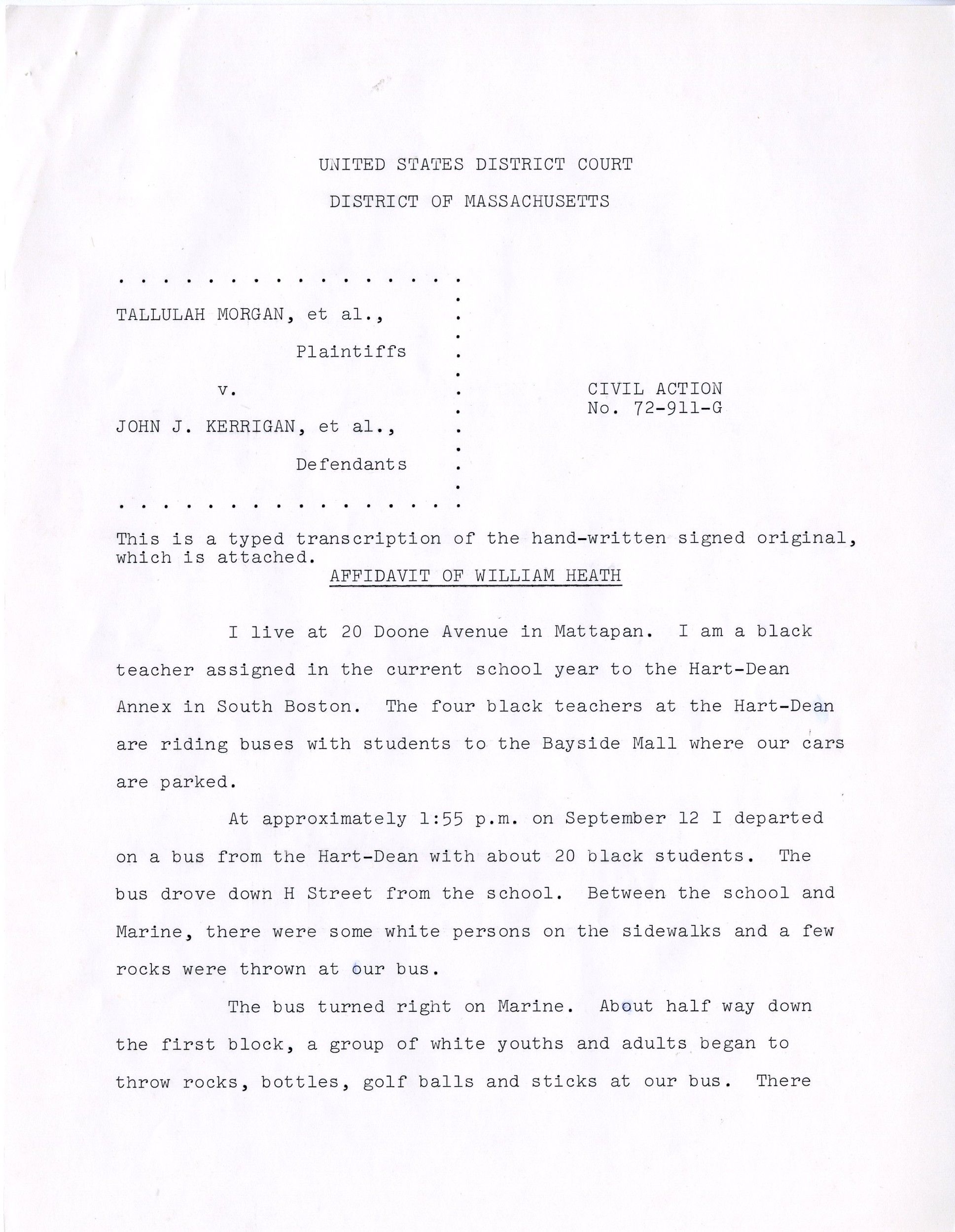
Plaintiff's Second Motion to Impound
Page 12
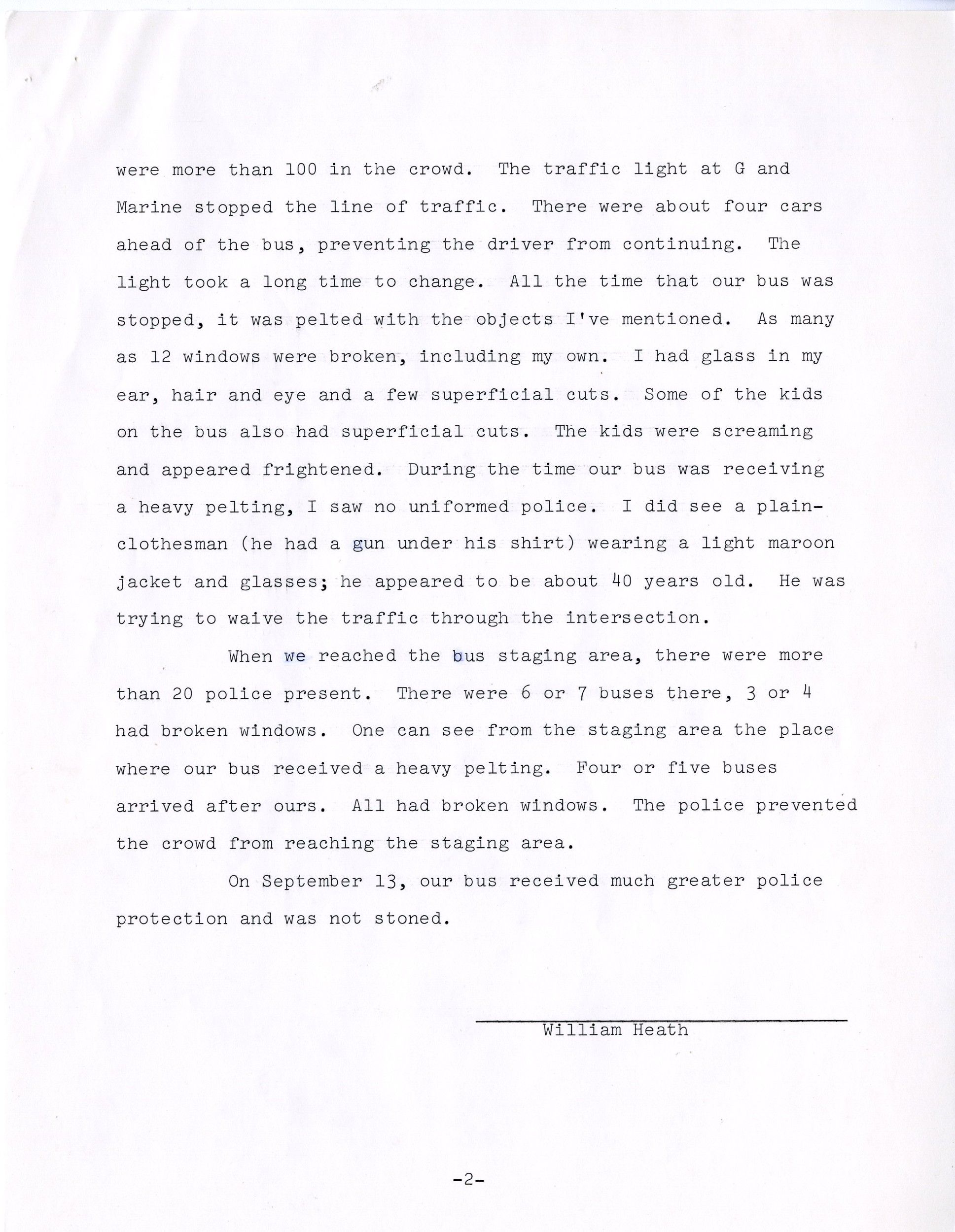
Plaintiff's Second Motion to Impound
Page 13
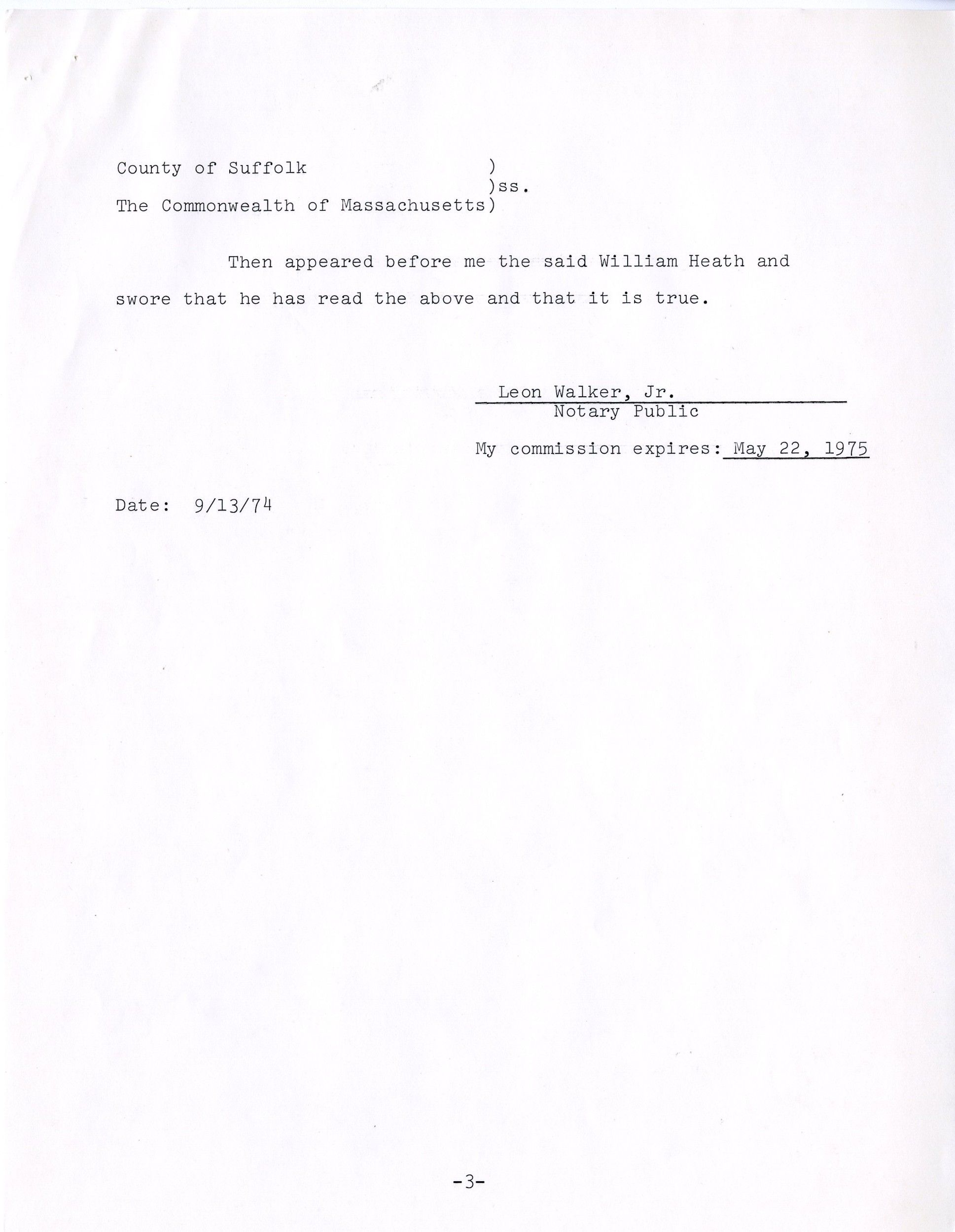
Plaintiff's Second Motion to Impound
Page 14
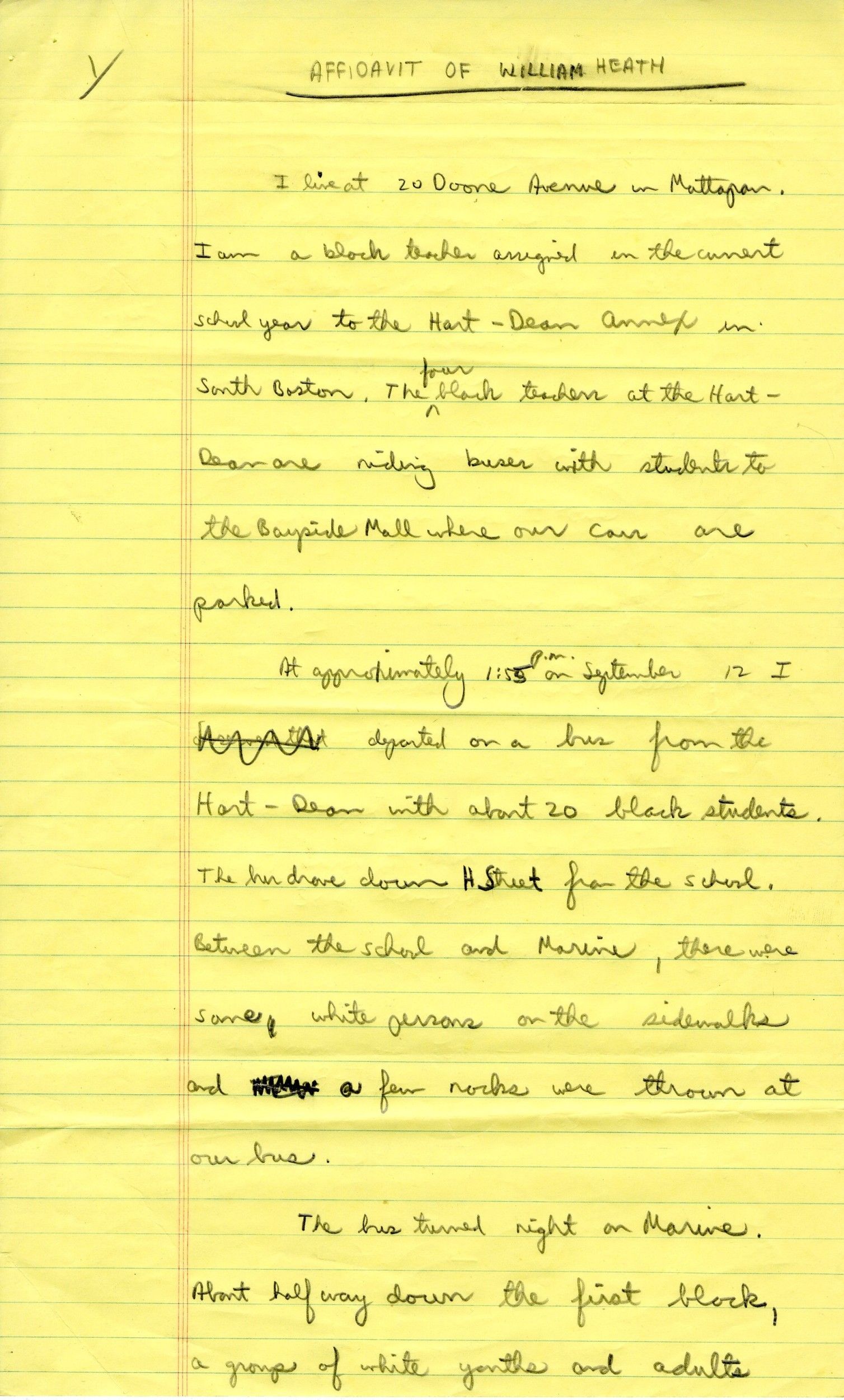
Plaintiff's Second Motion to Impound
Page 15
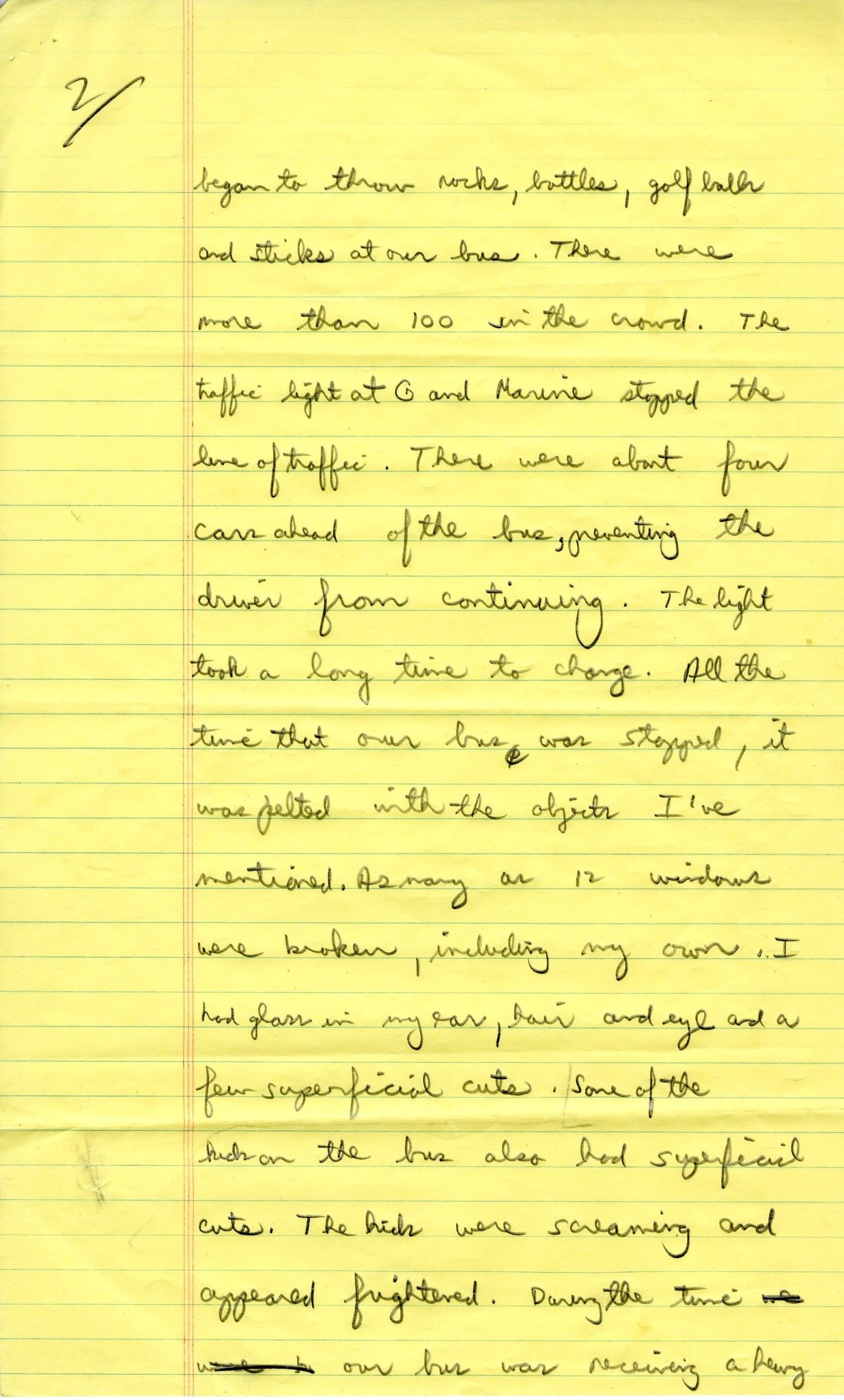
Plaintiff's Second Motion to Impound
Page 16
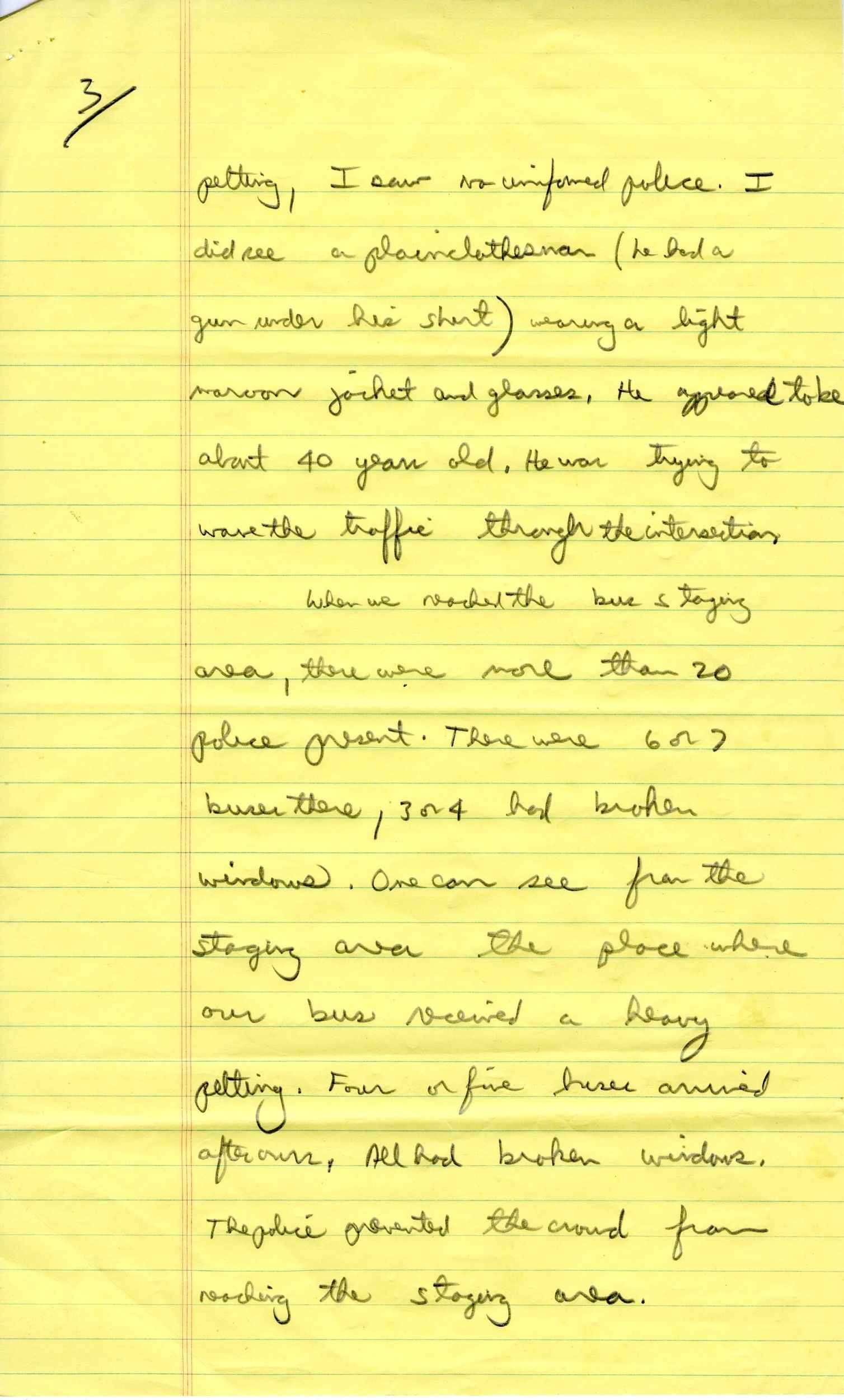
Plaintiff's Second Motion to Impound
Page 17
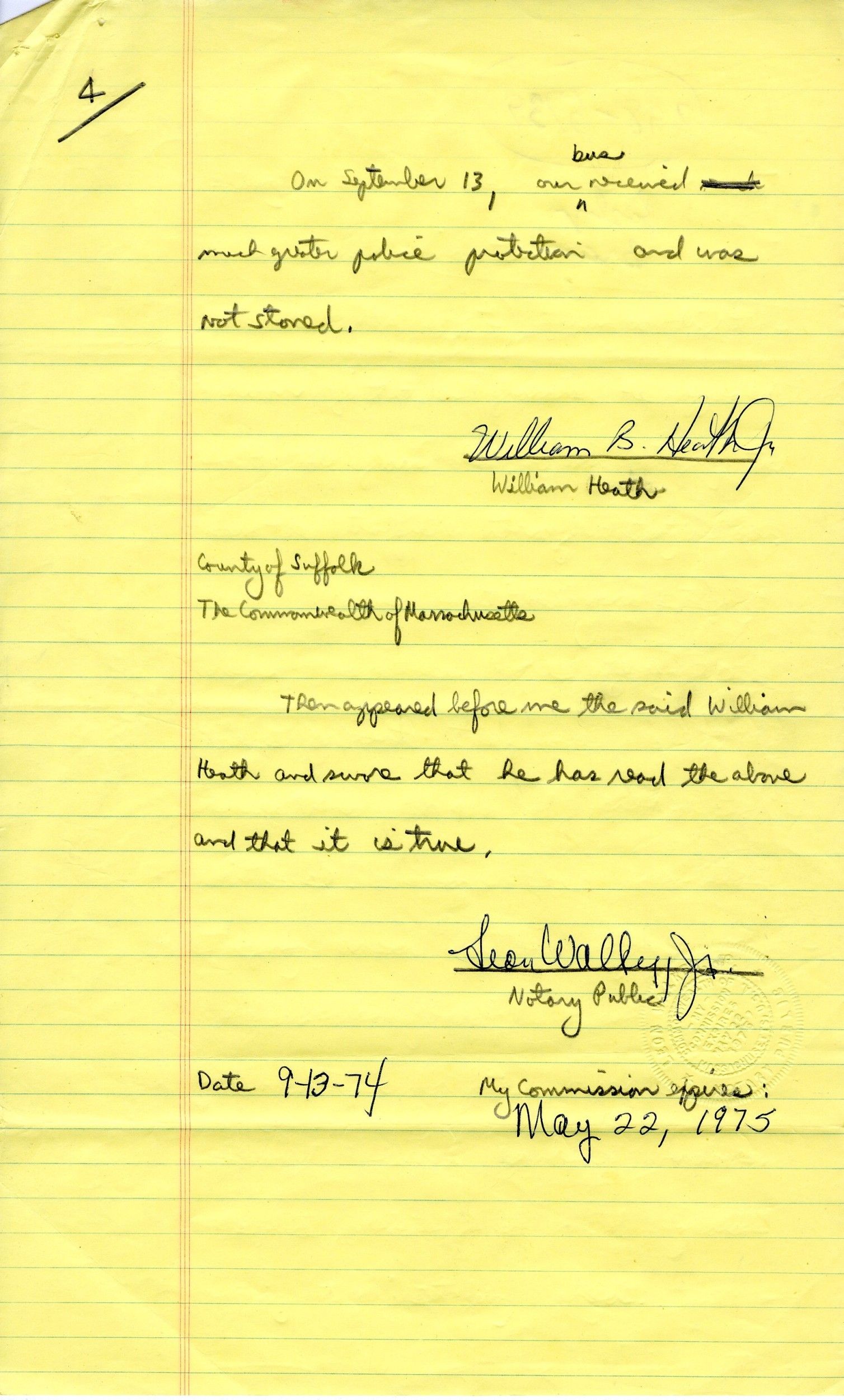
Document
Memorandum of the United States Regarding Deployment of United States Marshals in Boston Public Schools
10/9/1974
This memo comes from the court case Tallulah Morgan et al. v. James W. Hennigan et al. , known as the Boston Schools Desegregation Case. In 1972, parents of African American children brought a class action lawsuit alleging that the Boston School Committee violated the 14th Amendment of the U.S. Constitution by a deliberate policy of racial segregation. Judge W. Arthur Garrity, Jr. found that the Boston School Committee had intentionally carried out a program of segregation in the Boston Public Schools. The ruling, upheld unanimously by the U.S. Court of Appeals for the First Circuit, ordered the Boston School Committee to formulate a permanent school desegregation plan that addressed student assignment, teacher employment, and facility improvement procedures, as well as the use of busing on a citywide basis. The Boston School Committee failed to present an adequate plan, so the court assumed an active role in the formulation of the desegregation plan and oversaw implementation of court-ordered desegregation in the Boston public schools.
This primary source comes from the Records of District Courts of the United States.
National Archives Identifier: 4836722
Full Citation: Memorandum of the United States Regarding Deployment of United States Marshals in Boston Public Schools; 10/9/1974; Tallulah Morgan et al v. James W. Hennigan et al Case File, 1972 - 1991; Civil Action Case Files, 1938 - 1998; Records of District Courts of the United States, . [Online Version, https://www.docsteach.org/documents/document/memorandum-of-the-united-states-regarding-deployment-of-united-states-marshals-in-boston-public-schools, April 18, 2024]Memorandum of the United States Regarding Deployment of United States Marshals in Boston Public Schools
Page 1
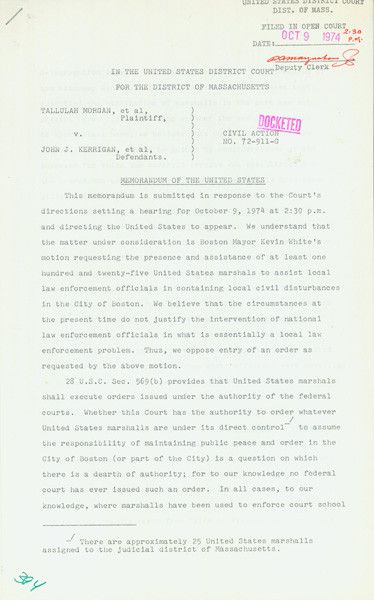
Memorandum of the United States Regarding Deployment of United States Marshals in Boston Public Schools
Page 2
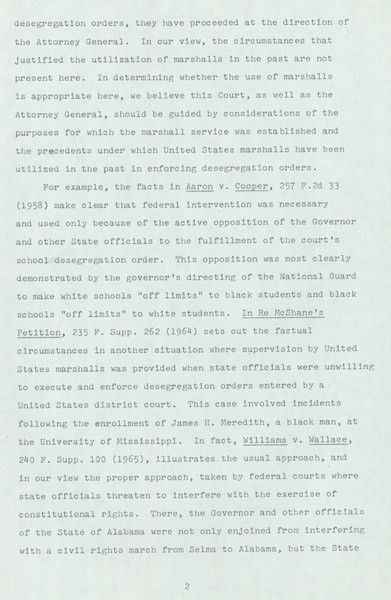
Memorandum of the United States Regarding Deployment of United States Marshals in Boston Public Schools
Page 4
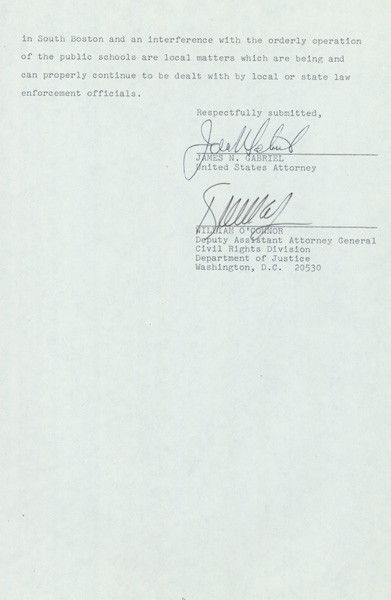
Memorandum of the United States Regarding Deployment of United States Marshals in Boston Public Schools
Page 3

Document
Memorandum to the Court of the Inadvisability of the Use of National Guard Forces in the Event of Urban Civil Disorders and Unrest
10/16/1974
This memorandum from Mayor Kevin White's attorney to the court advises against National Guard intervention in the Boston schools desegregation crisis. It comes from the court case Tallulah Morgan et al. v. James W. Hennigan et al., known as the Boston Schools Desegregation Case. In 1972, parents of African American children brought a class action lawsuit alleging that the Boston School Committee violated the 14th Amendment of the U.S. Constitution by a deliberate policy of racial segregation. Judge W. Arthur Garrity, Jr. found that the Boston School Committee had intentionally carried out a program of segregation in the Boston Public Schools. The ruling, upheld unanimously by the U.S. Court of Appeals for the First Circuit, ordered the Boston School Committee to formulate a permanent school desegregation plan that addressed student assignment, teacher employment, and facility improvement procedures, as well as the use of busing on a citywide basis. The Boston School Committee failed to present an adequate plan, so the court assumed an active role in the formulation of the desegregation plan and oversaw implementation of court-ordered desegregation in the Boston public schools." This document was digitized by teachers in our Primarily Teaching 2014 Summer Workshop in Boston.
This primary source comes from the Records of District Courts of the United States.
National Archives Identifier: 12161218
Full Citation: Memorandum to the Court of the Inadvisability of the Use of National Guard Forces in the Event of Urban Civil Disorders and Unrest; 10/16/1974; Tallulah Morgan et al v. James W. Hennigan et al Case File, 1972 - 1991; Civil Action Case Files, 1938 - 1998; Records of District Courts of the United States, ; National Archives at Boston, Waltham, MA. [Online Version, https://www.docsteach.org/documents/document/memorandum-inadvisability-national-guard, April 18, 2024]Memorandum to the Court of the Inadvisability of the Use of National Guard Forces in the Event of Urban Civil Disorders and Unrest
Page 1
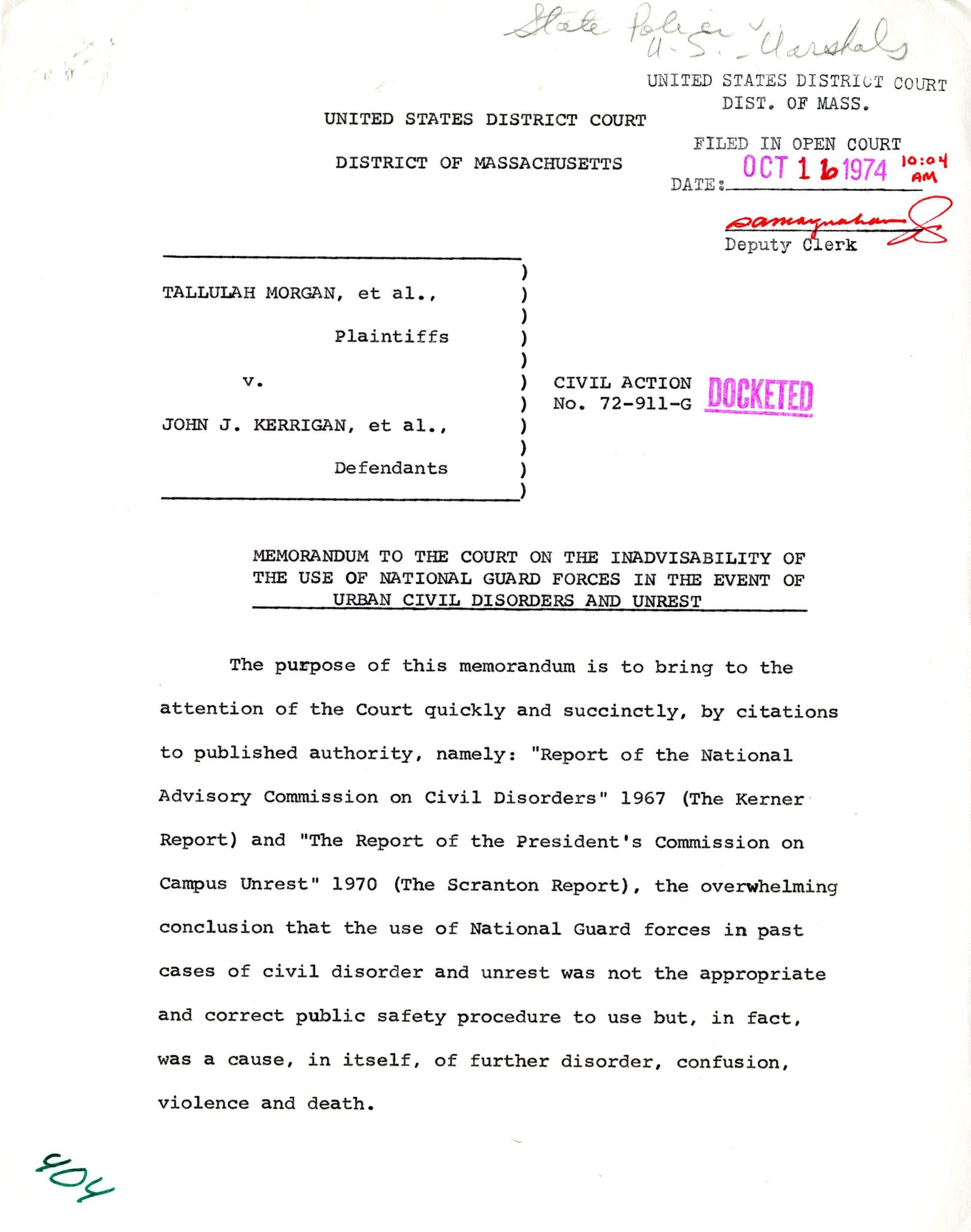
Memorandum to the Court of the Inadvisability of the Use of National Guard Forces in the Event of Urban Civil Disorders and Unrest
Page 2
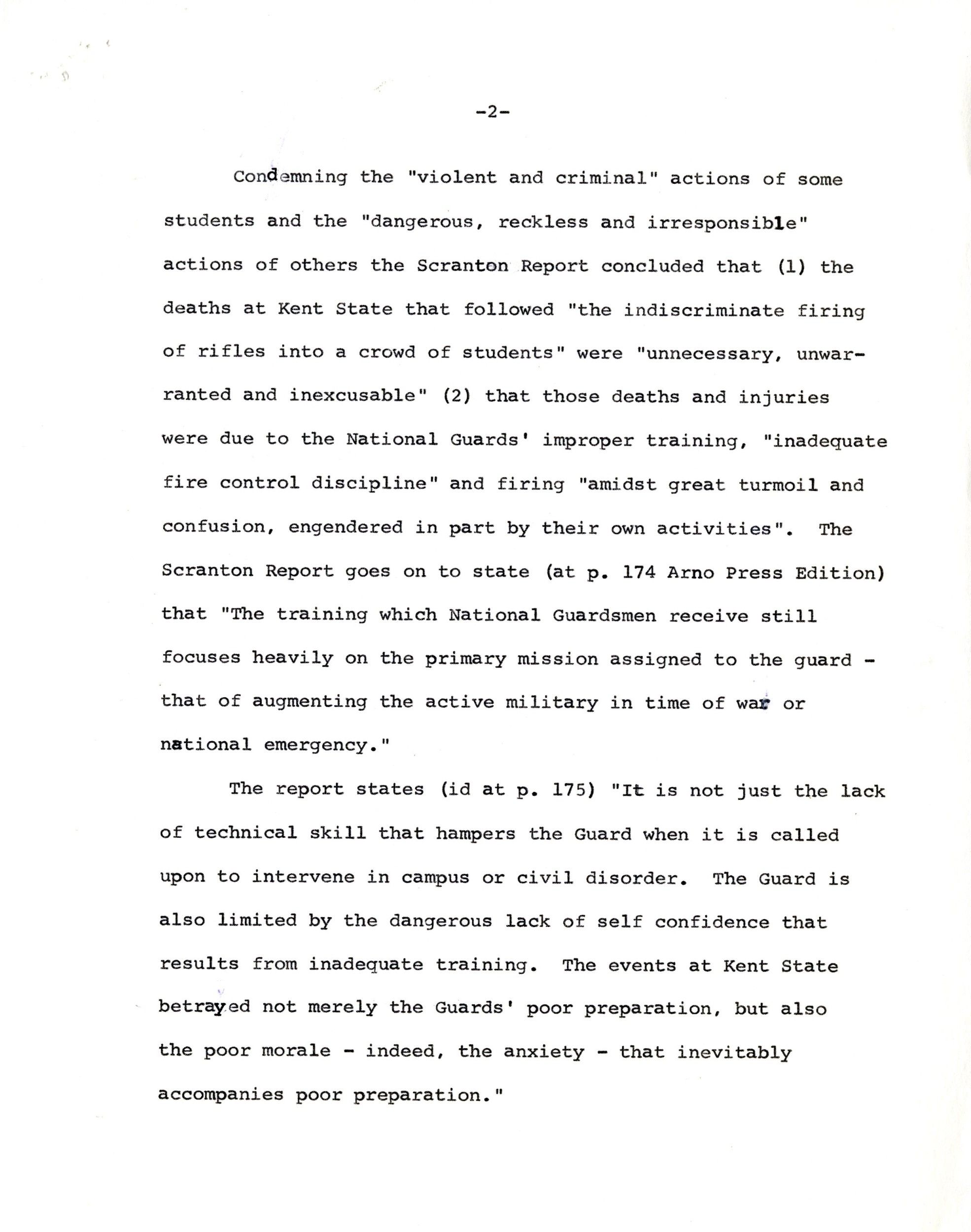
Memorandum to the Court of the Inadvisability of the Use of National Guard Forces in the Event of Urban Civil Disorders and Unrest
Page 3

Memorandum to the Court of the Inadvisability of the Use of National Guard Forces in the Event of Urban Civil Disorders and Unrest
Page 4

Memorandum to the Court of the Inadvisability of the Use of National Guard Forces in the Event of Urban Civil Disorders and Unrest
Page 5
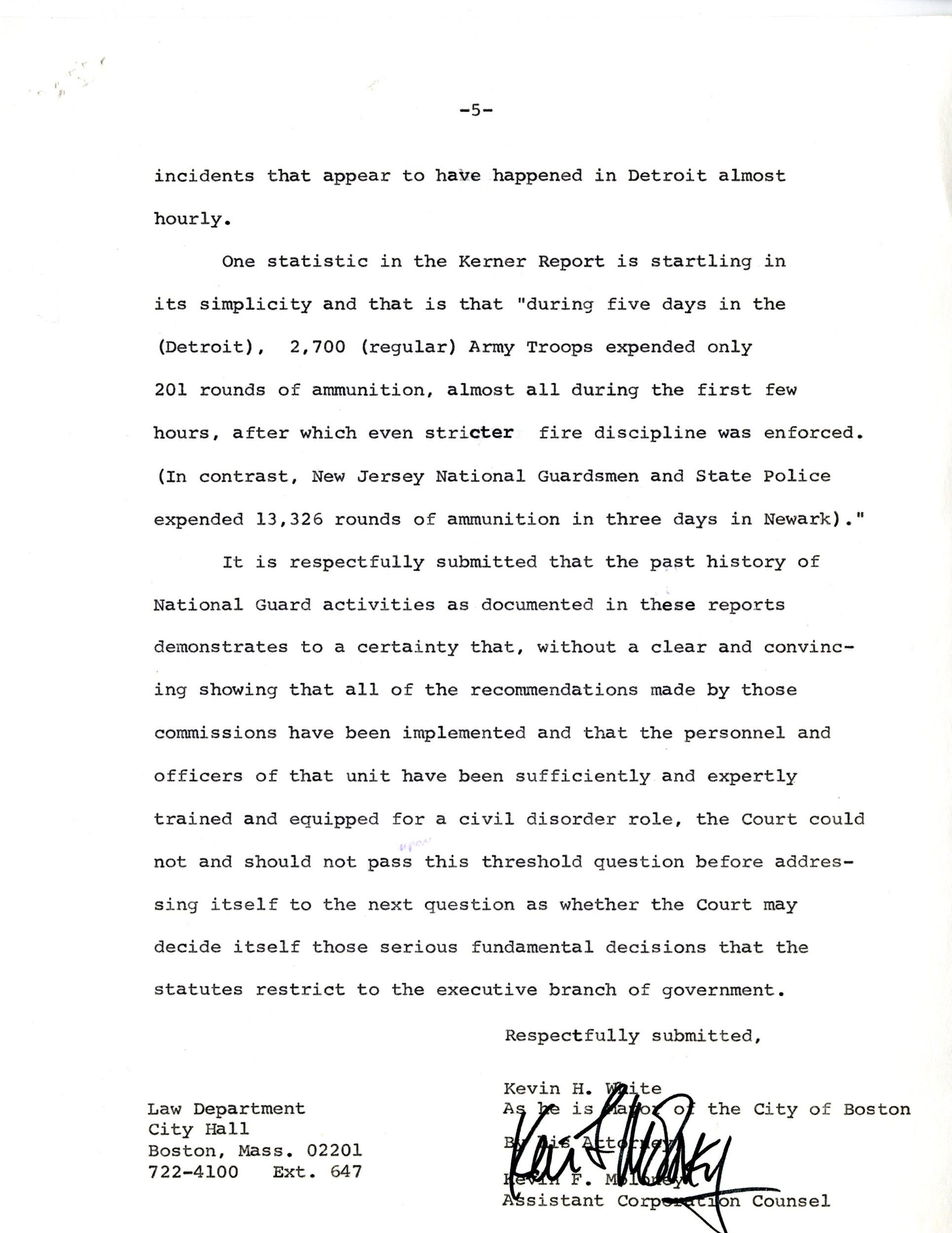
Memorandum to the Court of the Inadvisability of the Use of National Guard Forces in the Event of Urban Civil Disorders and Unrest
Page 6

Memorandum to the Court of the Inadvisability of the Use of National Guard Forces in the Event of Urban Civil Disorders and Unrest
Page 7

Memorandum to the Court of the Inadvisability of the Use of National Guard Forces in the Event of Urban Civil Disorders and Unrest
Page 8

Memorandum to the Court of the Inadvisability of the Use of National Guard Forces in the Event of Urban Civil Disorders and Unrest
Page 9
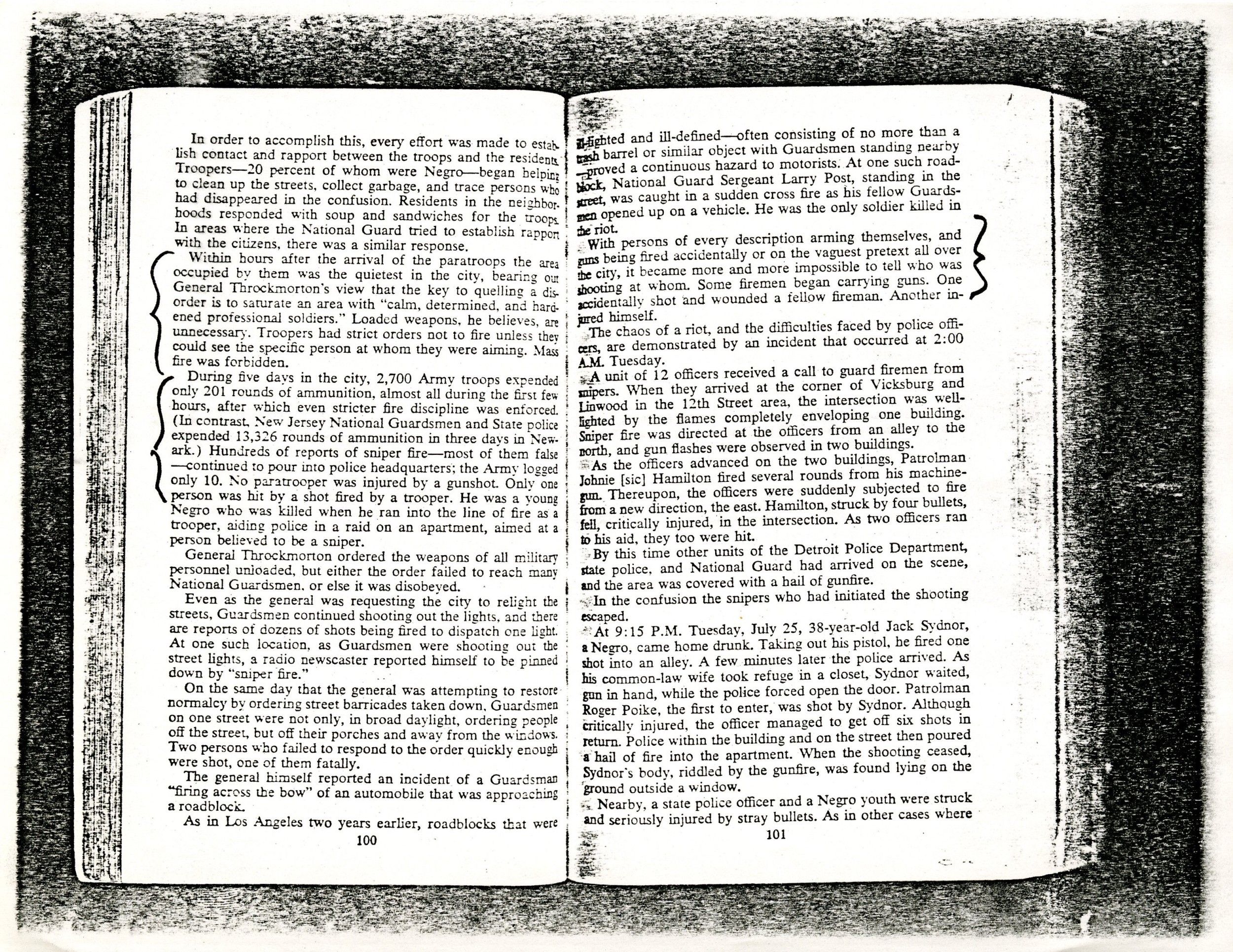
Memorandum to the Court of the Inadvisability of the Use of National Guard Forces in the Event of Urban Civil Disorders and Unrest
Page 10
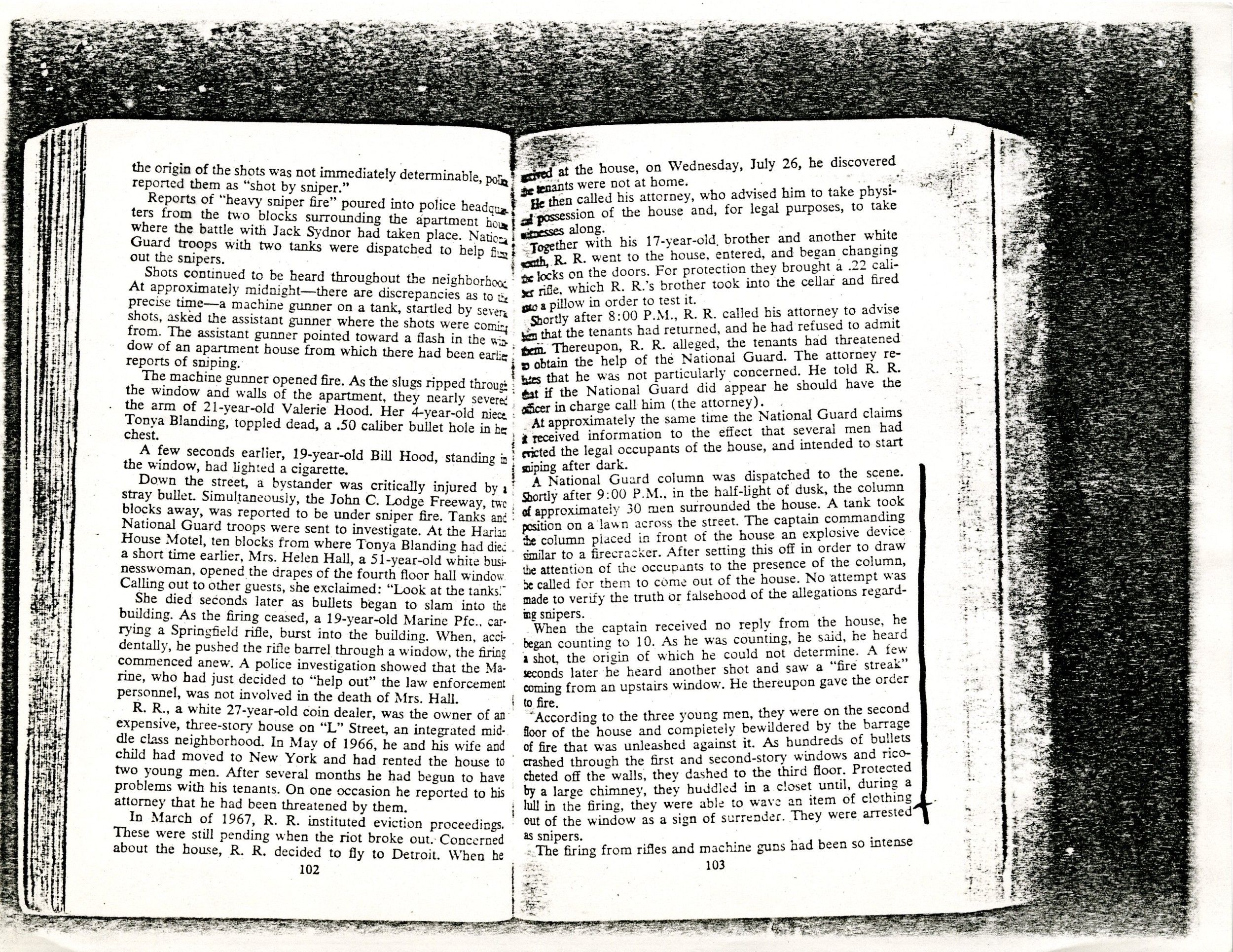
Document
Memorandum Regarding Deployment of Police for South Boston
1/8/1975
This memo comes from the court case Tallulah Morgan et al. v. James W. Hennigan et al., known as the Boston Schools Desegregation Case. In 1972, parents of African American children brought a class action lawsuit alleging that the Boston School Committee violated the 14th Amendment of the U.S. Constitution by a deliberate policy of racial segregation. Judge W. Arthur Garrity, Jr. found that the Boston School Committee had intentionally carried out a program of segregation in the Boston Public Schools. The ruling, upheld unanimously by the U.S. Court of Appeals for the First Circuit, ordered the Boston School Committee to formulate a permanent school desegregation plan that addressed student assignment, teacher employment, and facility improvement procedures, as well as the use of busing on a citywide basis. The Boston School Committee failed to present an adequate plan, so the court assumed an active role in the formulation of the desegregation plan and oversaw implementation of court-ordered desegregation in the Boston public schools.
This primary source comes from the Records of District Courts of the United States.
National Archives Identifier: 4835136
Full Citation: Memorandum Regarding Deployment of Police for South Boston; 1/8/1975; Tallulah Morgan et al v. James W. Hennigan et al Case File, 1972 - 1991; Civil Action Case Files, 1938 - 1998; Records of District Courts of the United States, . [Online Version, https://www.docsteach.org/documents/document/memorandum-regarding-deployment-of-police-for-south-boston, April 18, 2024]Memorandum Regarding Deployment of Police for South Boston
Page 1
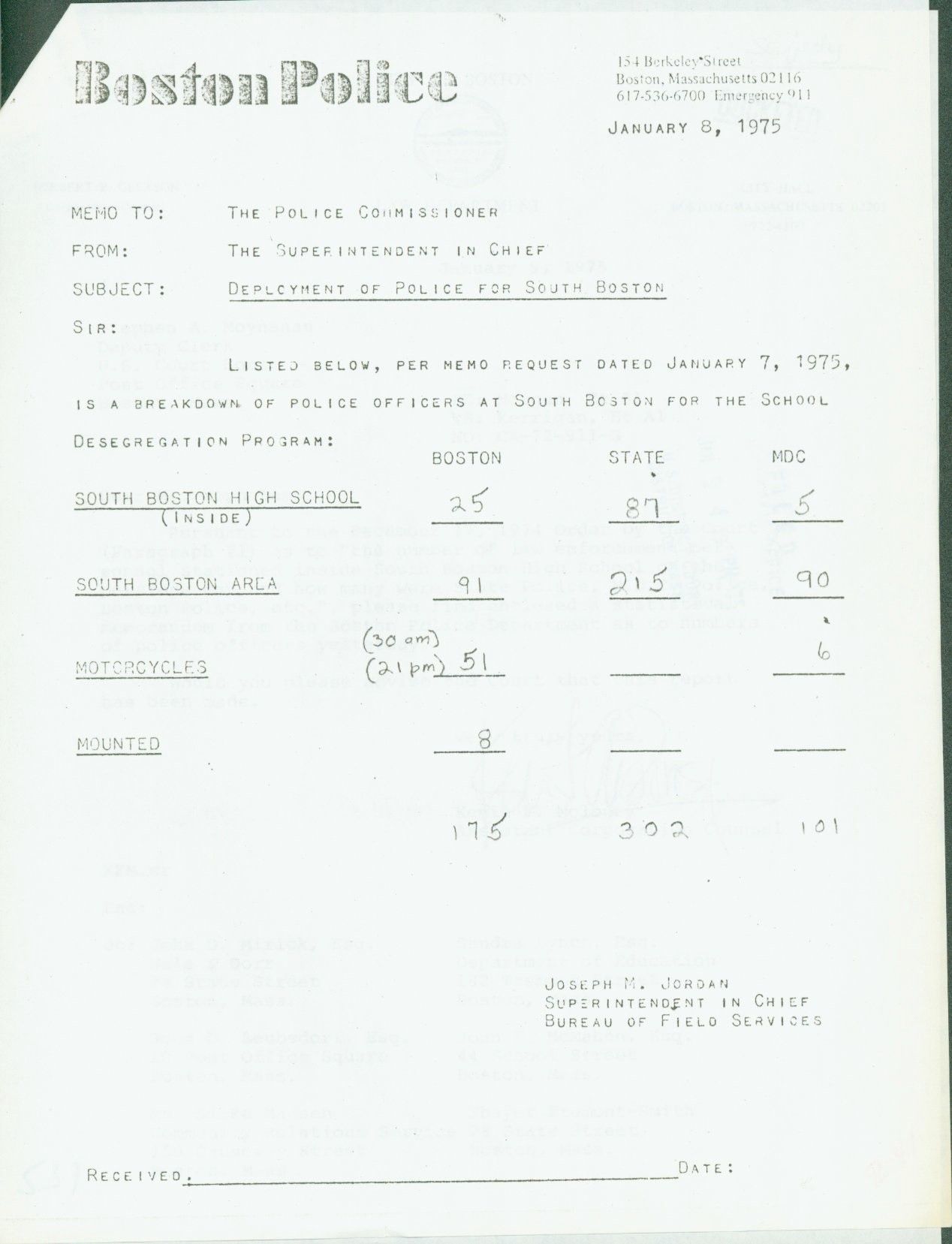
Document
Letter from Kevin Moloney, Assistant Corporation Counsel for the City of Boston, to Judge W. Arthur Garrity
1/22/1975
This cover letter from the Assistant Corporation Counsel for the City of Boston discusses police manpower levels and refers to recommendations made by city officials John Kehoe and Laurence Carpenter. It comes from the court case Tallulah Morgan et al. v. James W. Hennigan et al., known as the Boston Schools Desegregation Case. In 1972, parents of African American children brought a class action lawsuit alleging that the Boston School Committee violated the 14th Amendment of the U.S. Constitution by a deliberate policy of racial segregation. Judge W. Arthur Garrity, Jr. found that the Boston School Committee had intentionally carried out a program of segregation in the Boston Public Schools. The ruling, upheld unanimously by the U.S. Court of Appeals for the First Circuit, ordered the Boston School Committee to formulate a permanent school desegregation plan that addressed student assignment, teacher employment, and facility improvement procedures, as well as the use of busing on a citywide basis. The Boston School Committee failed to present an adequate plan, so the court assumed an active role in the formulation of the desegregation plan and oversaw implementation of court-ordered desegregation in the Boston public schools. This document was digitized by teachers in our Primarily Teaching 2014 Summer Workshop in Boston.
This primary source comes from the Records of District Courts of the United States.
National Archives Identifier: 12161214
Full Citation: Letter from Kevin Moloney, Assistant Corporation Counsel for the City of Boston, to Judge W. Arthur Garrity; 1/22/1975; Tallulah Morgan et al v. James W. Hennigan et al Case File, 1972 - 1991; Civil Action Case Files, 1938 - 1998; Records of District Courts of the United States, ; National Archives at Boston, Waltham, MA. [Online Version, https://www.docsteach.org/documents/document/letter-kevin-moloney, April 18, 2024]Letter from Kevin Moloney, Assistant Corporation Counsel for the City of Boston, to Judge W. Arthur Garrity
Page 1
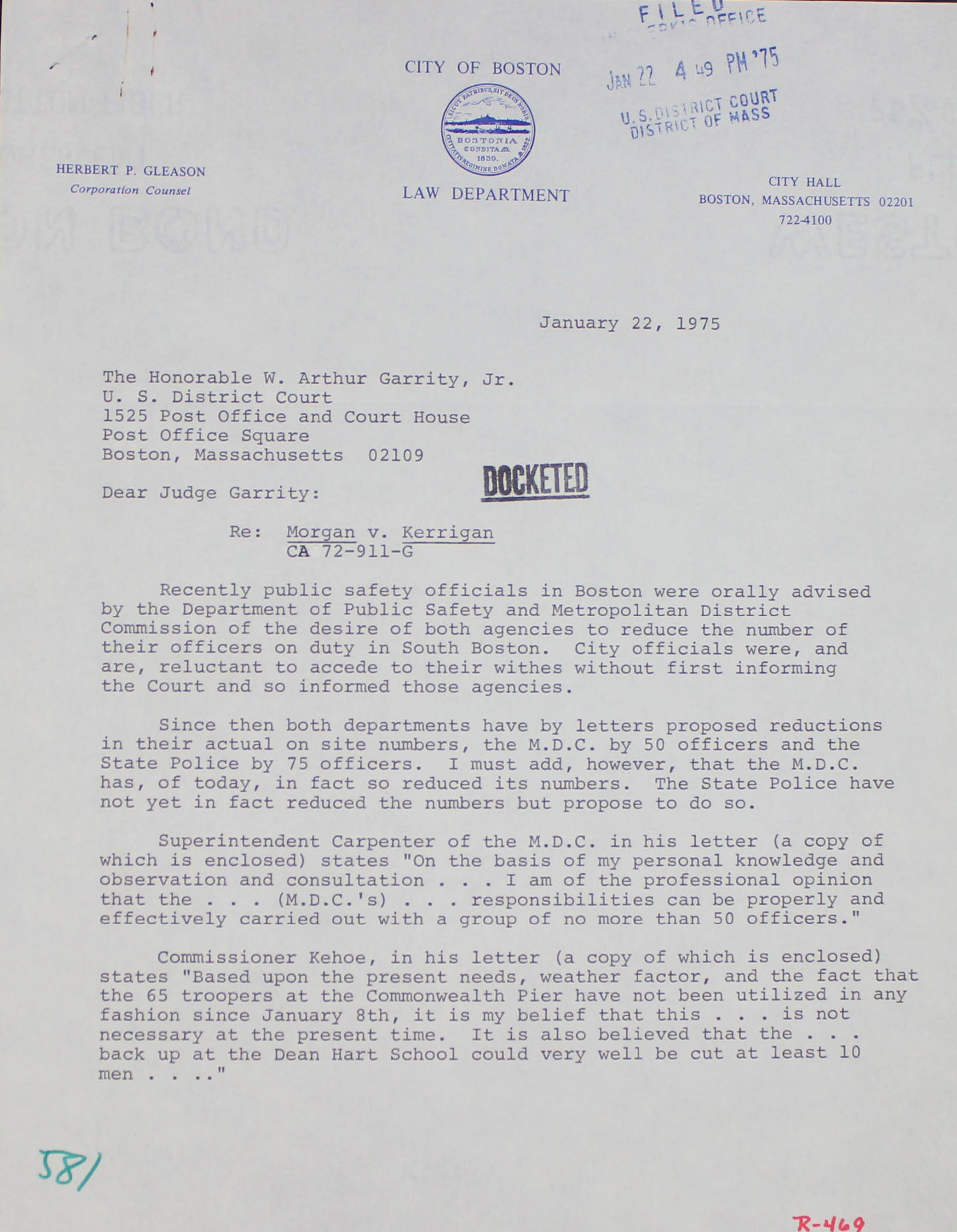
Letter from Kevin Moloney, Assistant Corporation Counsel for the City of Boston, to Judge W. Arthur Garrity
Page 2
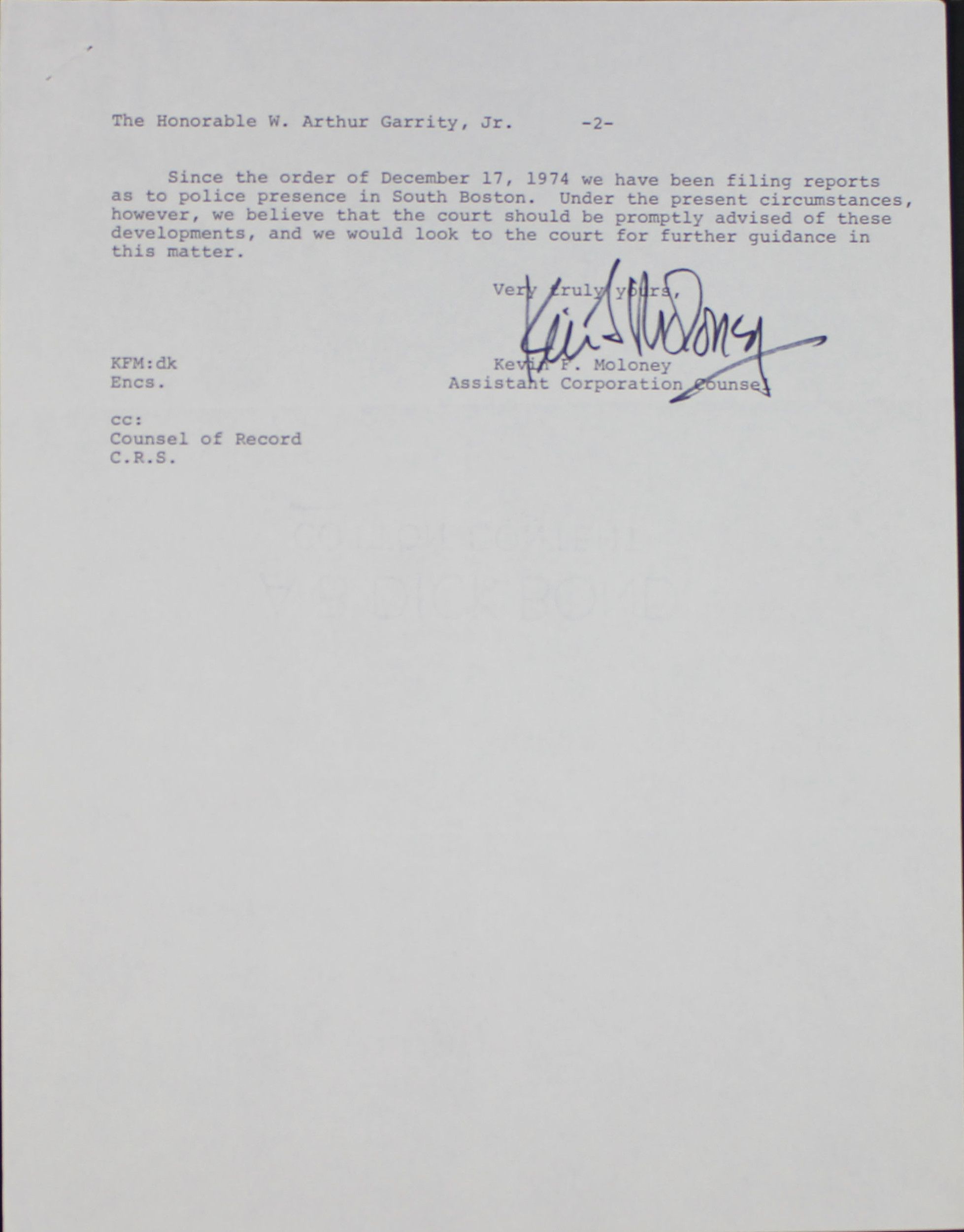
Document
Letter from Mrs. Sumner Bernstein to Boston Public Schools Superintendent Leary Regarding her Daughter's Experience at Boston English
10/22/1974
This letter comes from the court case Tallulah Morgan et al. v. James W. Hennigan et al., known as the Boston Schools Desegregation Case. In 1972, parents of African American children brought a class action lawsuit alleging that the Boston School Committee violated the 14th Amendment of the U.S. Constitution by a deliberate policy of racial segregation. Judge W. Arthur Garrity, Jr. found that the Boston School Committee had intentionally carried out a program of segregation in the Boston Public Schools. The ruling, upheld unanimously by the U.S. Court of Appeals for the First Circuit, ordered the Boston School Committee to formulate a permanent school desegregation plan that addressed student assignment, teacher employment, and facility improvement procedures, as well as the use of busing on a citywide basis. The Boston School Committee failed to present an adequate plan, so the court assumed an active role in the formulation of the desegregation plan and oversaw implementation of court-ordered desegregation in the Boston public schools. This document was digitized by teachers in our Primarily Teaching 2014 Summer Workshop in Boston.
This primary source comes from the Records of District Courts of the United States.
National Archives Identifier: 12161237
Full Citation: Letter from Mrs. Sumner Bernstein to Boston Public Schools Superintendent Leary Regarding her Daughter's Experience at Boston English; 10/22/1974; Tallulah Morgan et al v. James W. Hennigan et al Case File, 1972 - 1991; Civil Action Case Files, 1938 - 1998; Records of District Courts of the United States, ; National Archives at Boston, Waltham, MA. [Online Version, https://www.docsteach.org/documents/document/letter-boston-public-schools-superintendent-leary, April 18, 2024]Letter from Mrs. Sumner Bernstein to Boston Public Schools Superintendent Leary Regarding her Daughter's Experience at Boston English
Page 1

Letter from Mrs. Sumner Bernstein to Boston Public Schools Superintendent Leary Regarding her Daughter's Experience at Boston English
Page 2
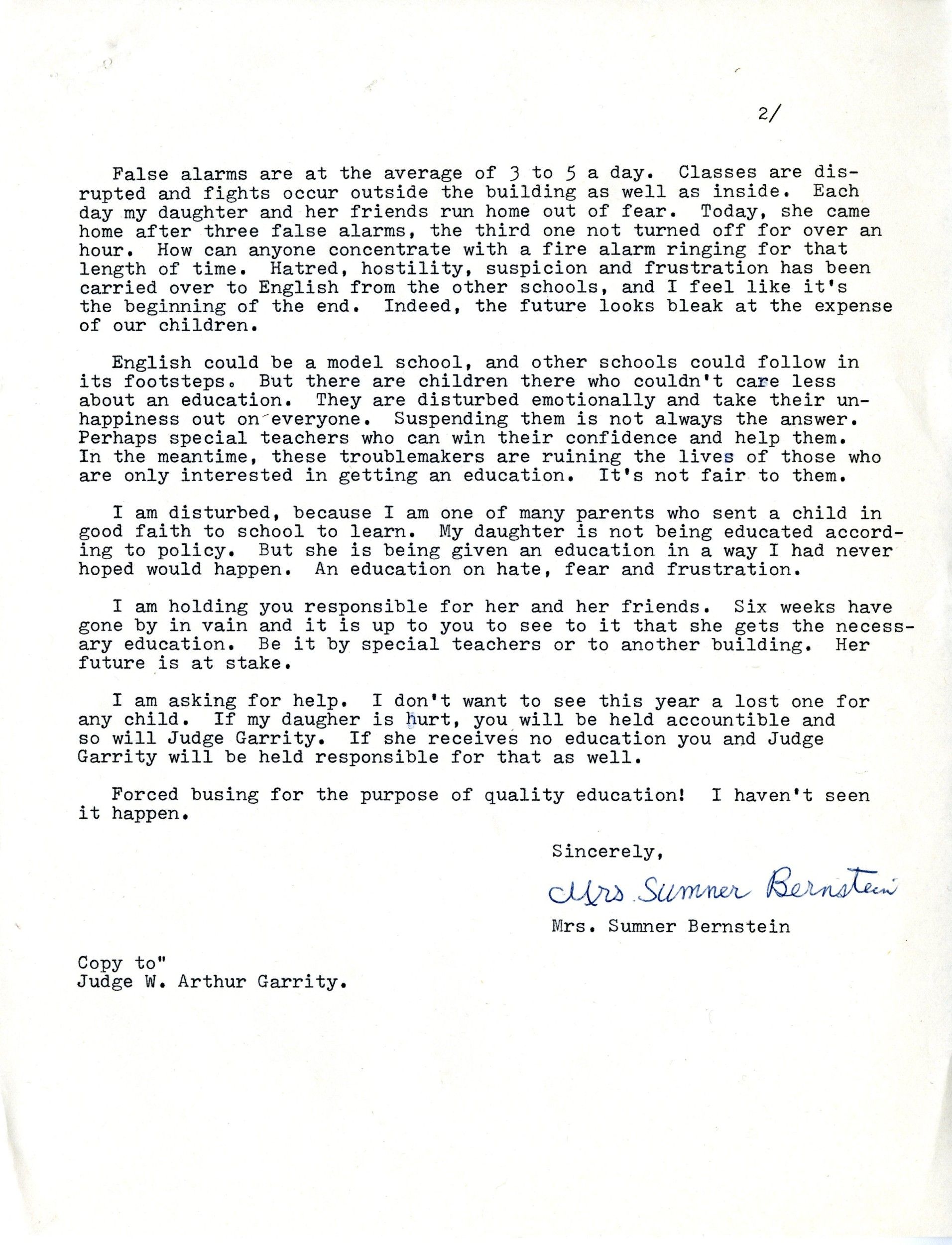
Document
Letter from State Representative Raymond Flynn to Judge W. Arthur Garrity
1/2/1975
This letter from State Representative Raymond Flynn discusses the Boston Police Department's request to close the South Boston High School complex. It comes from the court case Tallulah Morgan et al. v. James W. Hennigan et al., known as the Boston Schools Desegregation Case. In 1972, parents of African American children brought a class action lawsuit alleging that the Boston School Committee violated the 14th Amendment of the U.S. Constitution by a deliberate policy of racial segregation. Judge W. Arthur Garrity, Jr. found that the Boston School Committee had intentionally carried out a program of segregation in the Boston Public Schools. The ruling, upheld unanimously by the U.S. Court of Appeals for the First Circuit, ordered the Boston School Committee to formulate a permanent school desegregation plan that addressed student assignment, teacher employment, and facility improvement procedures, as well as the use of busing on a citywide basis. The Boston School Committee failed to present an adequate plan, so the court assumed an active role in the formulation of the desegregation plan and oversaw implementation of court-ordered desegregation in the Boston public schools. This document was digitized by teachers in our Primarily Teaching 2014 Summer Workshop in Boston.
This primary source comes from the Records of District Courts of the United States.
National Archives Identifier: 12161254
Full Citation: Letter from State Representative Raymond Flynn to Judge W. Arthur Garrity; 1/2/1975; Tallulah Morgan et al v. James W. Hennigan et al Case File, 1972 - 1991; Civil Action Case Files, 1938 - 1998; Records of District Courts of the United States, ; National Archives at Boston, Waltham, MA. [Online Version, https://www.docsteach.org/documents/document/letter-state-representative-flynn-judge-w-arthur-garrity, April 18, 2024]Letter from State Representative Raymond Flynn to Judge W. Arthur Garrity
Page 1
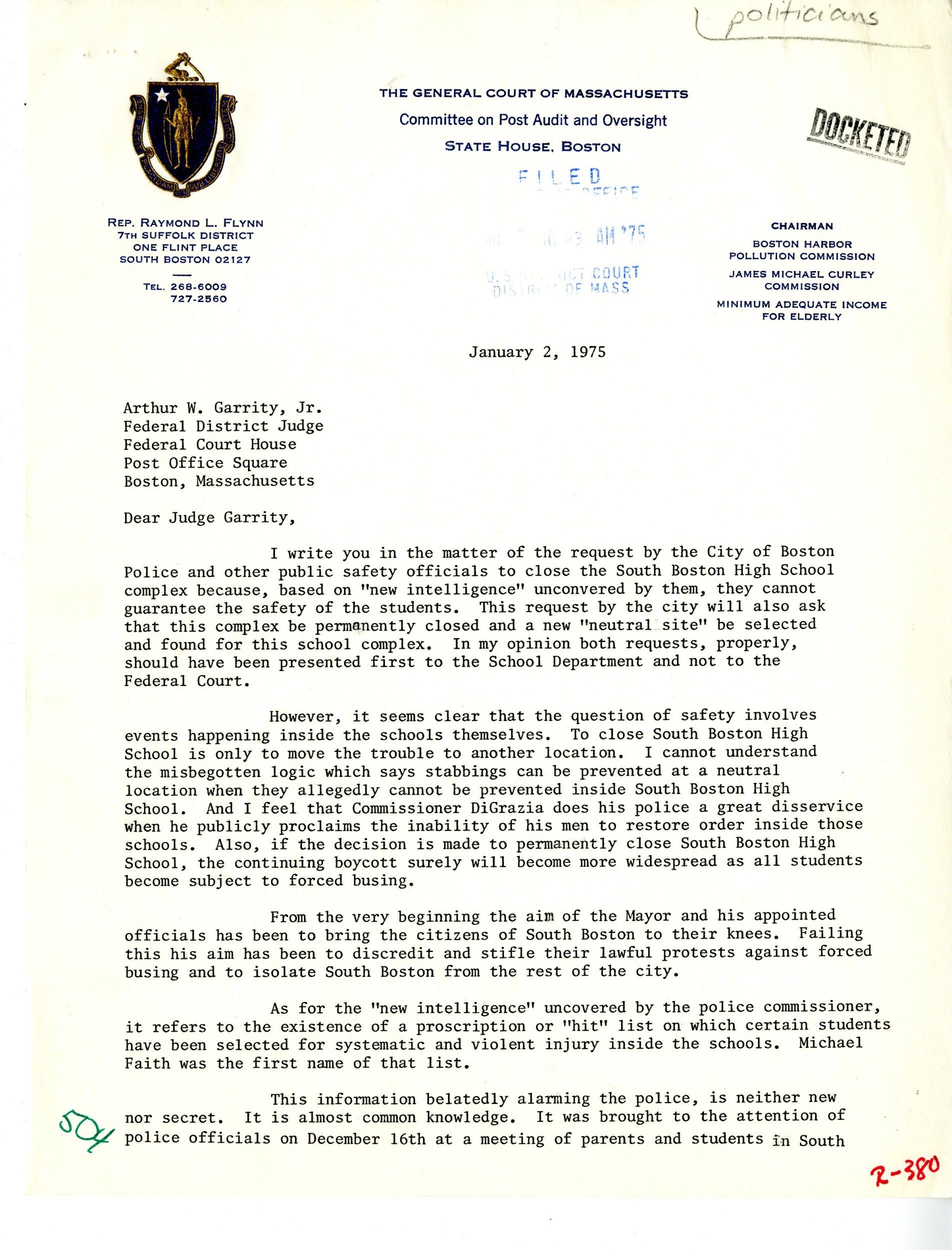
Letter from State Representative Raymond Flynn to Judge W. Arthur Garrity
Page 2
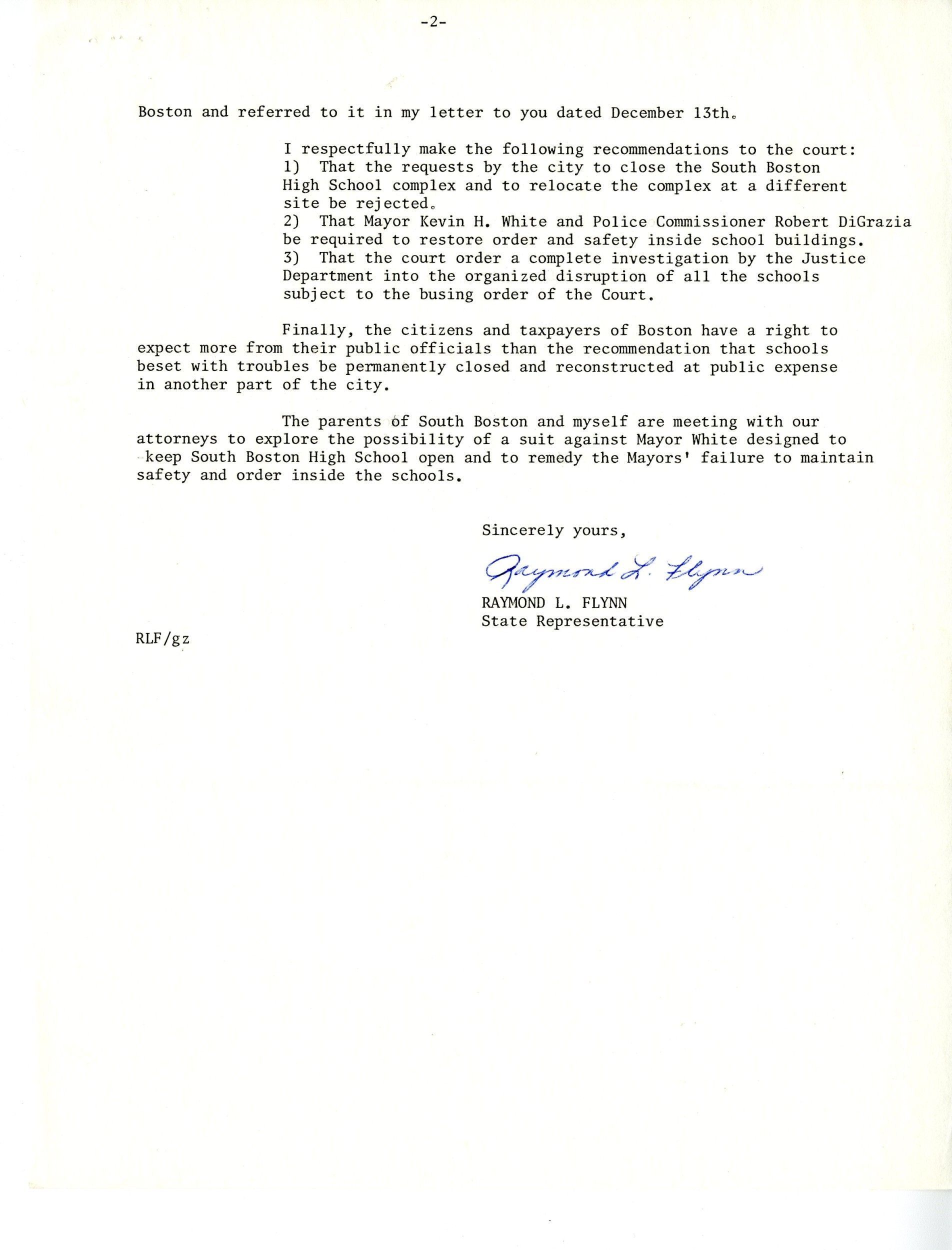
Document
Order of Substitution
6/21/1974
This order from Judge W. Arthur Garrity recognizes the departure of two Boston school officials named in the case and substitutes the names of their successors. It comes from the court case Tallulah Morgan et al. v. James W. Hennigan et al., known as the Boston Schools Desegregation Case. In 1972, parents of African American children brought a class action lawsuit alleging that the Boston School Committee violated the 14th Amendment of the U.S. Constitution by a deliberate policy of racial segregation. Judge W. Arthur Garrity, Jr. found that the Boston School Committee had intentionally carried out a program of segregation in the Boston Public Schools. The ruling, upheld unanimously by the U.S. Court of Appeals for the First Circuit, ordered the Boston School Committee to formulate a permanent school desegregation plan that addressed student assignment, teacher employment, and facility improvement procedures, as well as the use of busing on a citywide basis. The Boston School Committee failed to present an adequate plan, so the court assumed an active role in the formulation of the desegregation plan and oversaw implementation of court-ordered desegregation in the Boston public schools. This document was digitized by teachers in our Primarily Teaching 2014 Summer Workshop in Boston.
This primary source comes from the Records of District Courts of the United States.
National Archives Identifier: 12161239
Full Citation: Order of Substitution; 6/21/1974; Tallulah Morgan et al v. James W. Hennigan et al Case File, 1972 - 1991; Civil Action Case Files, 1938 - 1998; Records of District Courts of the United States, ; National Archives at Boston, Waltham, MA. [Online Version, https://www.docsteach.org/documents/document/order-substitution, April 18, 2024]Order of Substitution
Page 1
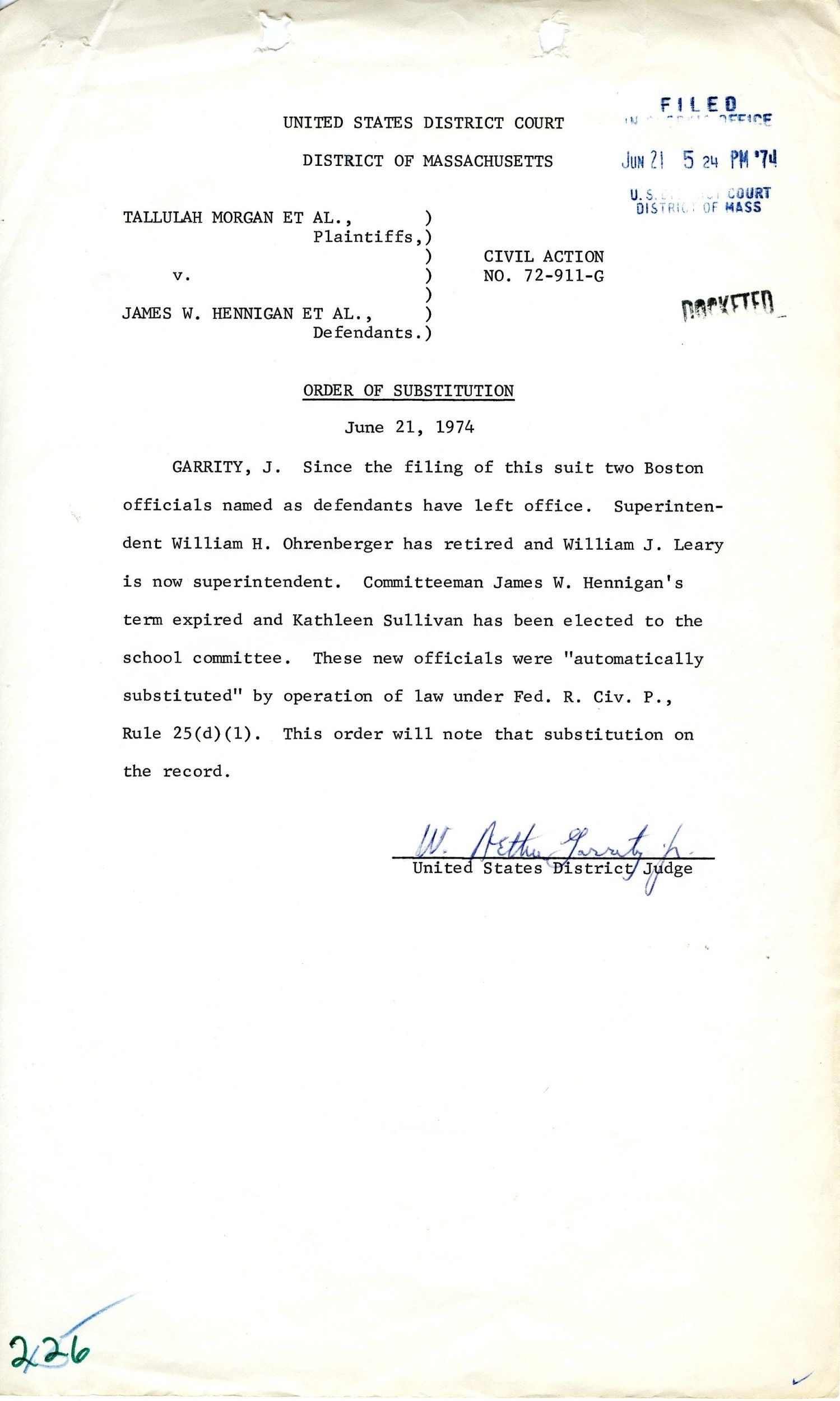
Document
Teachers Union's Request for Discussion of and Reports on Intramural Security, Race And Community Relations
9/23/1974
This request from the Boston Teachers Union asks the court to place on its agenda several topics designed to alleviate racial tensions in Boston Public Schools. It comes from the court case Tallulah Morgan et al. v. James W. Hennigan et al., known as the Boston Schools Desegregation Case. In 1972, parents of African American children brought a class action lawsuit alleging that the Boston School Committee violated the 14th Amendment of the U.S. Constitution by a deliberate policy of racial segregation. Judge W. Arthur Garrity, Jr. found that the Boston School Committee had intentionally carried out a program of segregation in the Boston Public Schools. The ruling, upheld unanimously by the U.S. Court of Appeals for the First Circuit, ordered the Boston School Committee to formulate a permanent school desegregation plan that addressed student assignment, teacher employment, and facility improvement procedures, as well as the use of busing on a citywide basis. The Boston School Committee failed to present an adequate plan, so the court assumed an active role in the formulation of the desegregation plan and oversaw implementation of court-ordered desegregation in the Boston public schools. This document was digitized by teachers in our Primarily Teaching 2014 Summer Workshop in Boston.
This primary source comes from the Records of District Courts of the United States.
National Archives Identifier: 12161232
Full Citation: Teachers Union's Request for Discussion of and Reports on Intramural Security, Race And Community Relations; 9/23/1974; Tallulah Morgan et al v. James W. Hennigan et al Case File, 1972 - 1991; Civil Action Case Files, 1938 - 1998; Records of District Courts of the United States, . [Online Version, https://www.docsteach.org/documents/document/teachers-unions-request-for-discussion-of-and-reports-on-intramural-security-race-and-community-relations, April 18, 2024]Teachers Union's Request for Discussion of and Reports on Intramural Security, Race And Community Relations
Page 1

Teachers Union's Request for Discussion of and Reports on Intramural Security, Race And Community Relations
Page 2
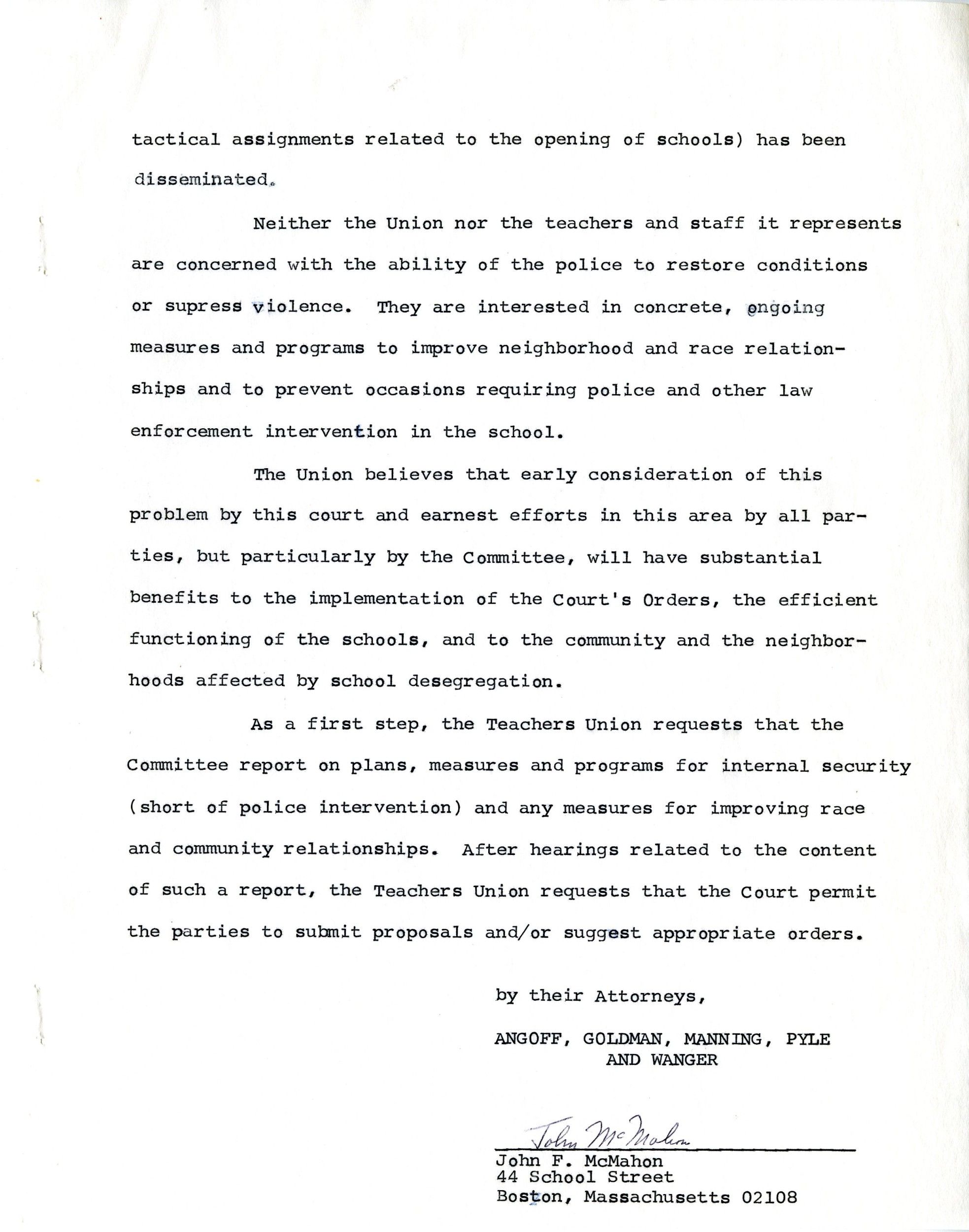
Teachers Union's Request for Discussion of and Reports on Intramural Security, Race And Community Relations
Page 3
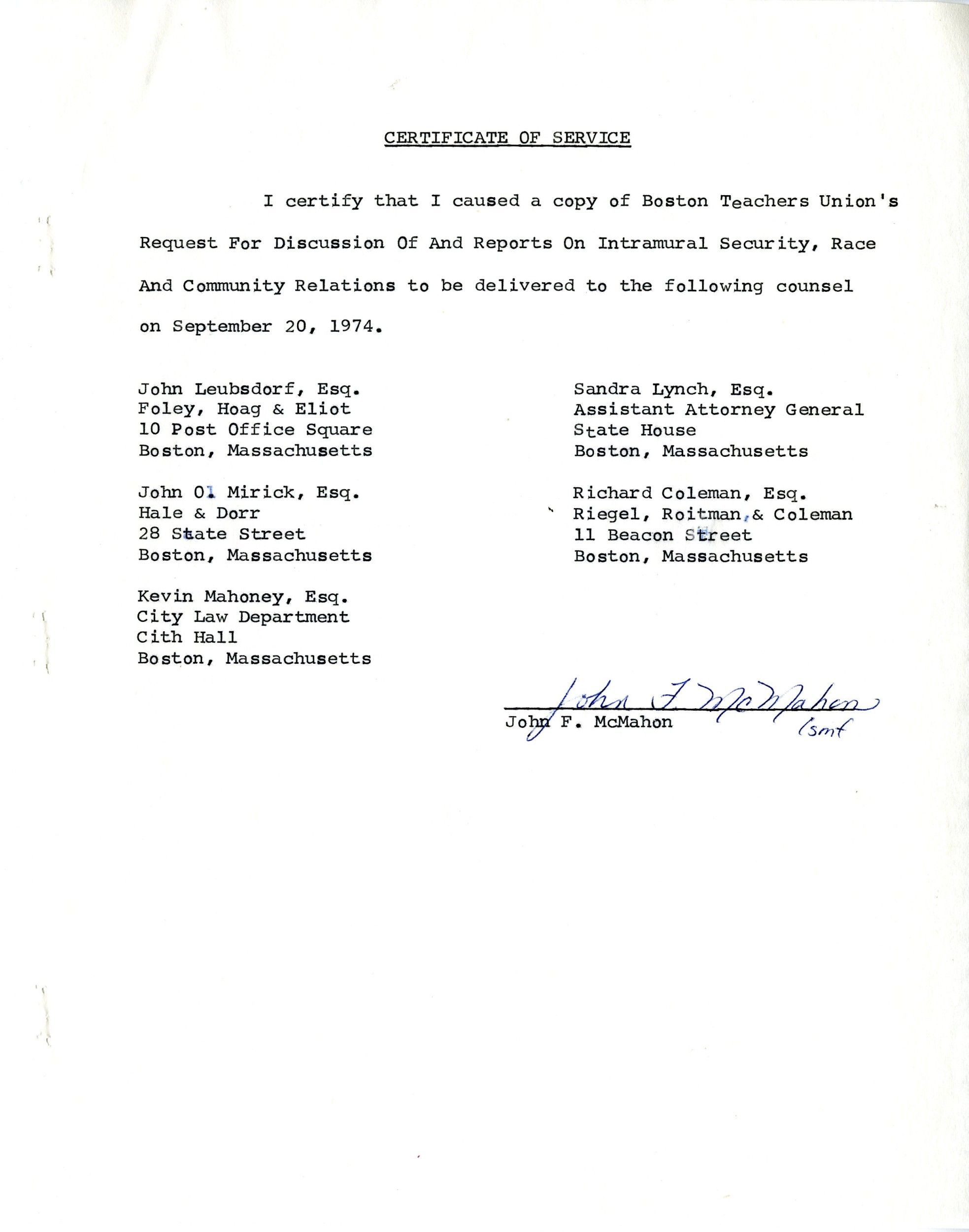
Document
Letter of Parents of the Bancroft Rice School to Judge Arthur Garrity Responding to Phase II of the School Desegregation Plan
1/20/1975
This document comes from the court case Tallulah Morgan et al. v. James W. Hennigan et al., known as the Boston Schools Desegregation Case. In 1972, parents of African American children brought a class action lawsuit alleging that the Boston School Committee violated the 14th Amendment of the U.S. Constitution by a deliberate policy of racial segregation. Judge W. Arthur Garrity, Jr. found that the Boston School Committee had intentionally carried out a program of segregation in the Boston Public Schools. The ruling, upheld unanimously by the U.S. Court of Appeals for the First Circuit, ordered the Boston School Committee to formulate a permanent school desegregation plan that addressed student assignment, teacher employment, and facility improvement procedures, as well as the use of busing on a citywide basis. The Boston School Committee failed to present an adequate plan, so the court assumed an active role in the formulation of the desegregation plan and oversaw implementation of court-ordered desegregation in the Boston public schools. This document was digitized by teachers in our Primarily Teaching 2014 Summer Workshop in Boston.
This primary source comes from the Records of District Courts of the United States.
National Archives Identifier: 12161217
Full Citation: Letter of Parents of the Bancroft Rice School to Judge Arthur Garrity Responding to Phase II of the School Desegregation Plan; 1/20/1975; Tallulah Morgan et al v. James W. Hennigan et al Case File, 1972 - 1991; Civil Action Case Files, 1938 - 1998; Records of District Courts of the United States, ; National Archives at Boston, Waltham, MA. [Online Version, https://www.docsteach.org/documents/document/letter-responding-phase-ii-school-desegregation-plan, April 18, 2024]Letter of Parents of the Bancroft Rice School to Judge Arthur Garrity Responding to Phase II of the School Desegregation Plan
Page 1

Letter of Parents of the Bancroft Rice School to Judge Arthur Garrity Responding to Phase II of the School Desegregation Plan
Page 2

Letter of Parents of the Bancroft Rice School to Judge Arthur Garrity Responding to Phase II of the School Desegregation Plan
Page 3
